The Cove – The Lots – Woodwell – Heald Brow – Clark’s Lot – Silverdale Green – Burtonwell Wood – Lambert’s Meadow – The Row – Eaves Wood – Castlebarrow
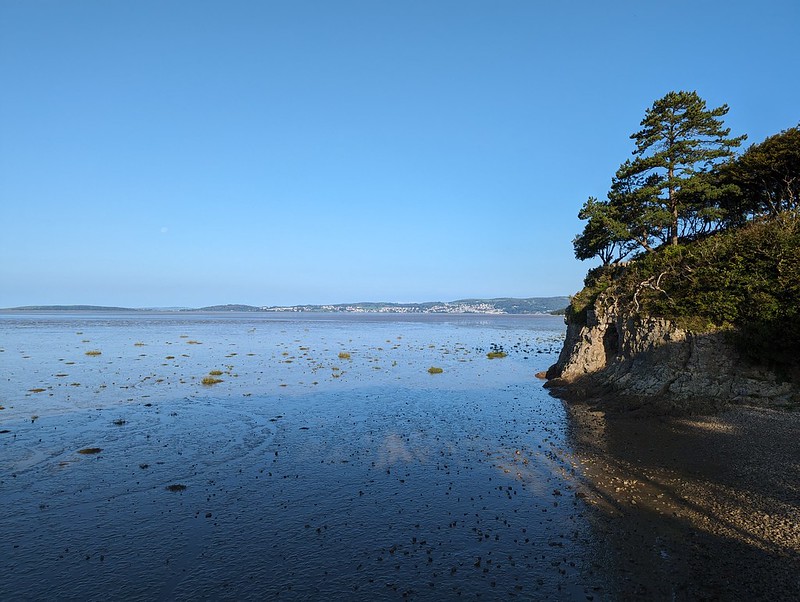
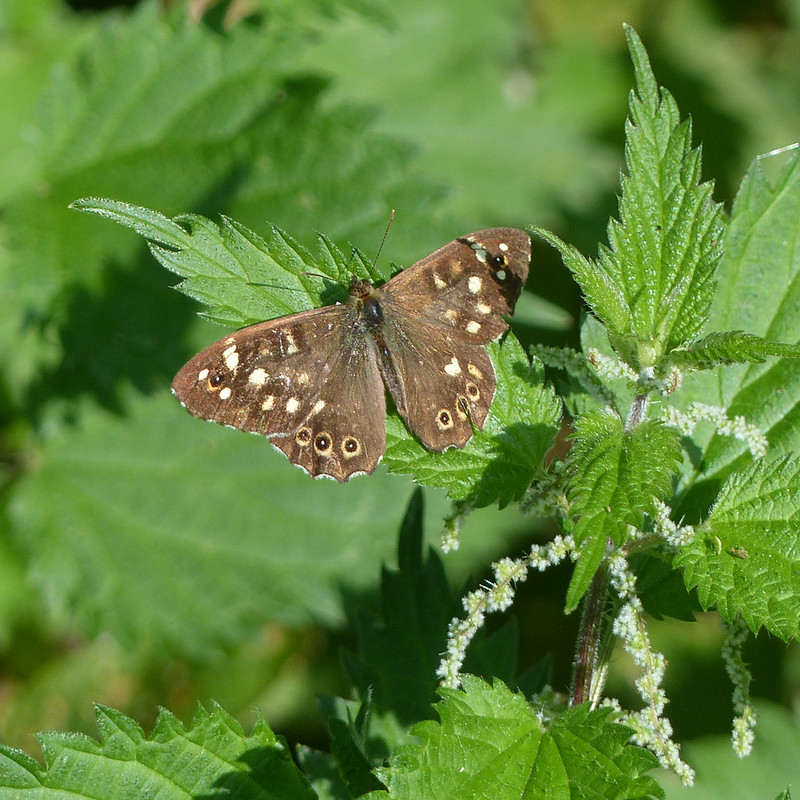
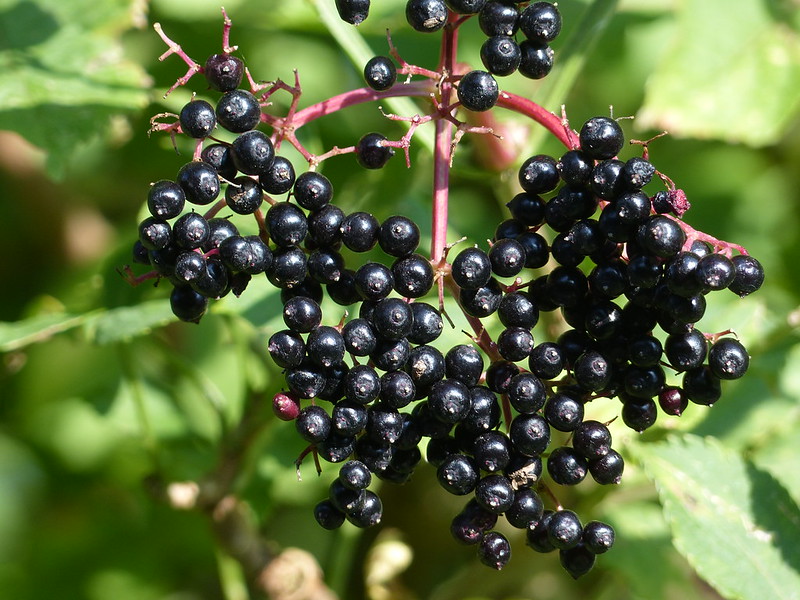
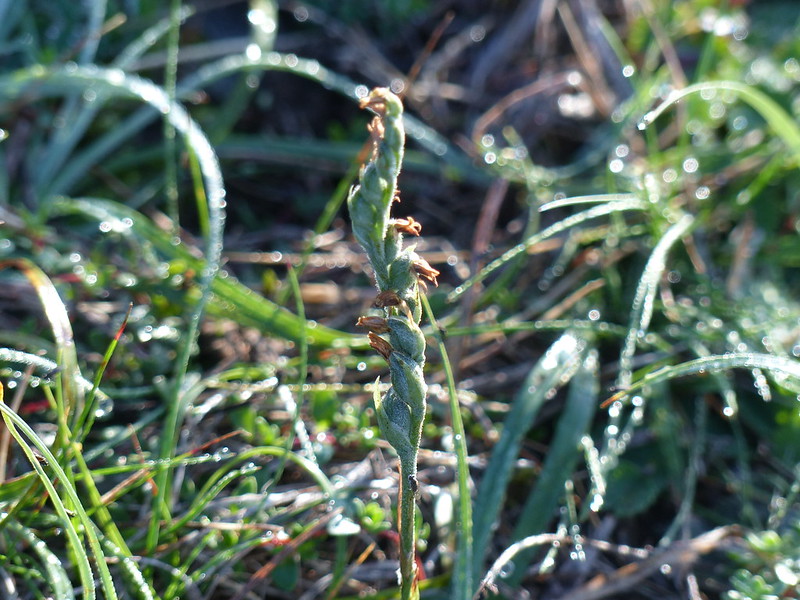
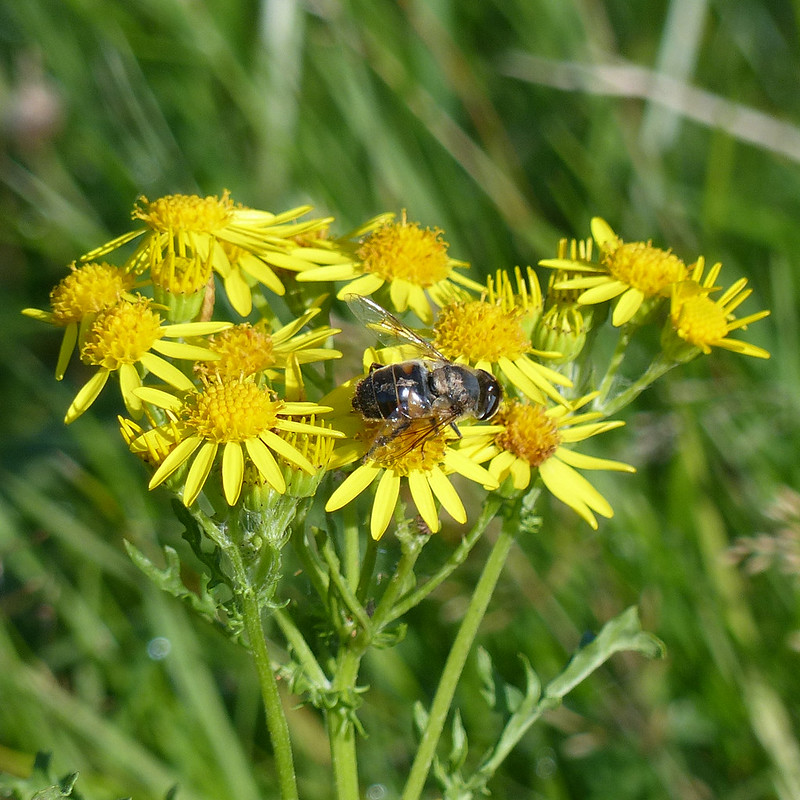
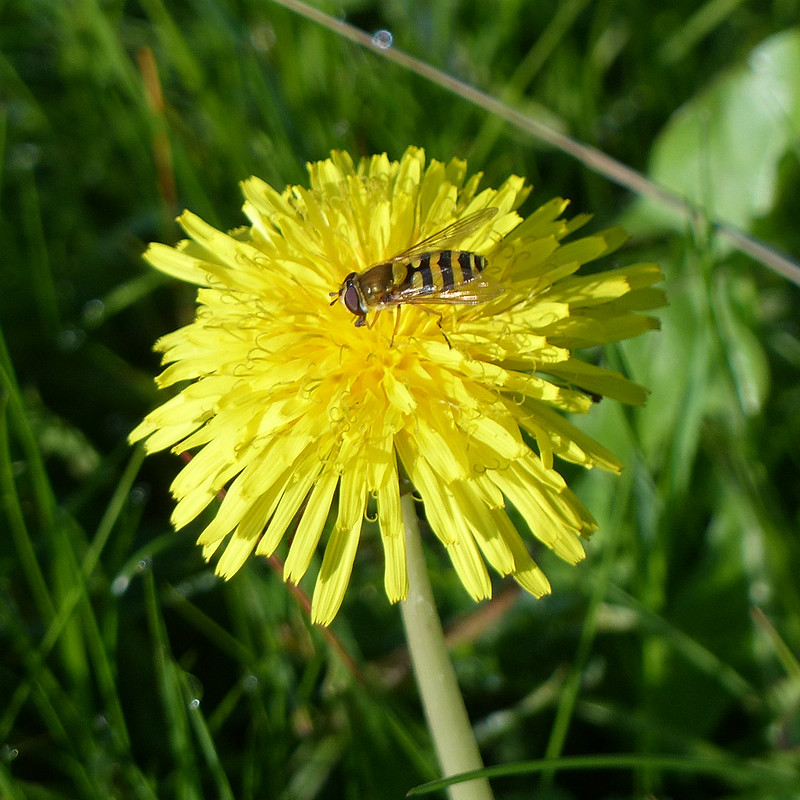
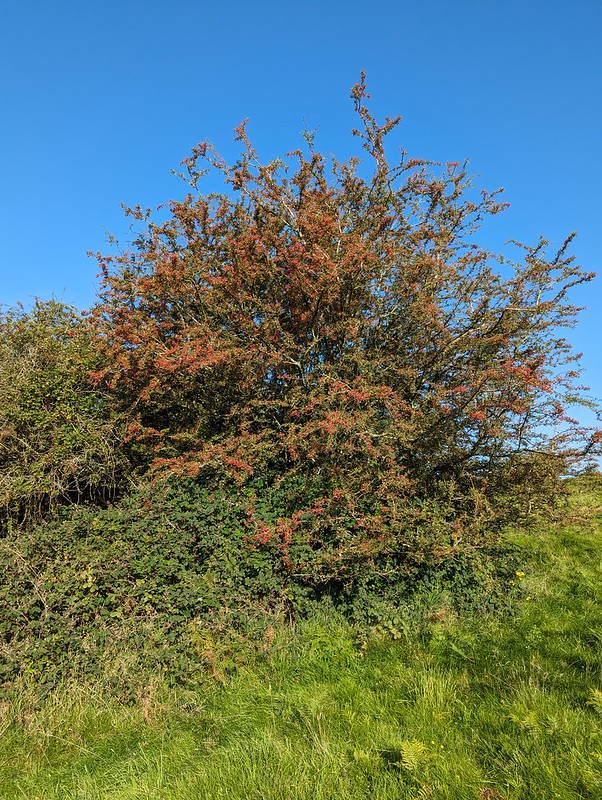
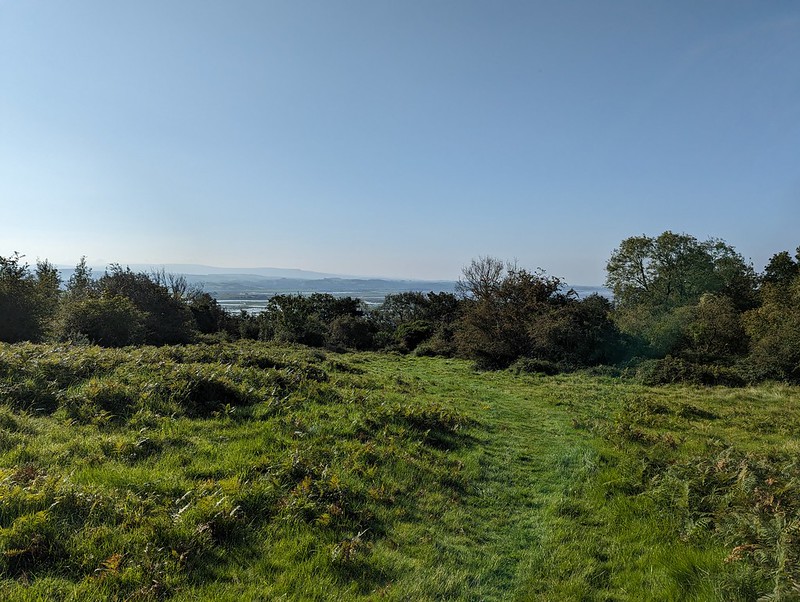
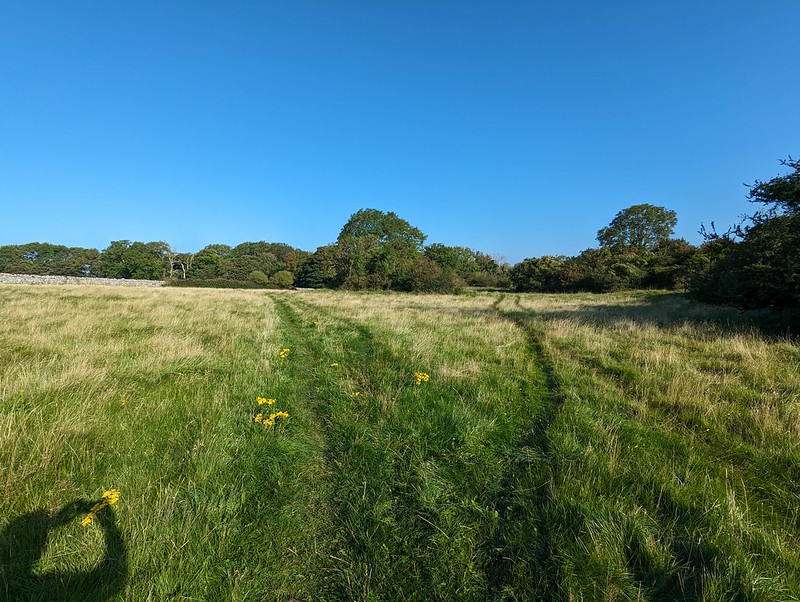

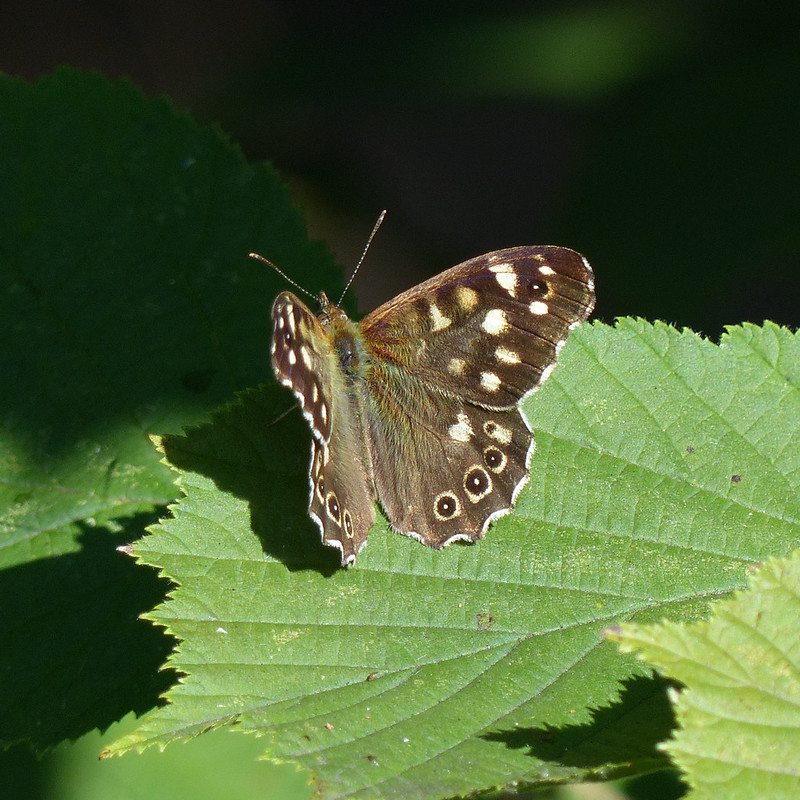
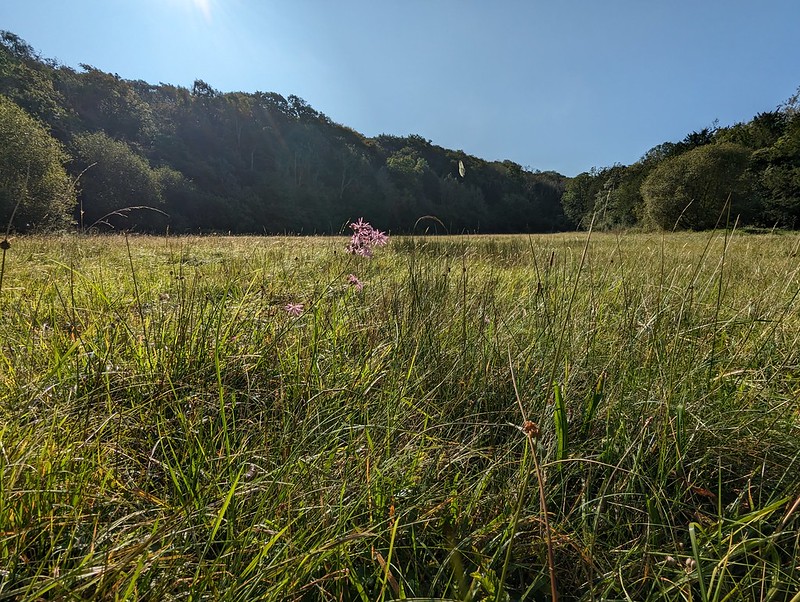

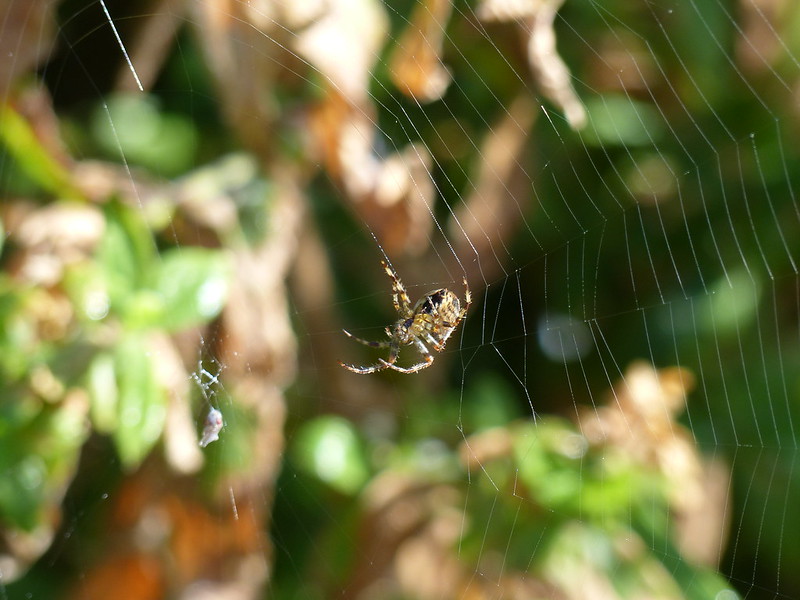

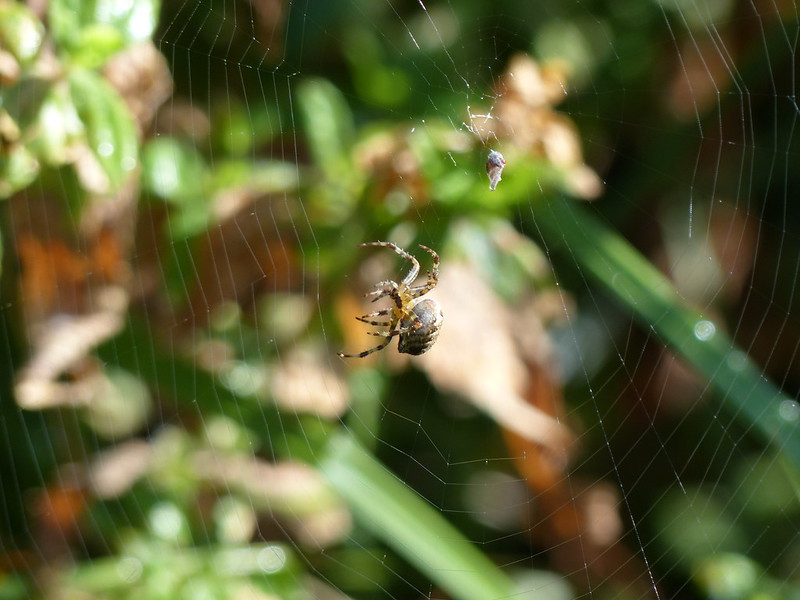
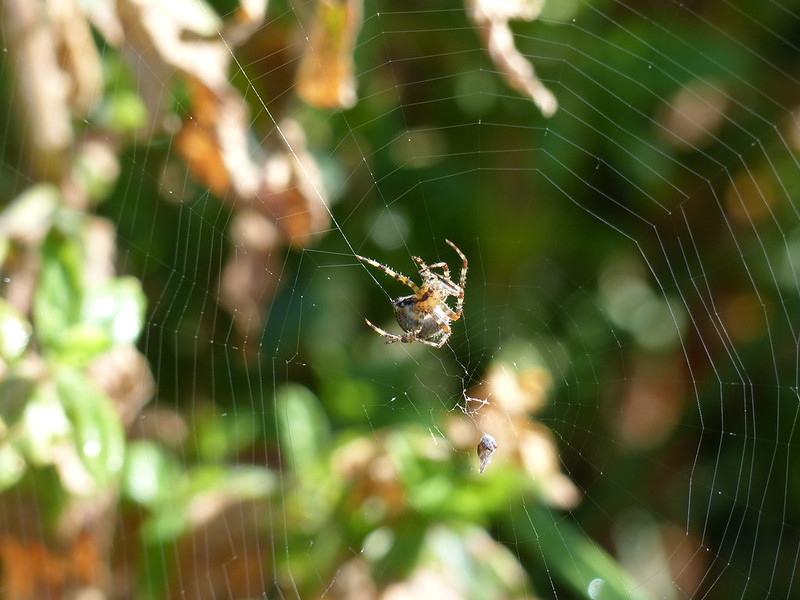

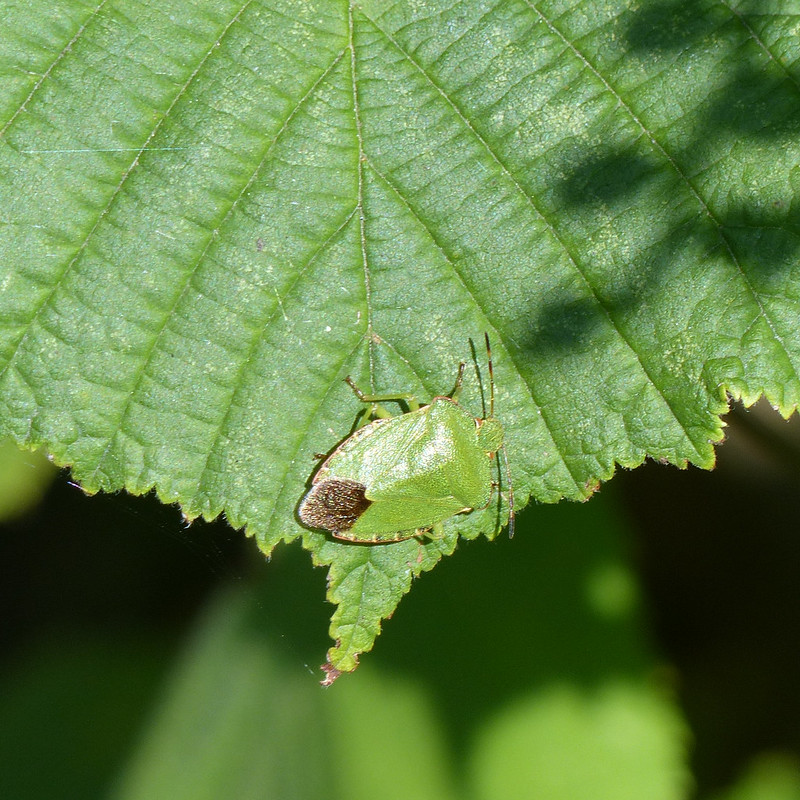
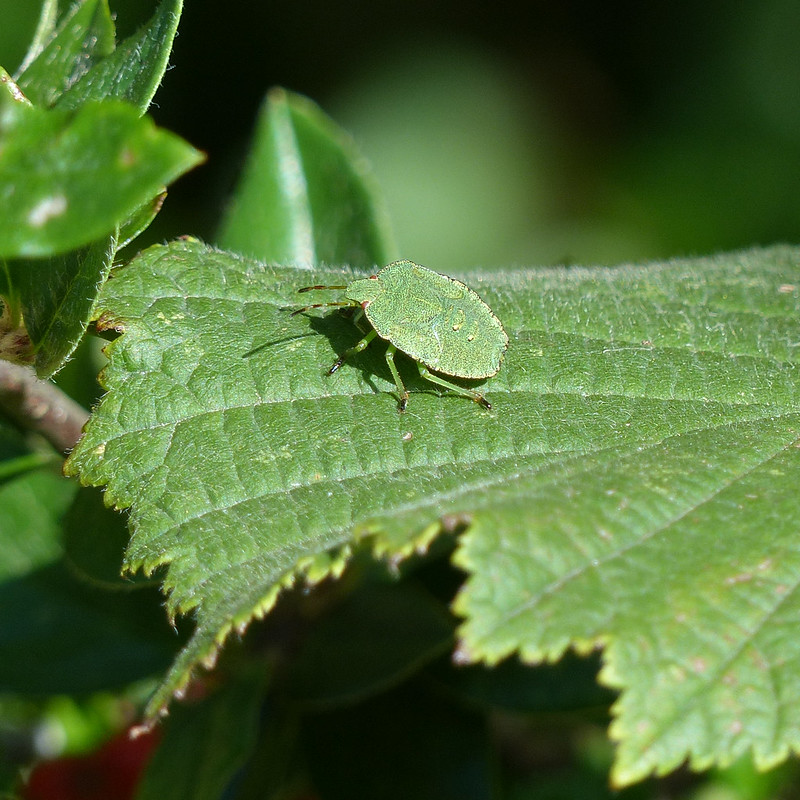
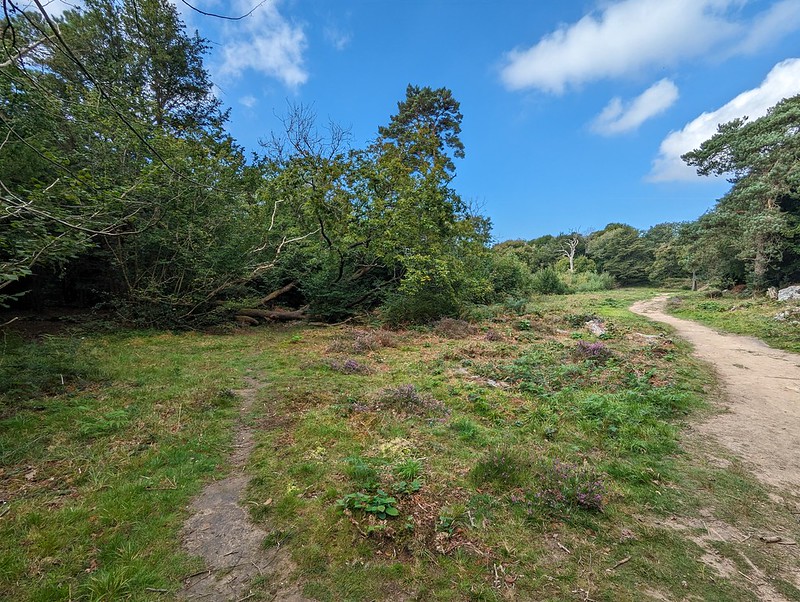
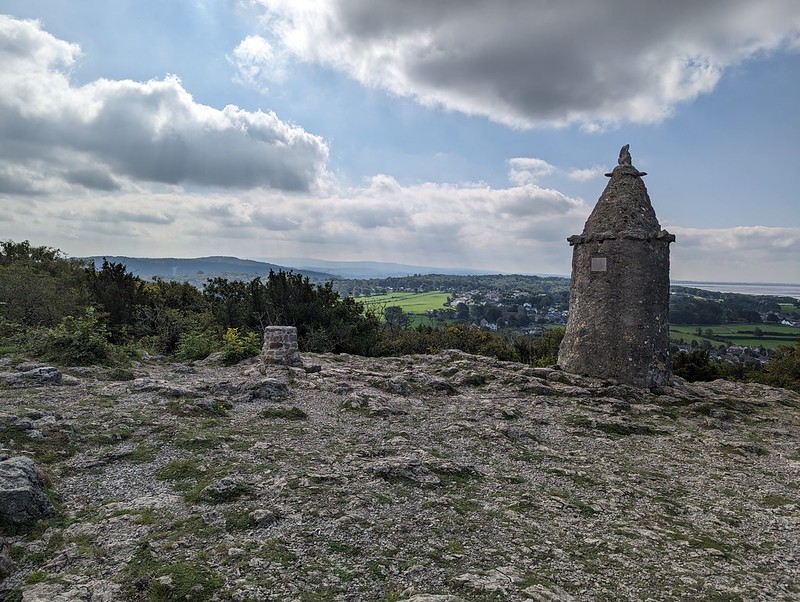
The Cove – The Lots – Woodwell – Heald Brow – Clark’s Lot – Silverdale Green – Burtonwell Wood – Lambert’s Meadow – The Row – Eaves Wood – Castlebarrow























Still, if the weather’s showery, how handy to have Lambert’s Meadow on the doorstep for between the squalls.

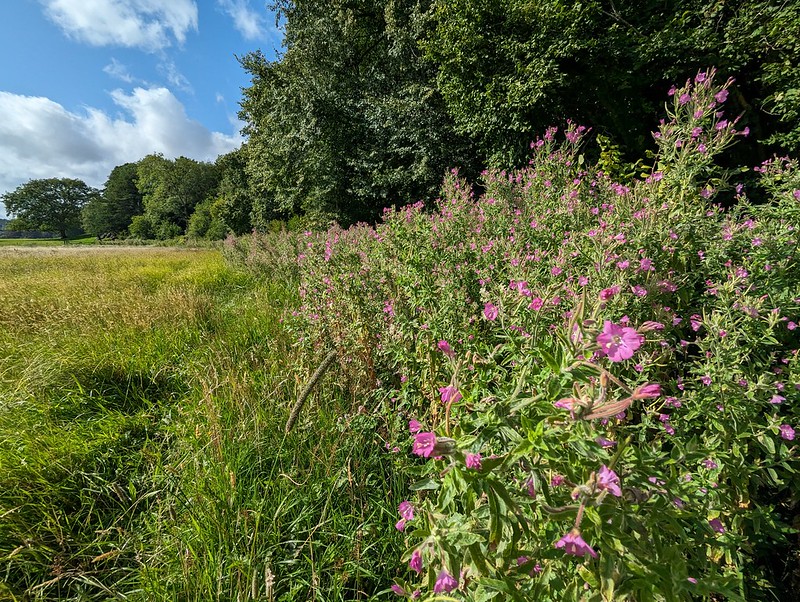


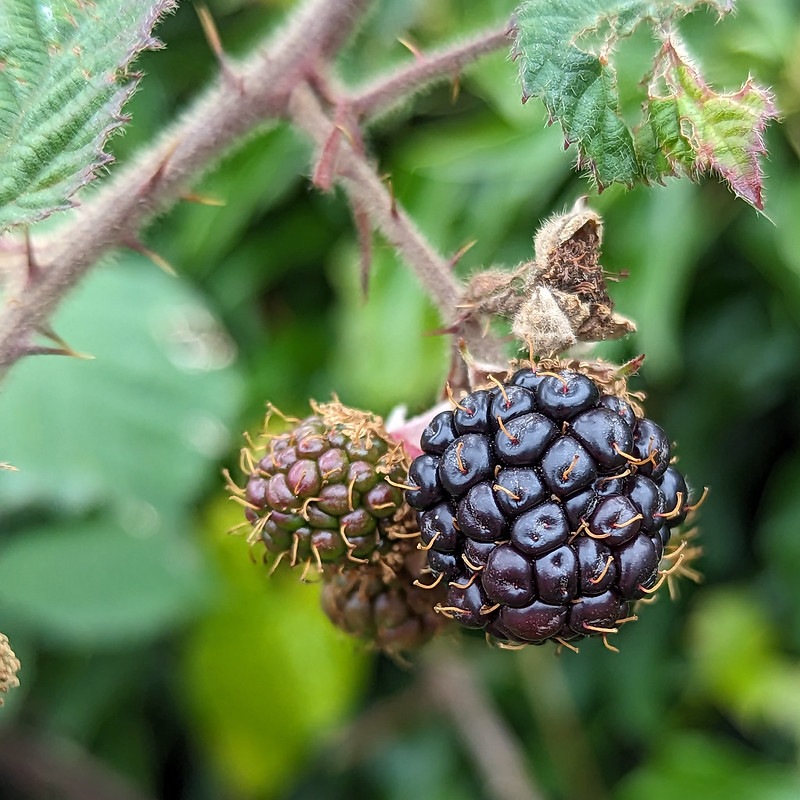
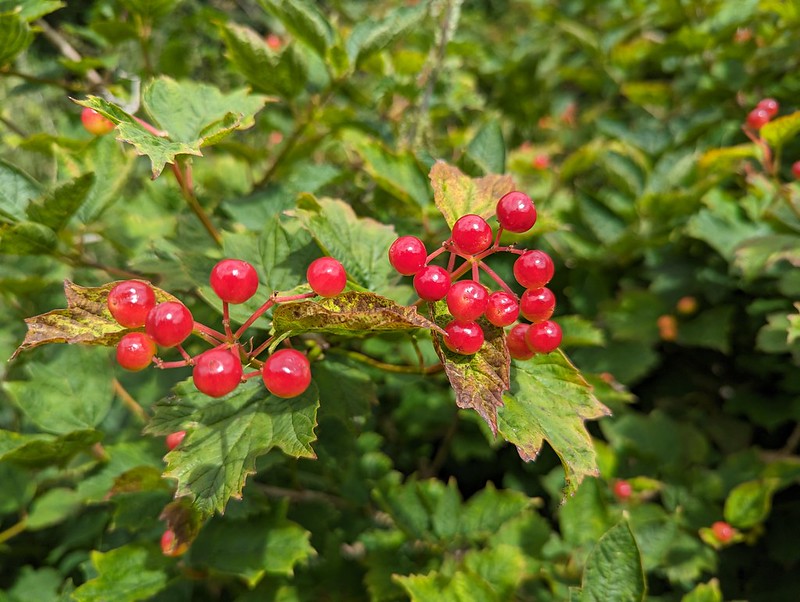
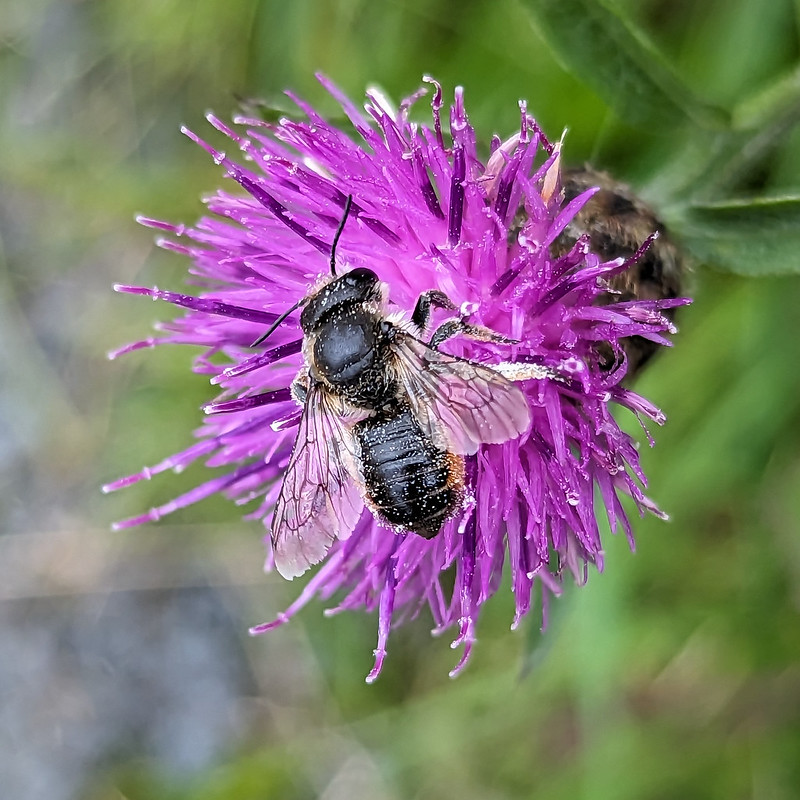
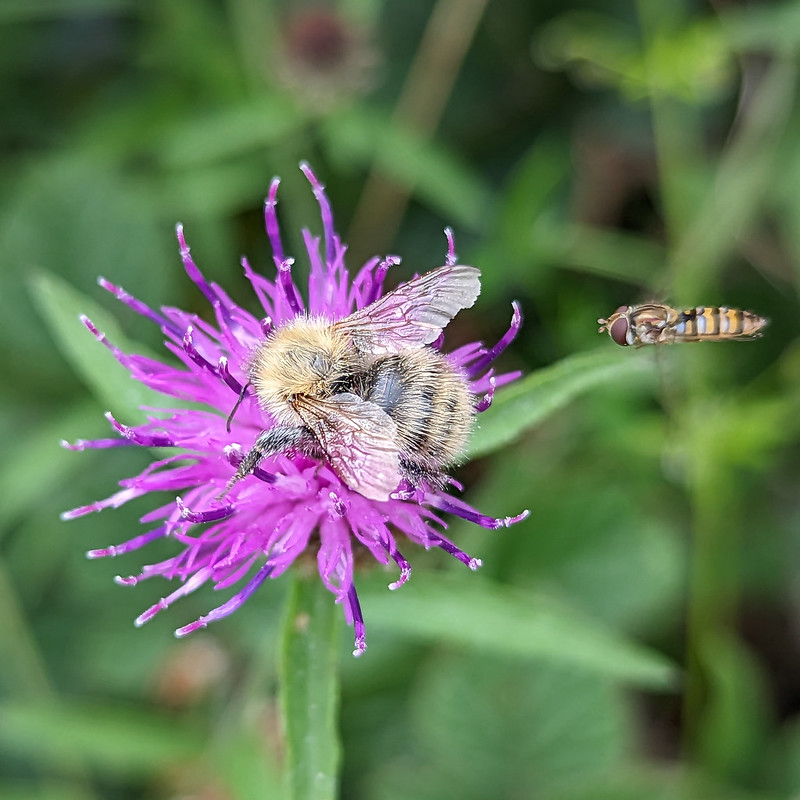
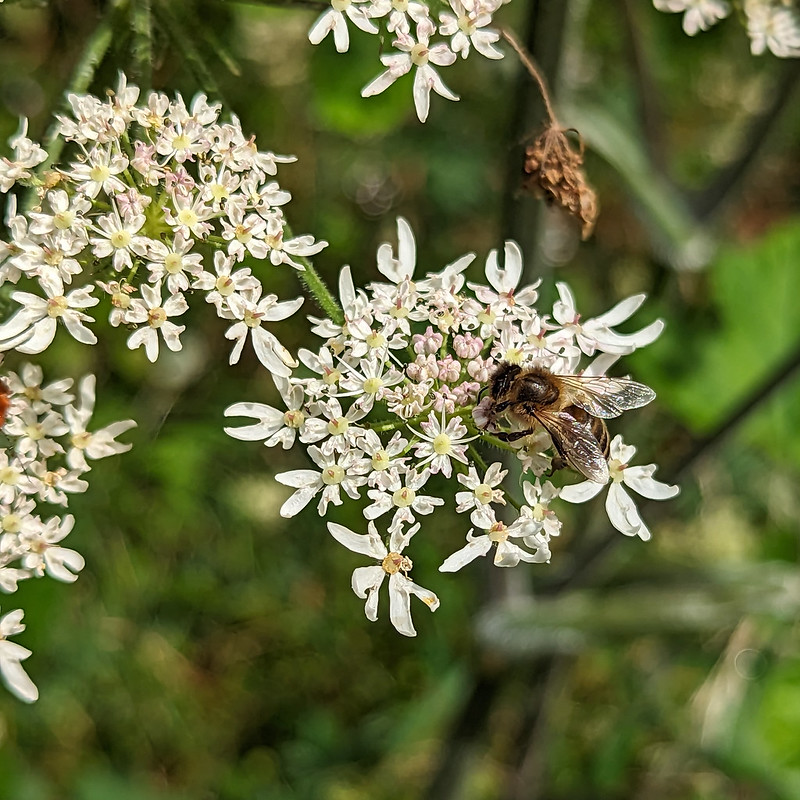


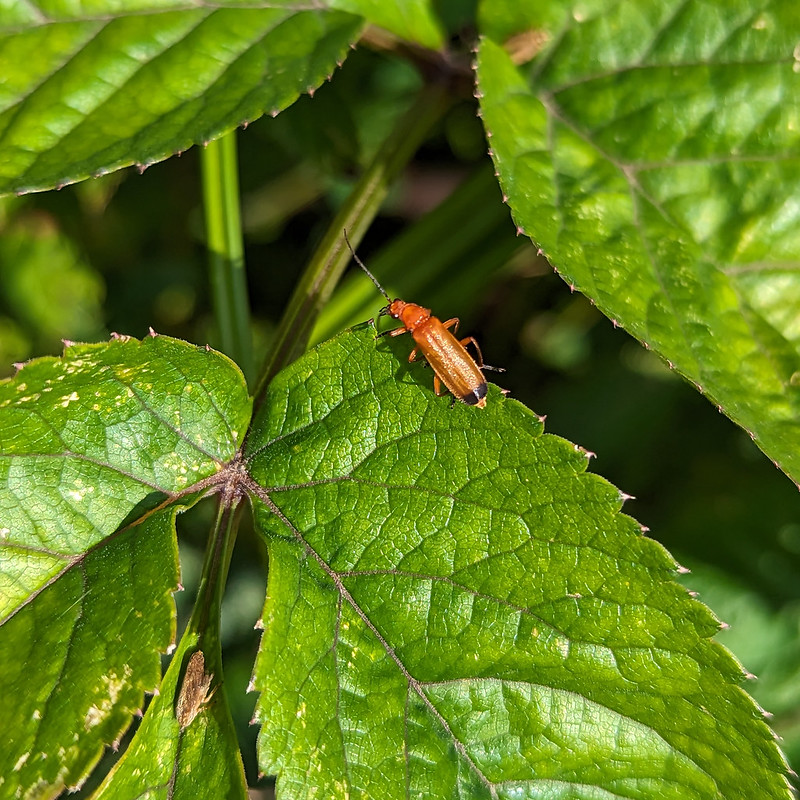
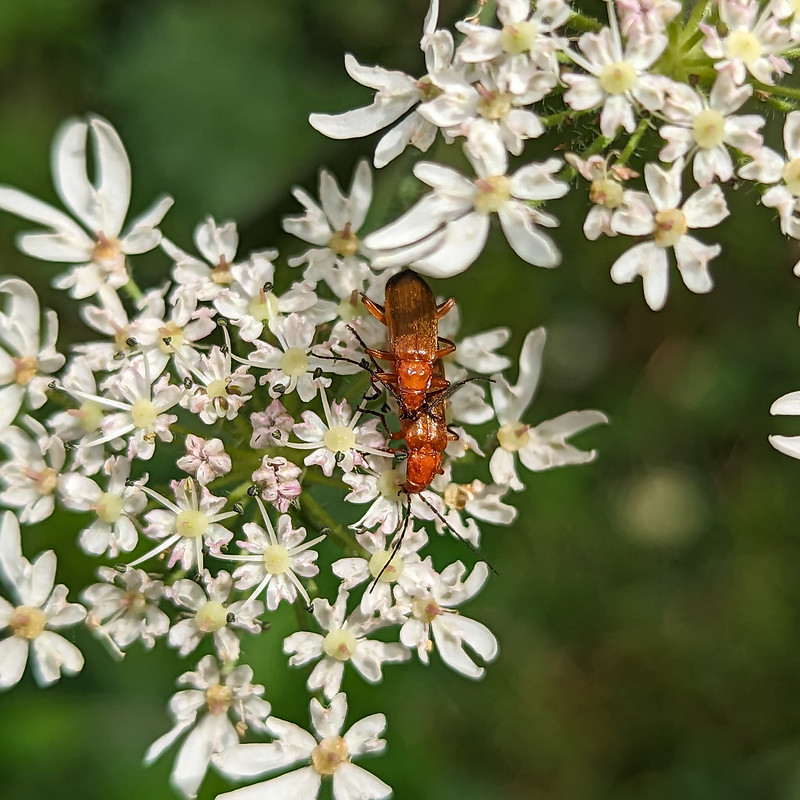
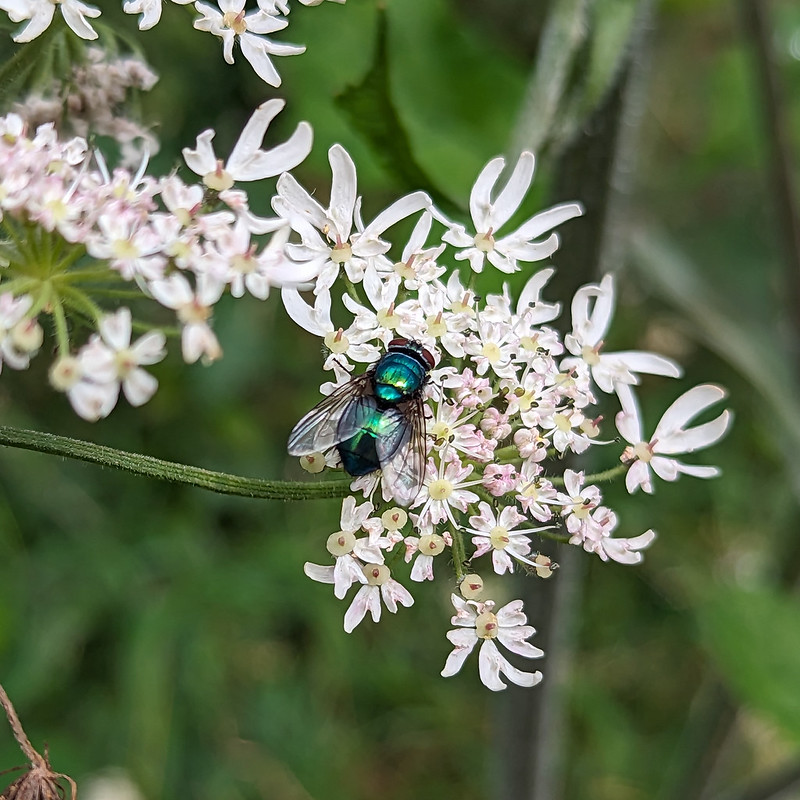
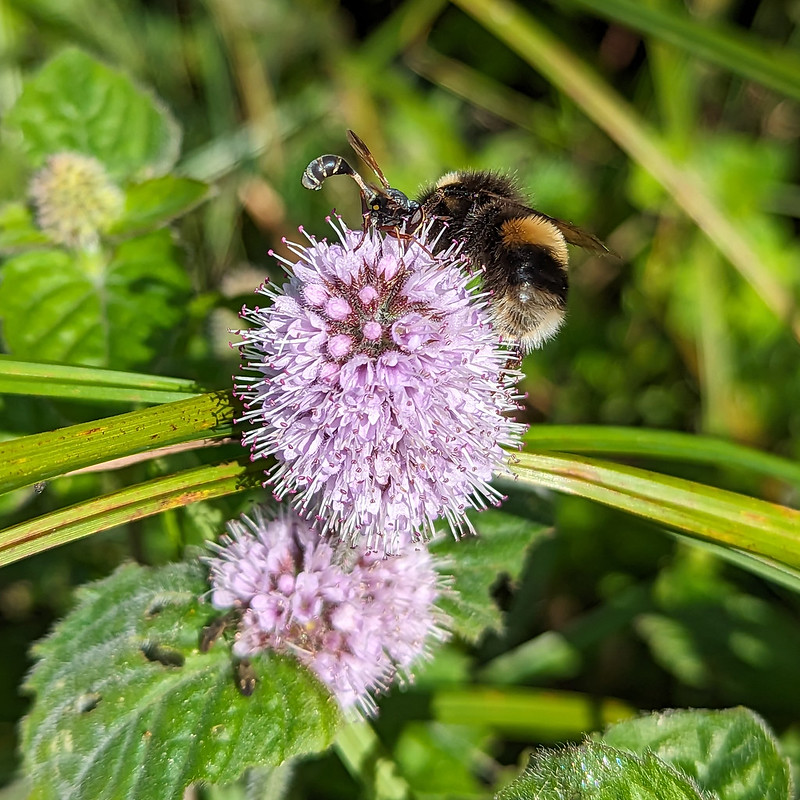
This odd looking fly, with its narrow wasp-waist and the bulbous end to its abdomen, was a new species to me.

Apparently this small hoverfly might be the most widespread and most numerous species of hoverfly in the UK.
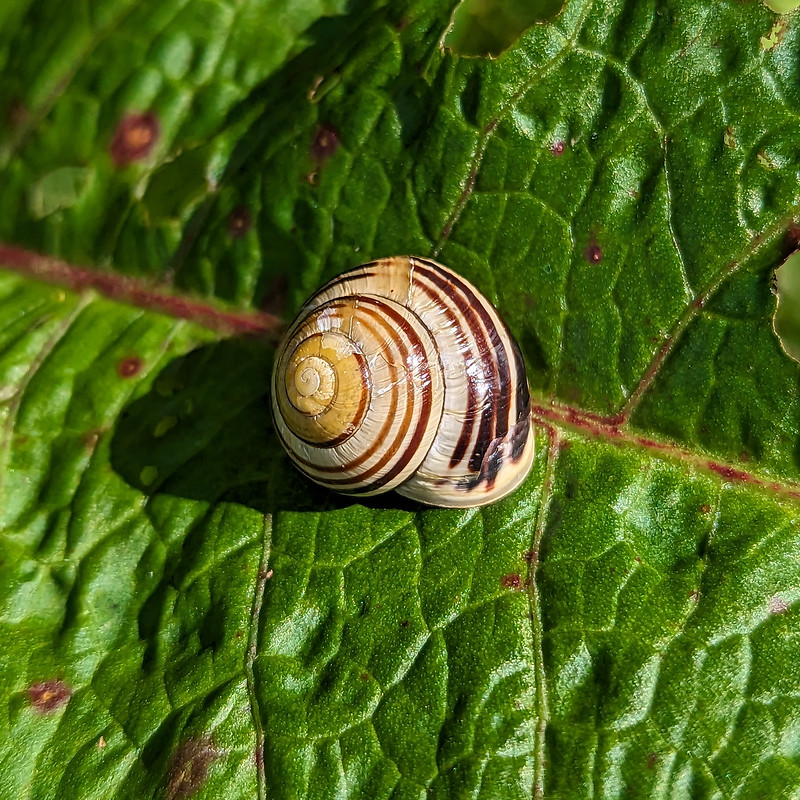
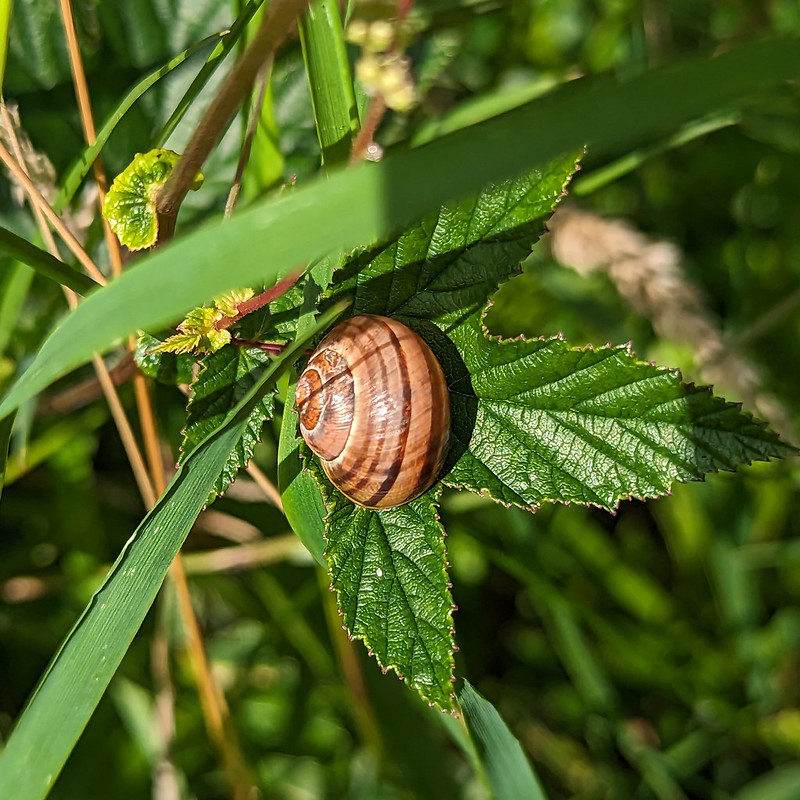
I’d managed to go out without my camera, or possibly with my camera but either no charge or no memory card. Either way, these photos were all taken with my phone, hence the lack of damselflies, dragonflies and butterflies, none of which would tolerate me getting close enough with my phone to get a decent photo.
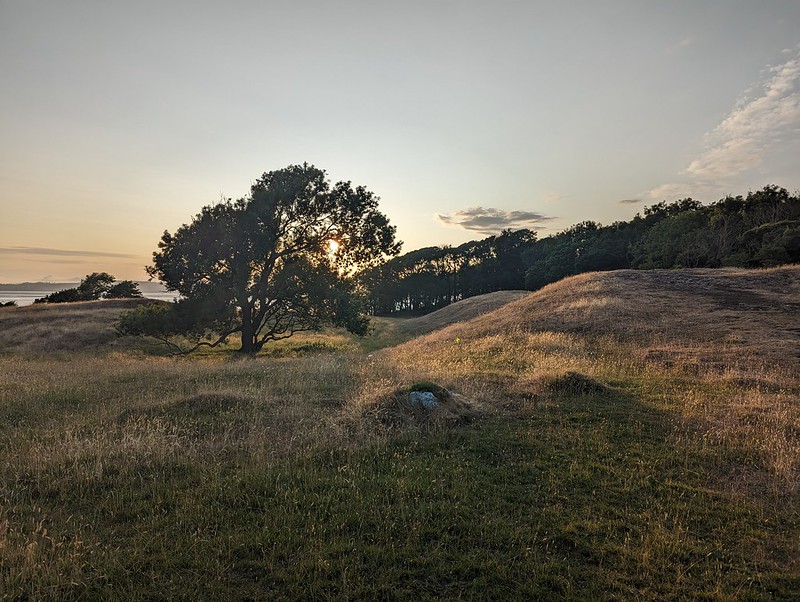
Back to June – some photos from three midweek walks and then some from the Saturday of the areas annual Art Trail.
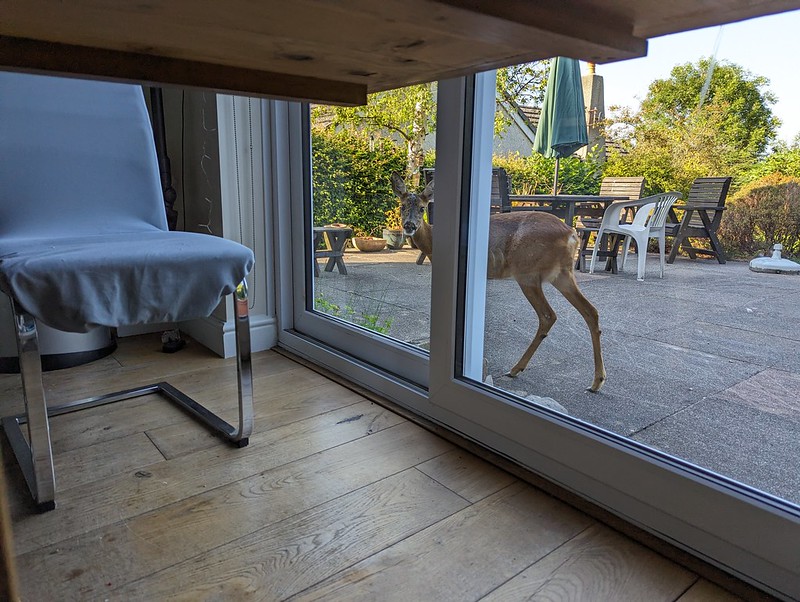
This was when the weather was still hot and dry and summer like and blue skies abounded.




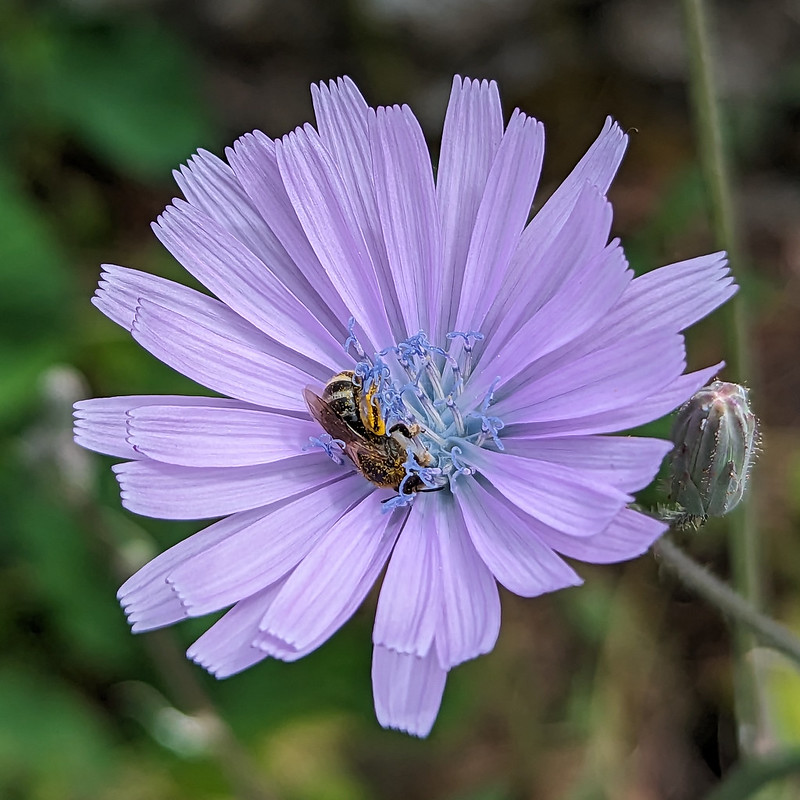

Our friend J and her daughter E came for the weekend, as they usually do for the Art Trail, and I managed to take absolutely no photos of them, not even a single one, as I usually do when in company. Actually, that’s poor, even by my own low standard.

Much more important to record what Cuckoo Pint berries look like, obviously.
I also didn’t take any photos of the many art venues we visited, except, that is for The Mawson Garden.

It’s always a treat to visit, and even better this time since we bumped into a very old friend there and had a good natter too. (No photo, of course.)
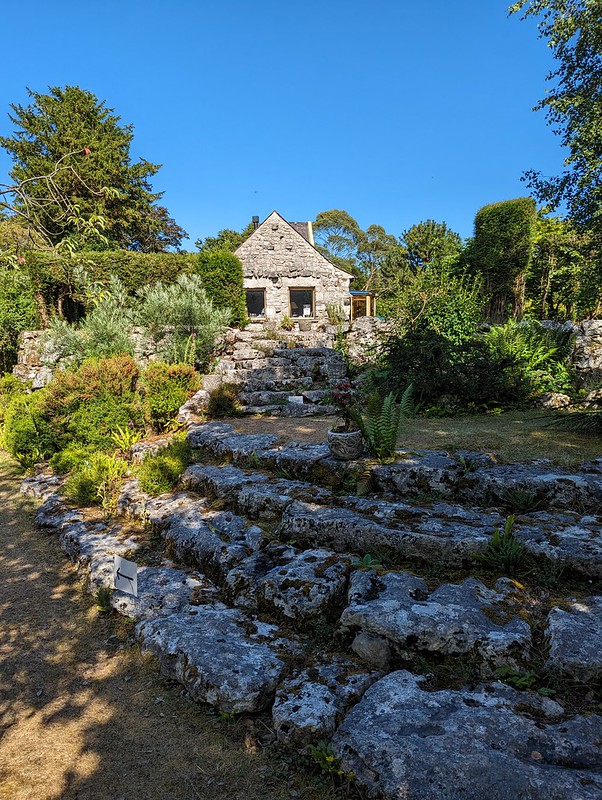
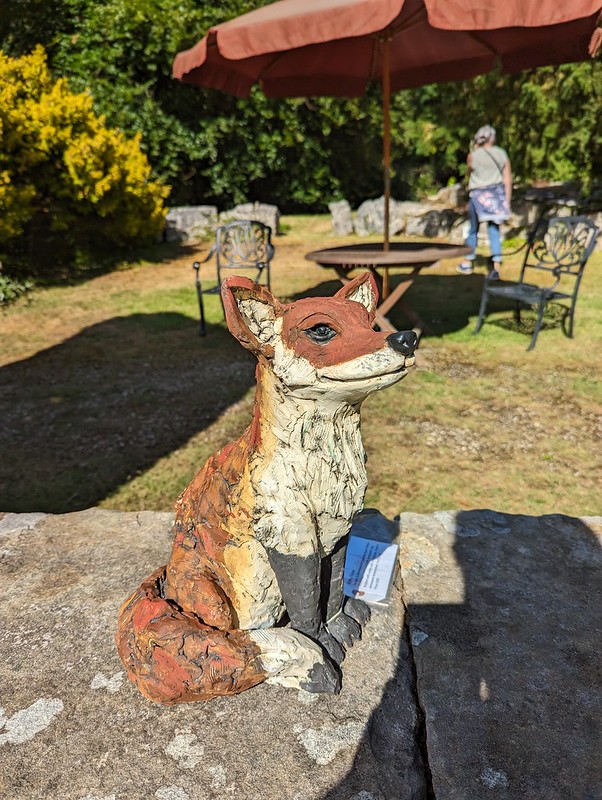
I don’t generally take photos of the art work – even the things I really take a shine too – unless the art work is sculpture or ceramics. It’s acceptable to photograph 3D art apparently, in my warped view of the world at least.
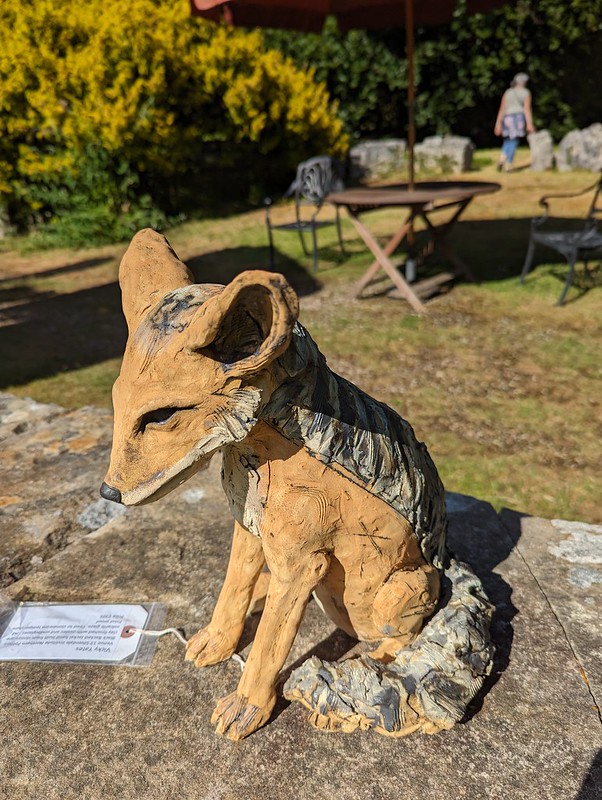
We were all charmed by the Fox and the Jackal. The latter seems to still be available, at the time of writing, on the artist’s website.
There was a large Mullein flowering in the garden, so I felt duty bound to see whether it had any Mullein Moth caterpillars – I found one, and a ladybird and this…


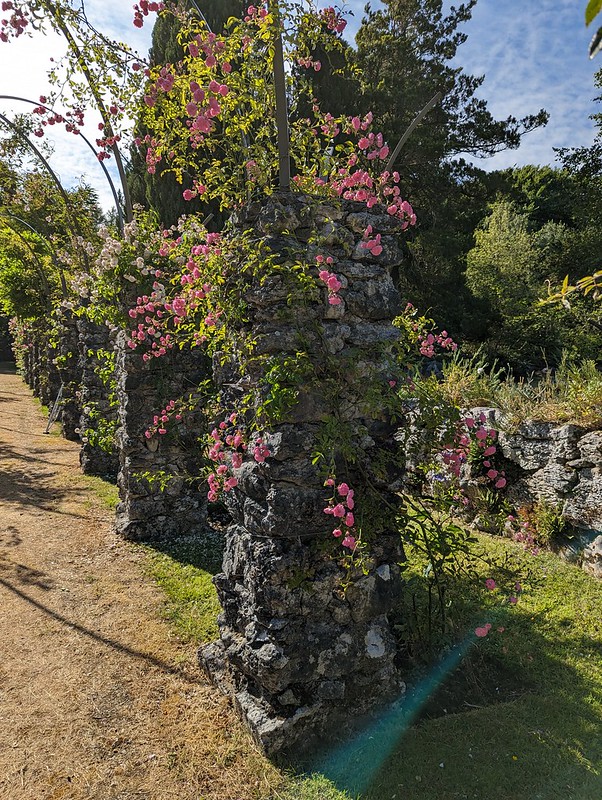



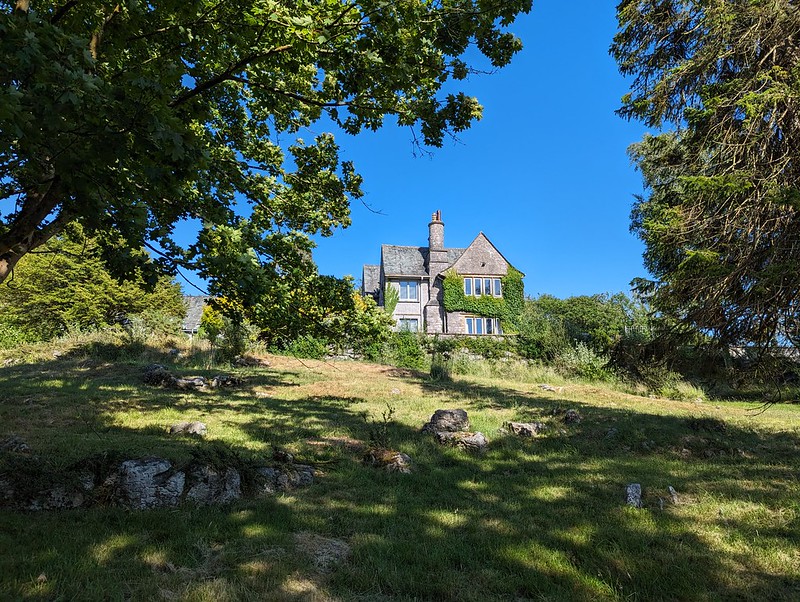
The Art Trail happens on the last weekend in June every summer and is well worth a visit – doubly so now that the Mawson Garden has been open to the public each year.
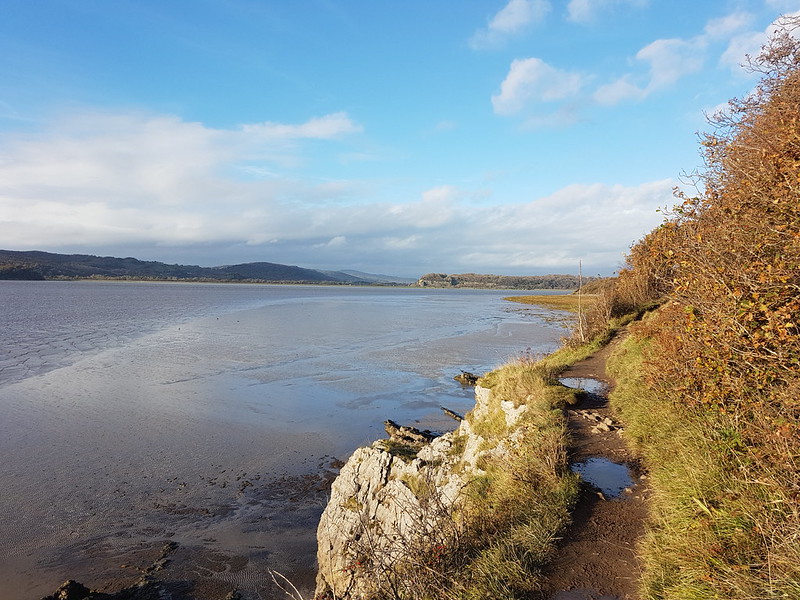
The final day of October half-term, and for reasons I can’t remember, I only set-off for my favourite stroll around the coast to Arnside and back over the Knott at around three in the afternoon.

When I moved to the area, around thirty years ago, there was no salt-marsh at White Creek and none at Grange either, but you could walk on the grass from Knowe Point to Far Arnside. Now the situation is reversed, testament to the way the river channel changes and so keeps the Bay in constant flux.

Likewise, thirty years ago, I wouldn’t have expected to see any Little Egrets in the area, but now they are relatively common, and Great Egrets are also beginning to establish themselves.
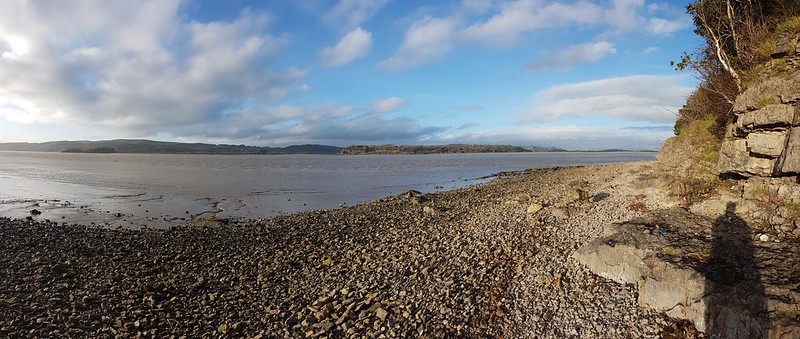
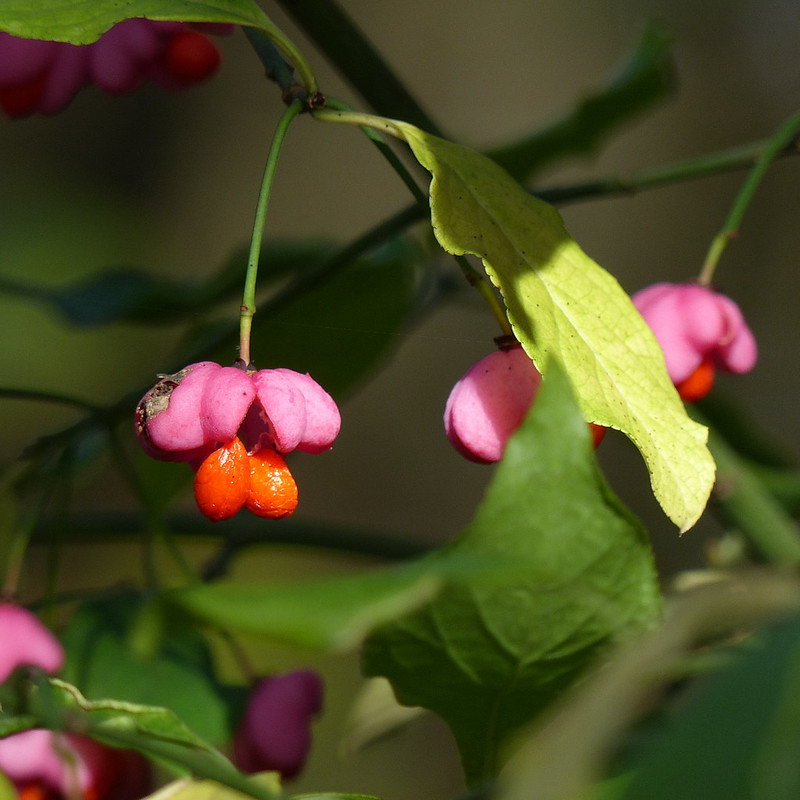
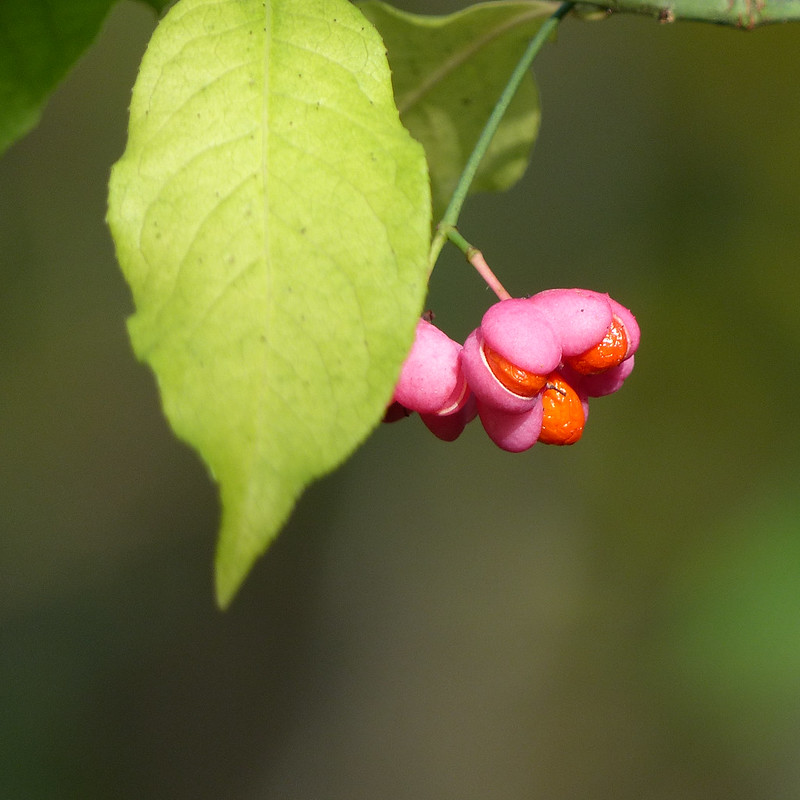
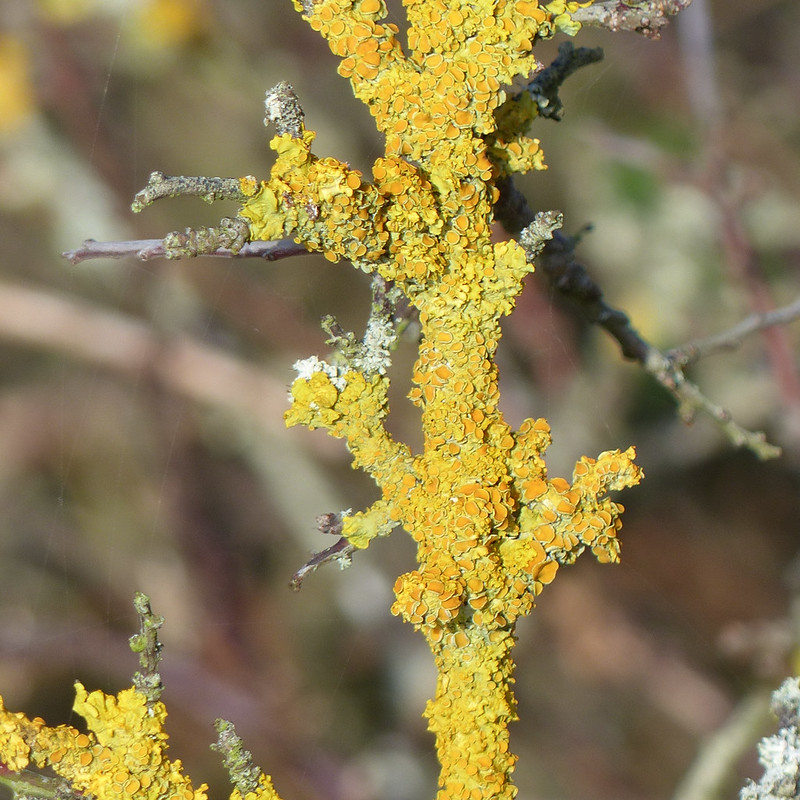
If I’ve identified this lichen correctly, and it is Xanthoria parientina, then it’s a common lichen which produces a yellow chemical, xanthorin “thought to be produced as a defence against UV radiation” (source), when the lichen is shaded it doesn’t produce the chemical and is then green.
Lichens are famously a symbiosis between a fungi and a photosynthesising partner, either an algae or a cyanobacteria (blue-green algae). I’ve been reading ‘Entangled Life’ by Merlin Sheldrake, which TBH bought me for Christmas, and apparently many lichens are now known to be multi-species symbiosis, that is, to have three or more species living in partnership.
I didn’t study Biology at school, even to O-level standard, but with hindsight that seems like a crazy decision; the more I learn the more unlikely and astonishing almost every aspect of life seems to be. For example, also gleaned from “Entangled Life’, did you know that are own mitochondrial cells might have started life, in evolutionary terms, as independent bacterial cells? I think I’ve got that right, although, as I said, I’m no biologist!
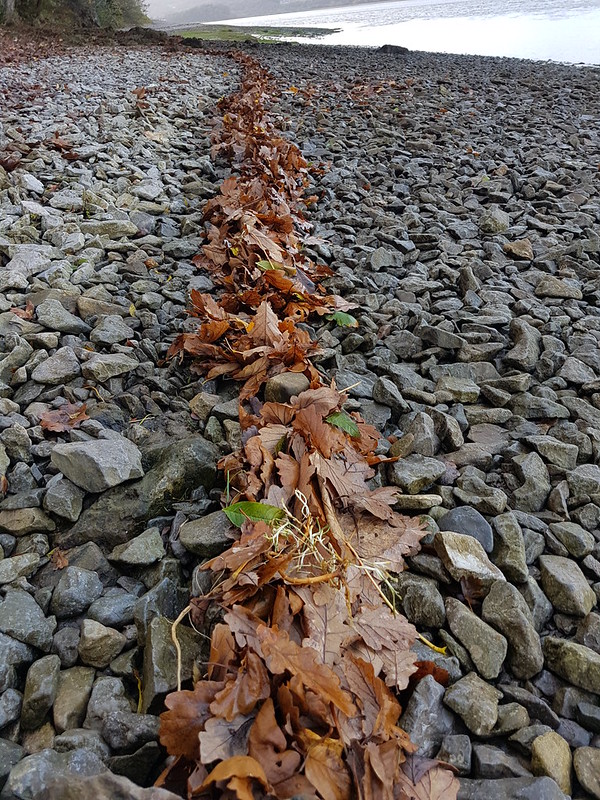
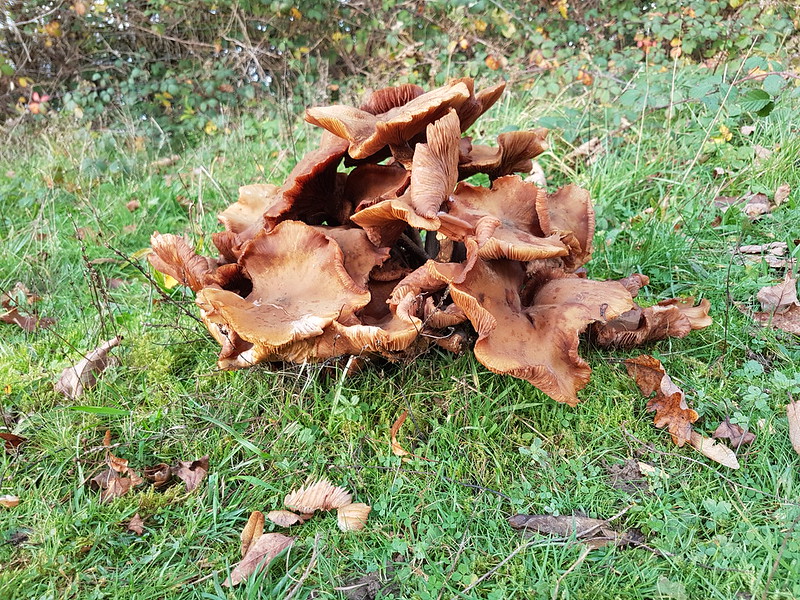



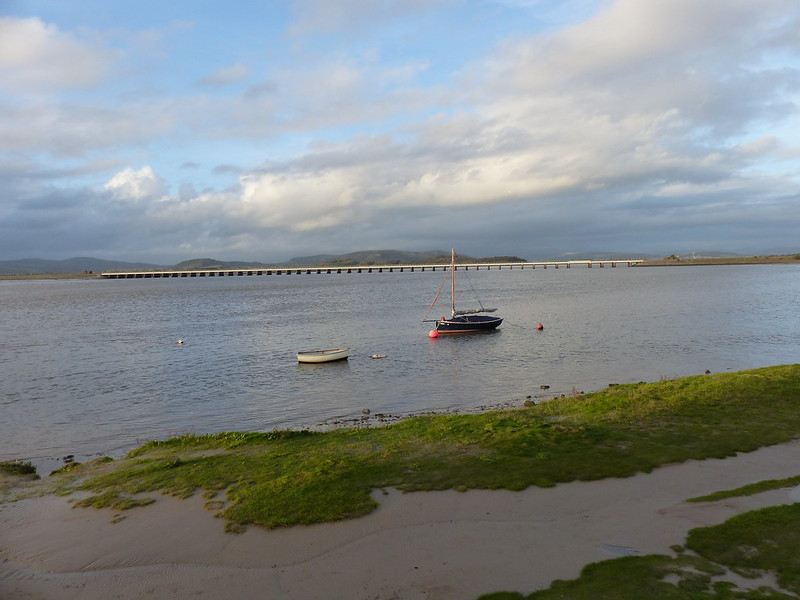
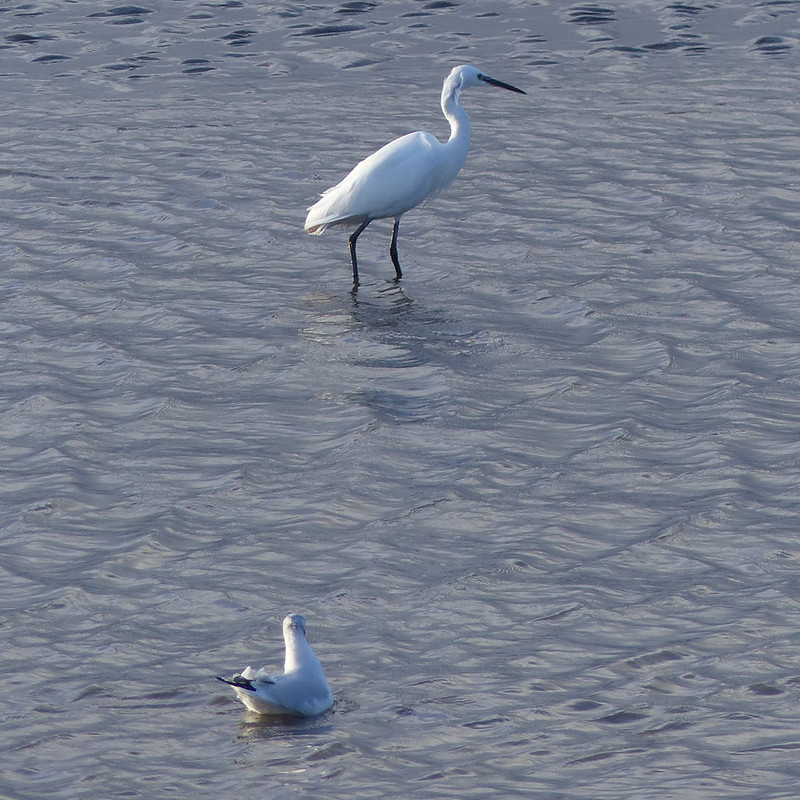
There were four Little Egrets stalking the shallows just off the promenade in Arnside. They fish by stirring up the riverbed with their feet, and look pretty comical doing it, a sort of avian ‘Ministry of Funny Walks’.
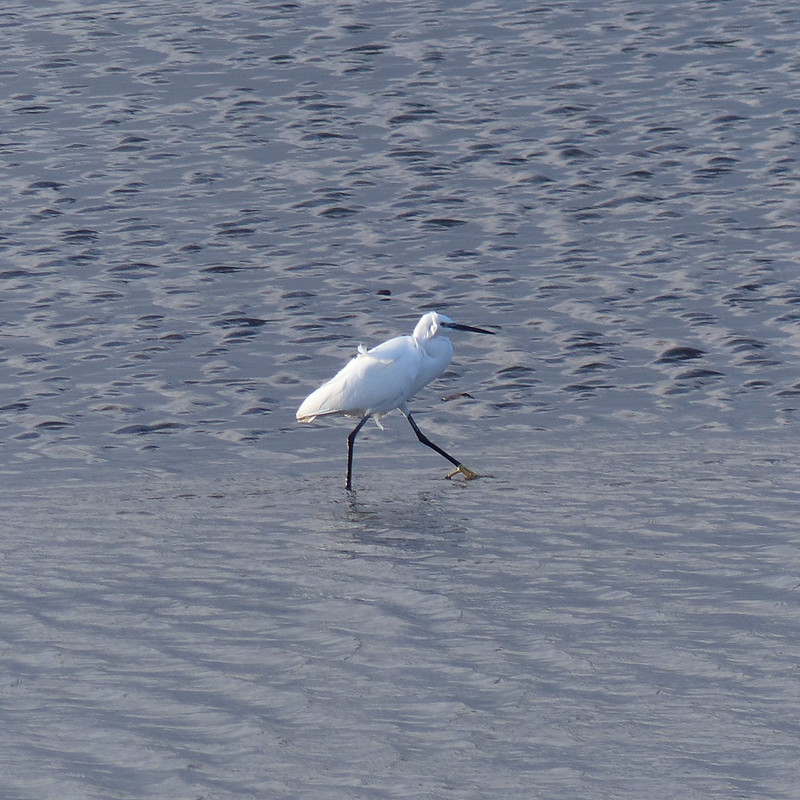
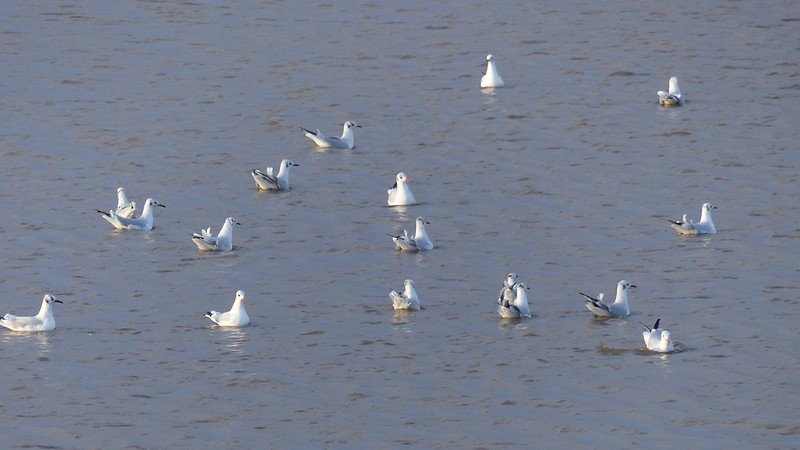
I know: they don’t have black heads, but their name is a bit misleading, because that’s breeding plumage, which, by autumn, they’d just about lost.
If you are reading in the UK, and haven’t got around to watching ‘Wild Isles’ yet, and, to be honest, I’ve only just started myself, there’s some amazing footage in the first episode of Black-headed Gulls trying to steal Sand Eels from Puffins.
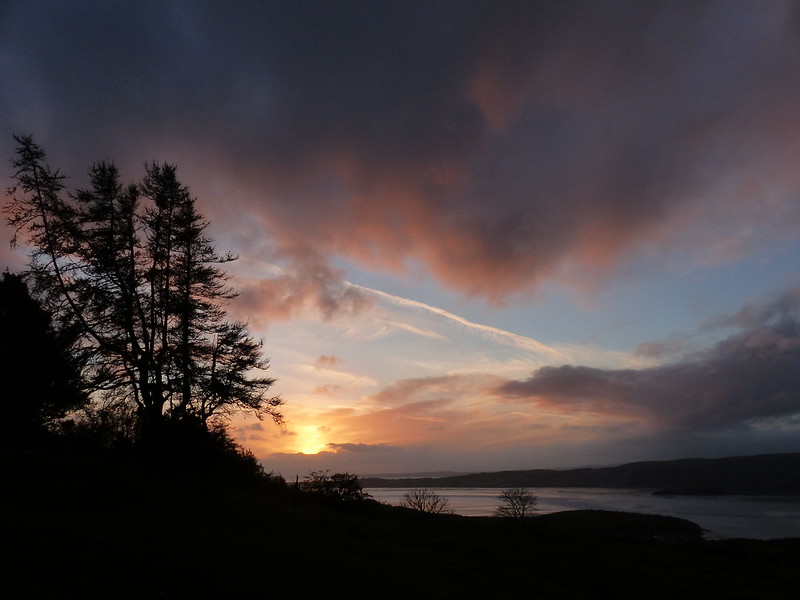
One advantage of a late start!
*If you were expecting at least a passing reference to the John Wyndham novel, my apologies**. I like his novels, this one included, but haven’t read it, or any of his others, for a very long time. Fifteen years in to blogging, when most of your posts consist of photos of leaves and butterflies, and the same three walks repeated ad infinitum, it’s sometimes hard to come up with titles you haven’t used before. That’s my excuse, and I’m sticking to it.
**Although, now, of course, you’ve had it. What are you complaining about?
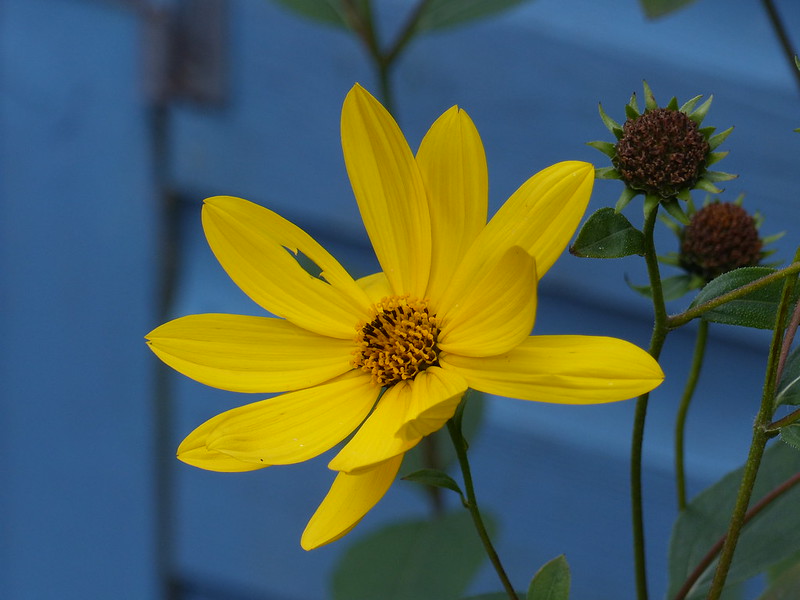
Our trip to America was amazing. The Adirondacks is definitely my new ‘happy place’. But coming home to my old ‘happy place’ was great too. Reunited with my camera, where would I go?
Well, initially, no further than the garden. And then not much further – a meander to Lambert’s Meadow, along The Row, past Bank Well to Myer’s Allotment and then back the same way. A very short walk which took quite a while because it was packed with interest. Well, packed with insects at least.
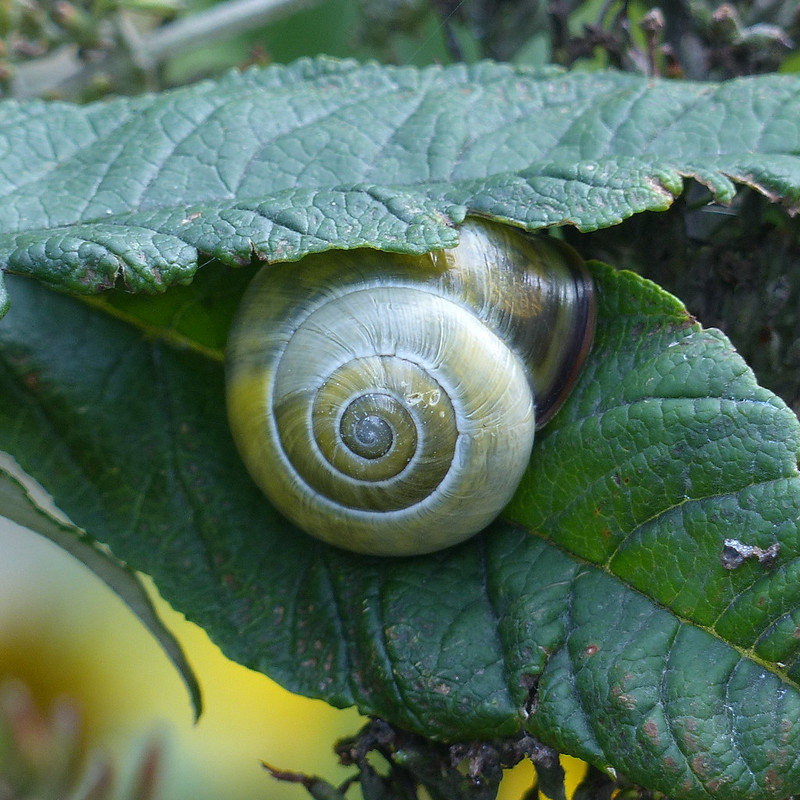
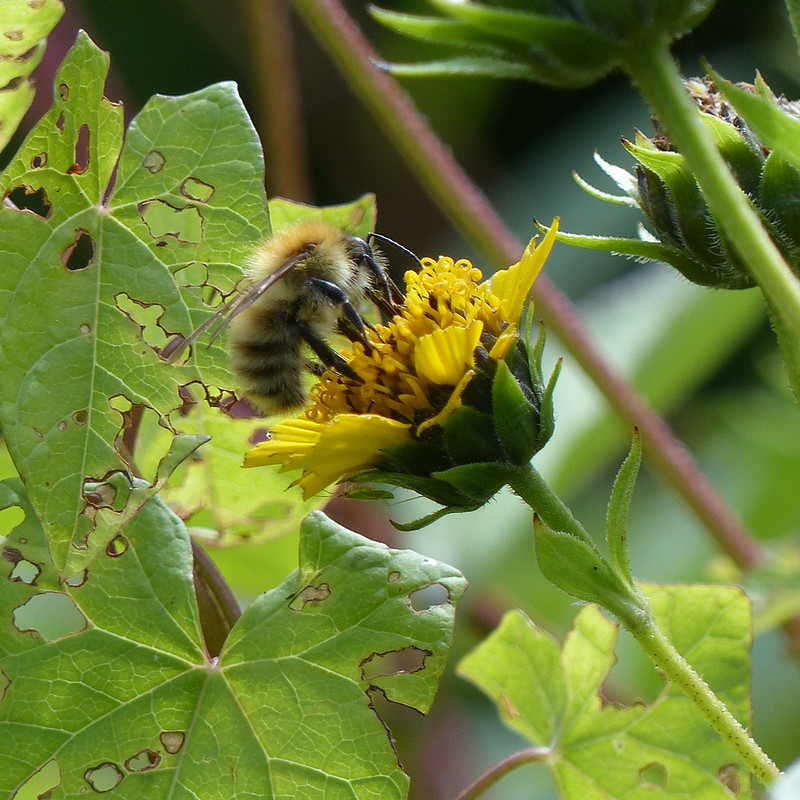
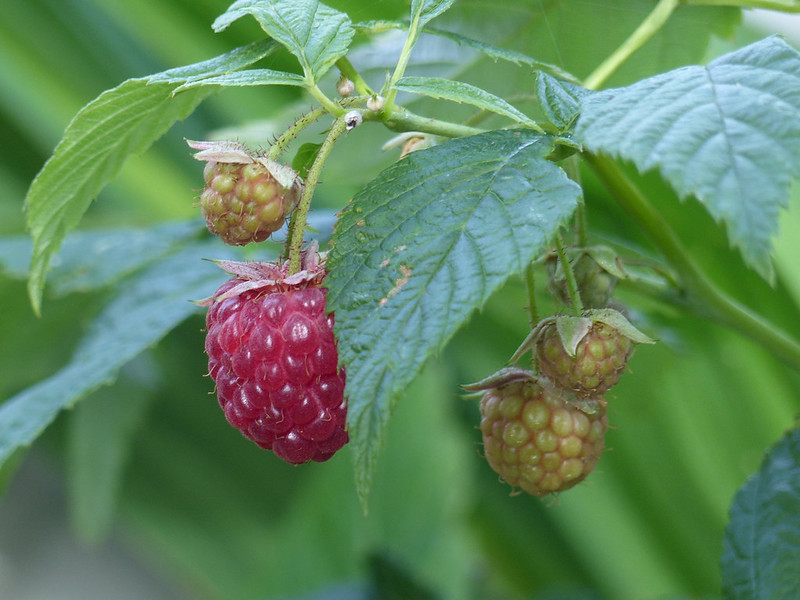
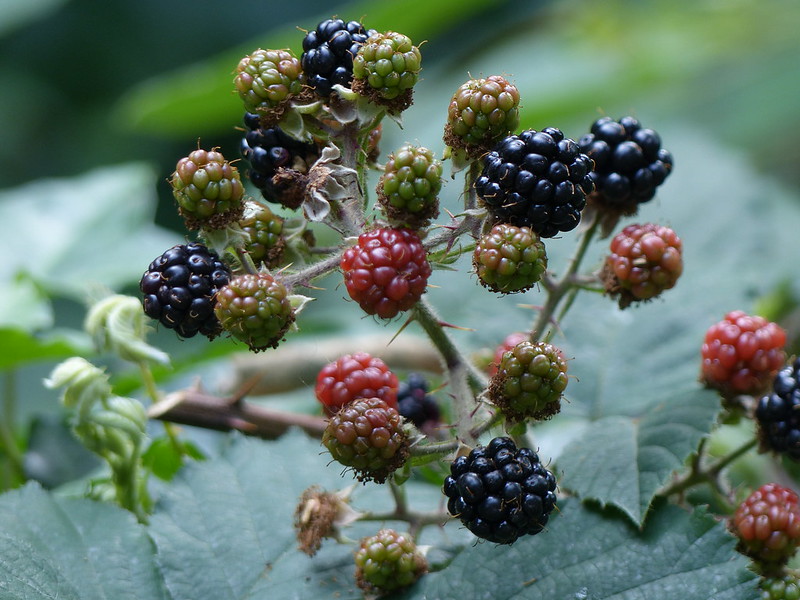

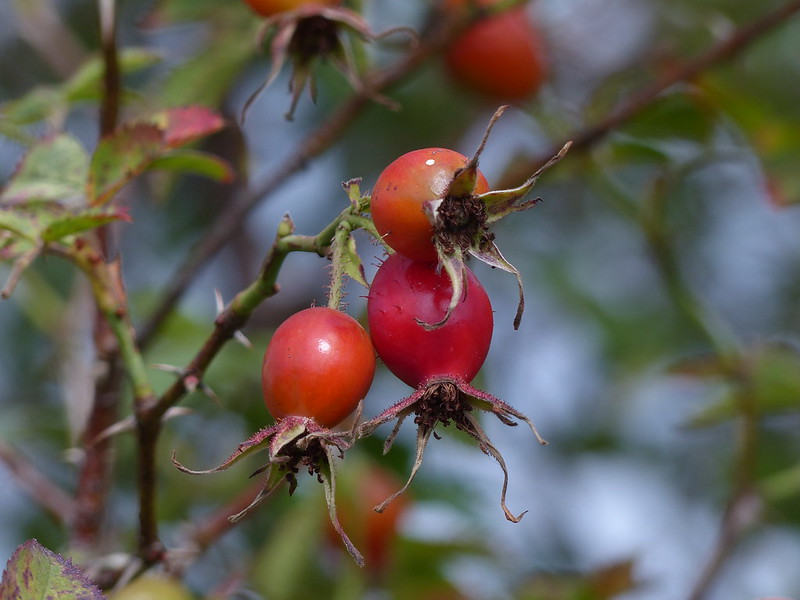
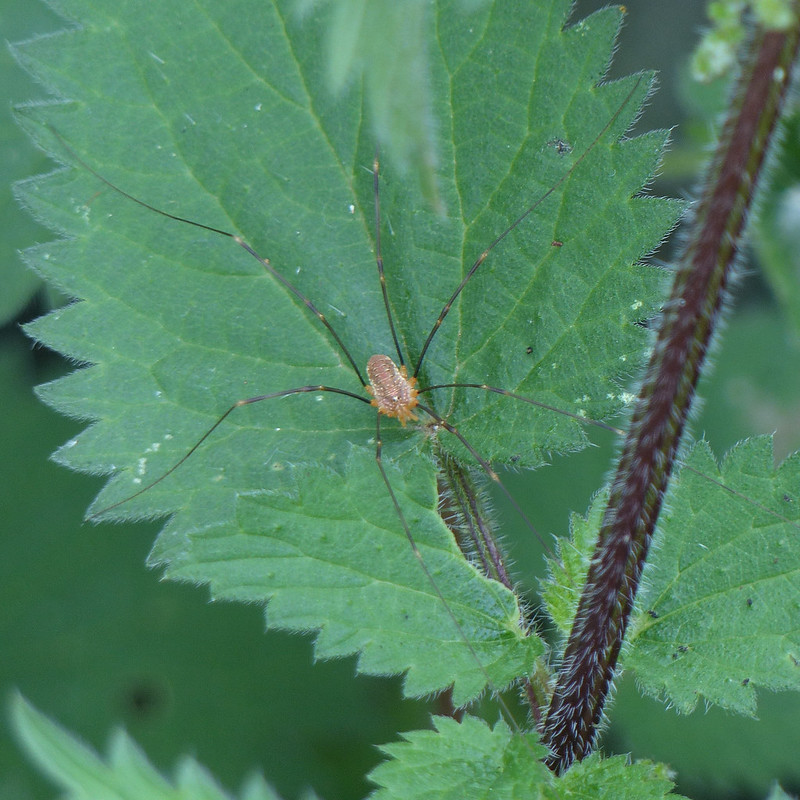
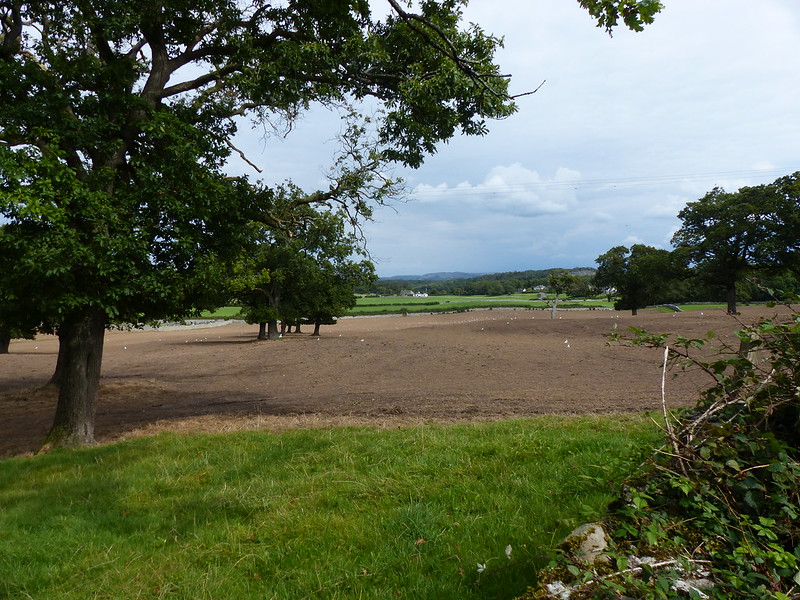
The tractor (and its driver) spent hours, long into the night, circling this field. Doing what? Not ploughing. The grass was removed, but, if anything, the ground seemed to have been compacted. Whatever, the gulls were very taken with the activity and followed the tractor slavishly.
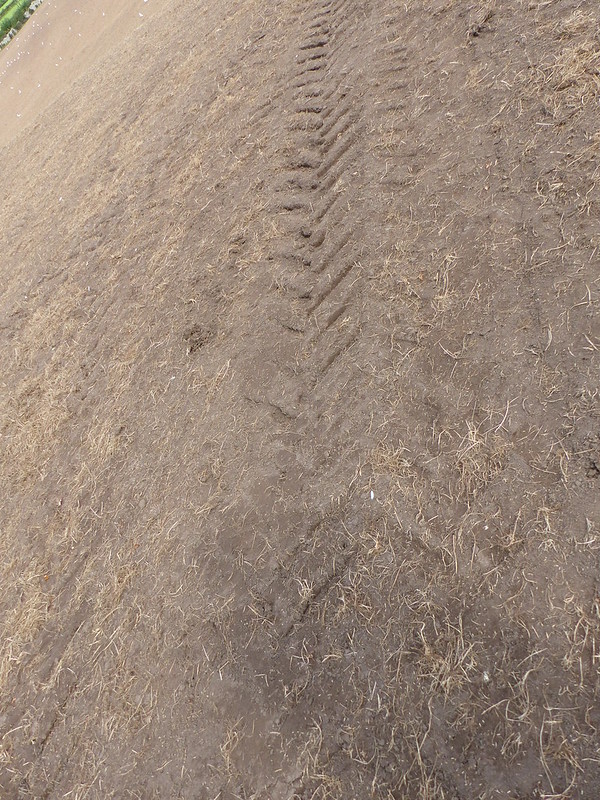
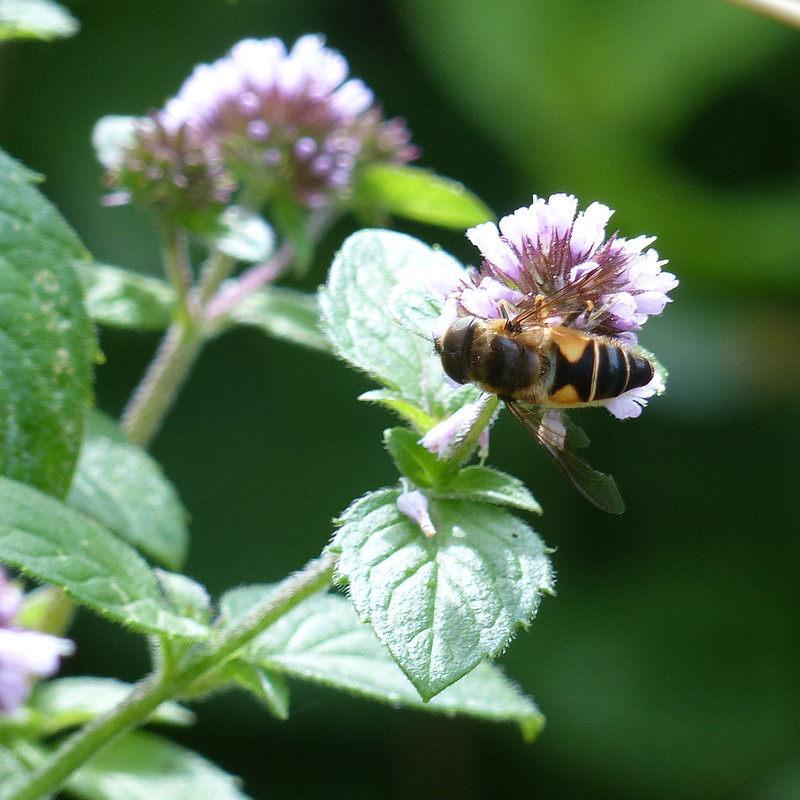
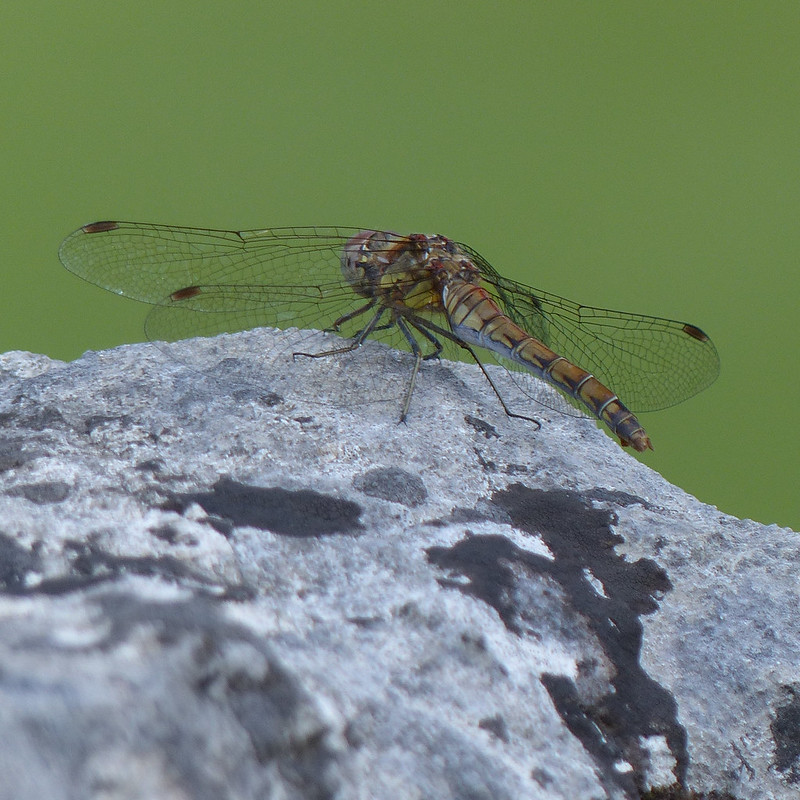


At first I thought this was a Forest Bug, which is superficially quite similar, but I think the stripy antennae are the clincher.

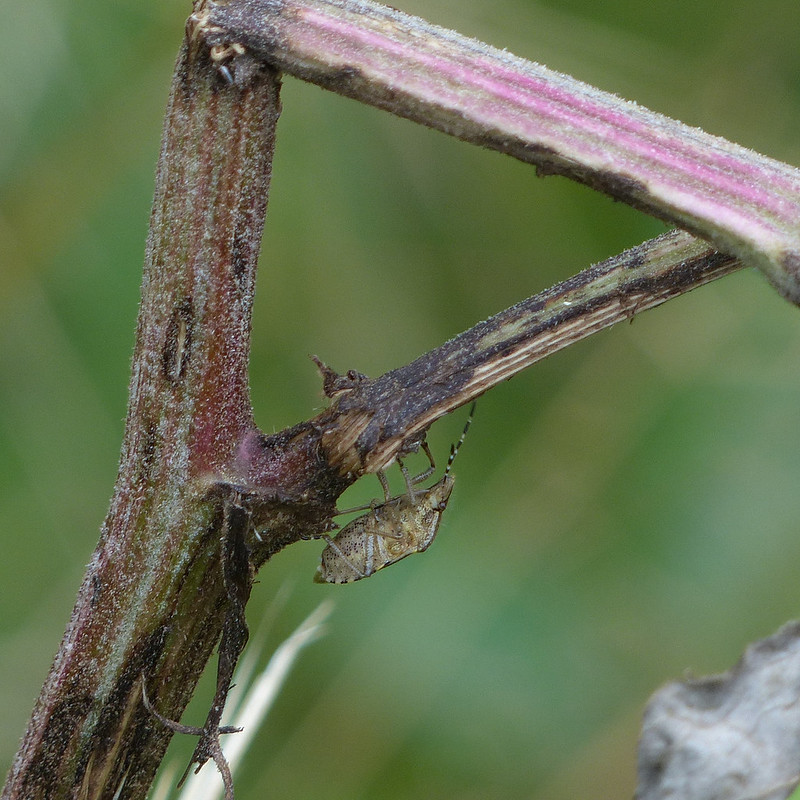

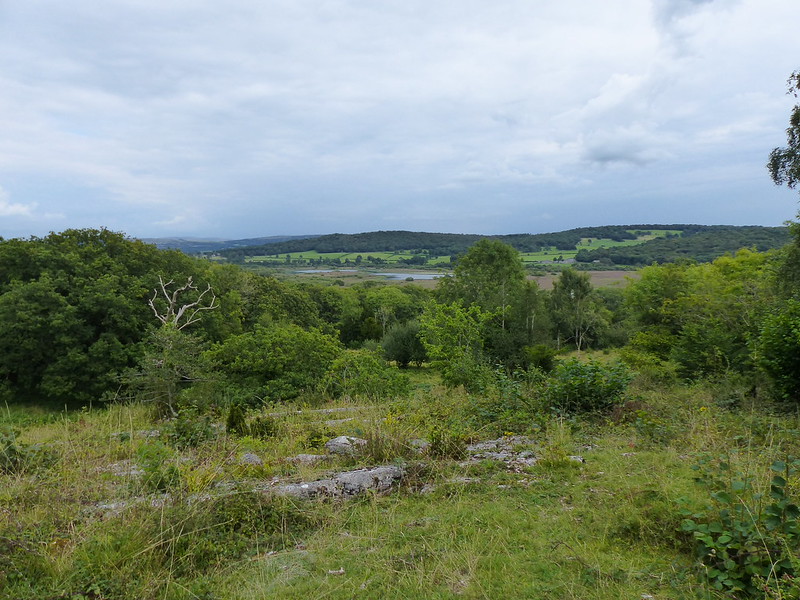
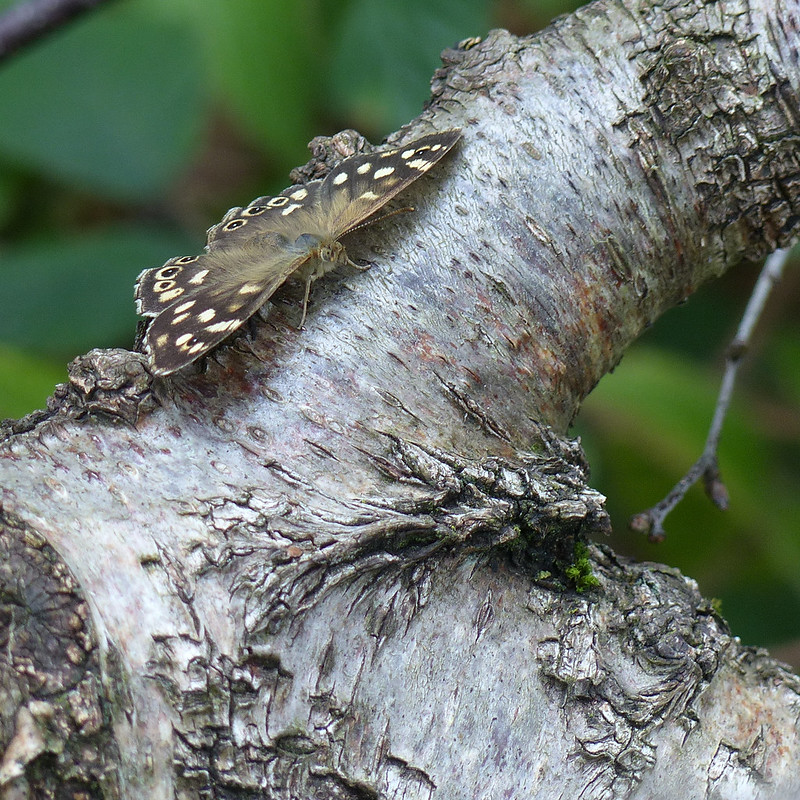
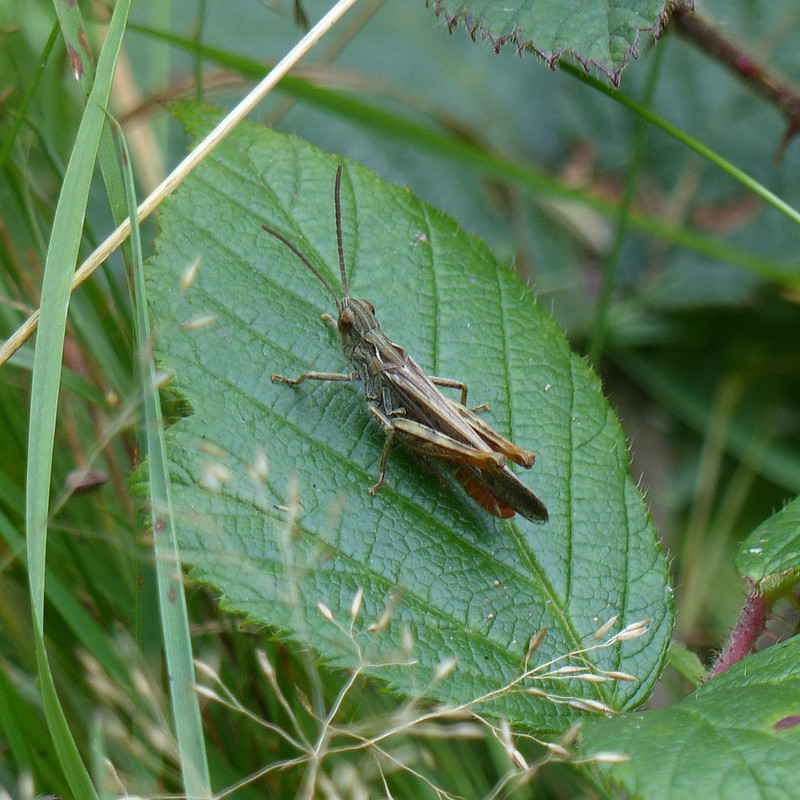
There were lots of grasshoppers about, but they have a habit of springing away just as I get my camera focused.

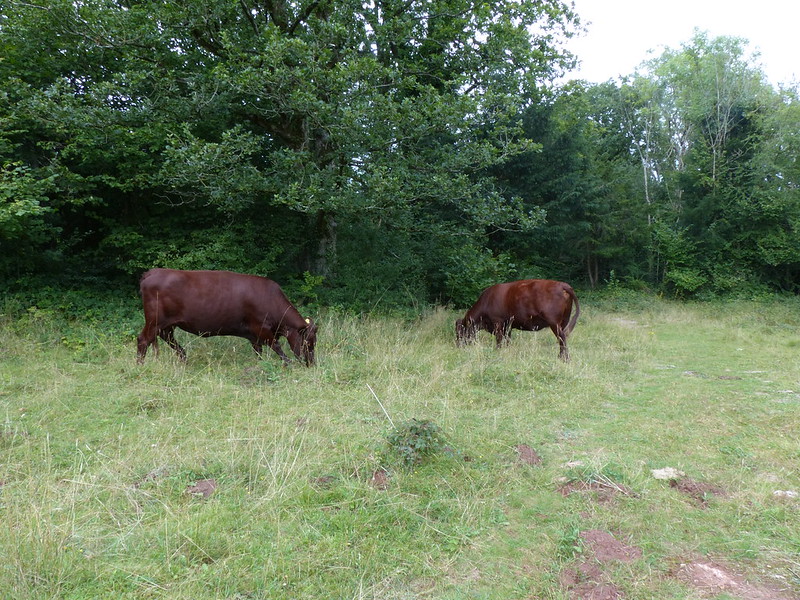
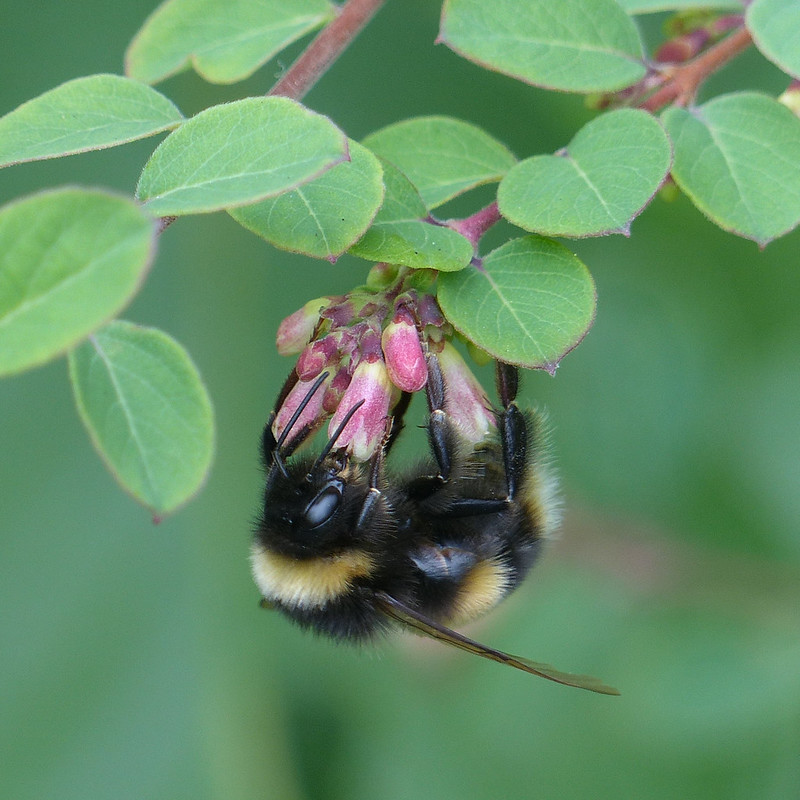
This garden plant, growing on the verge of The Row, was absolutely mobbed with bees and hoverflies.
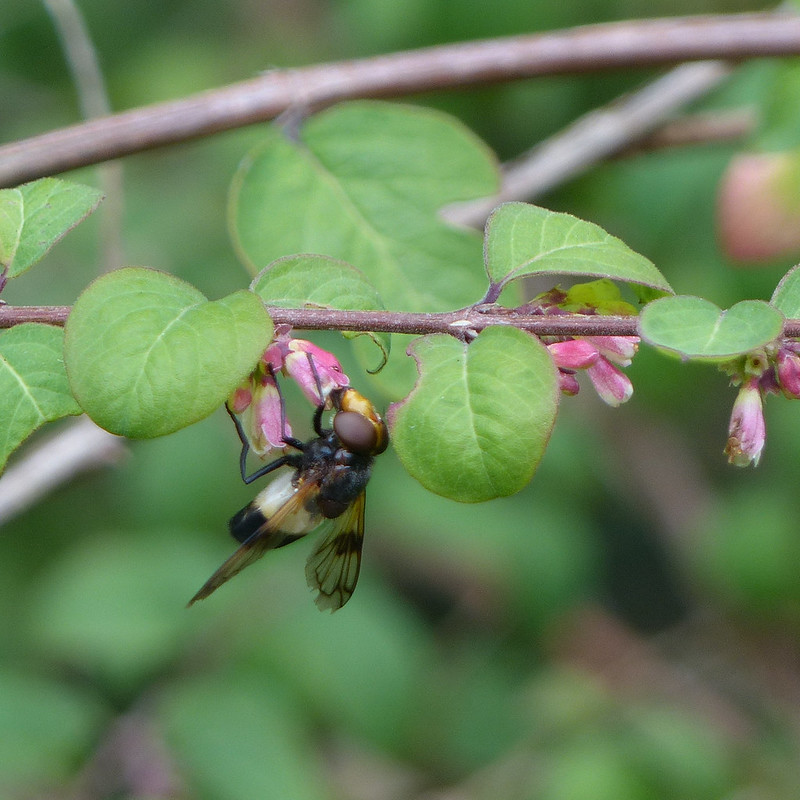
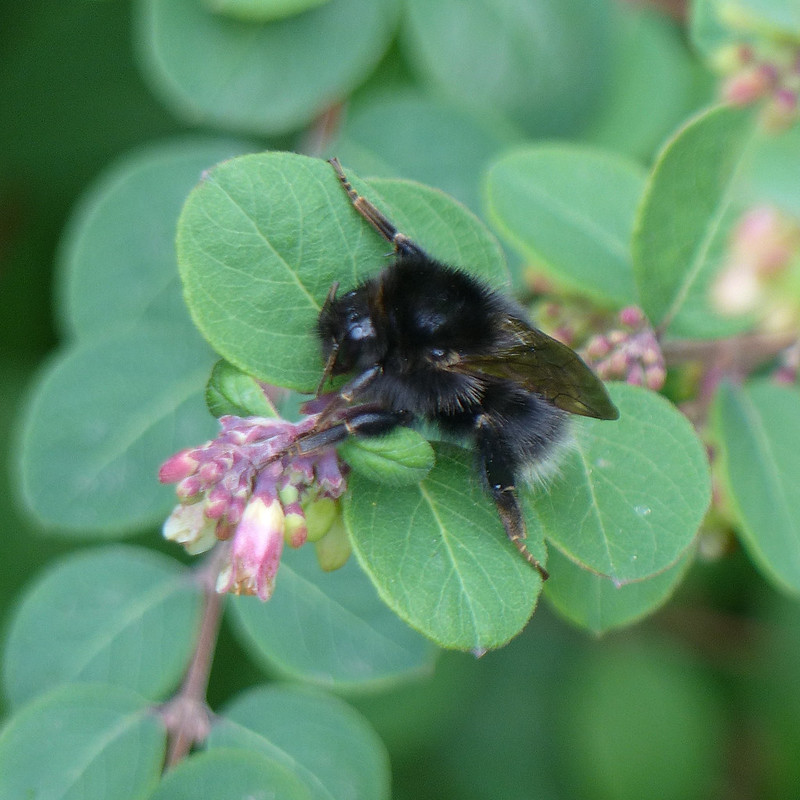
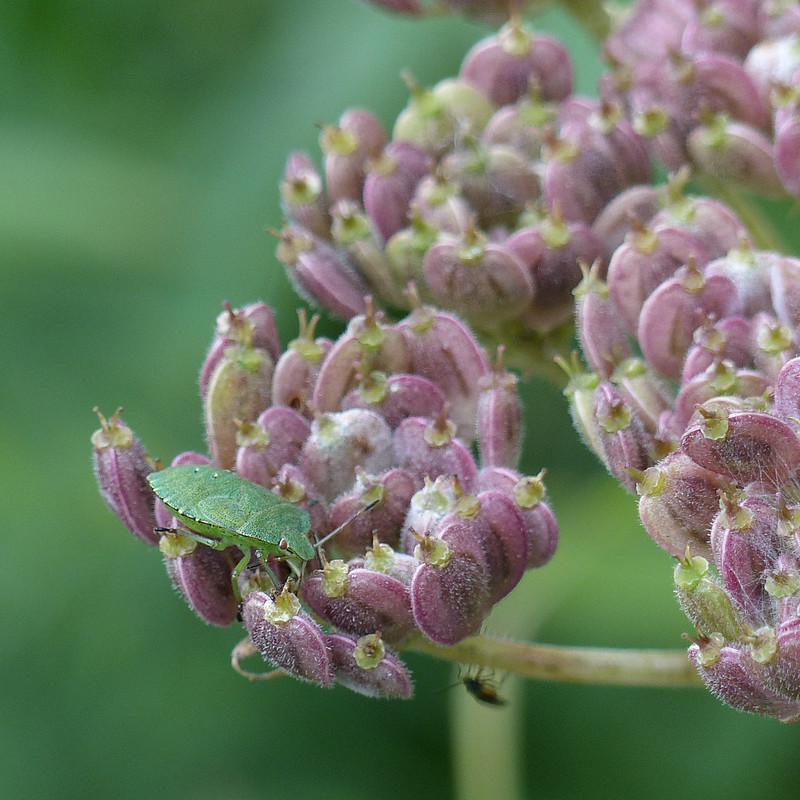
I also took photos of the leaves of this plant, and based on those I think it might be Hogweed. Which, I find, is reputedly very good to eat – apparently the seeds are widely used in Iranian cuisine and taste a little like Cardamon. Who knew?

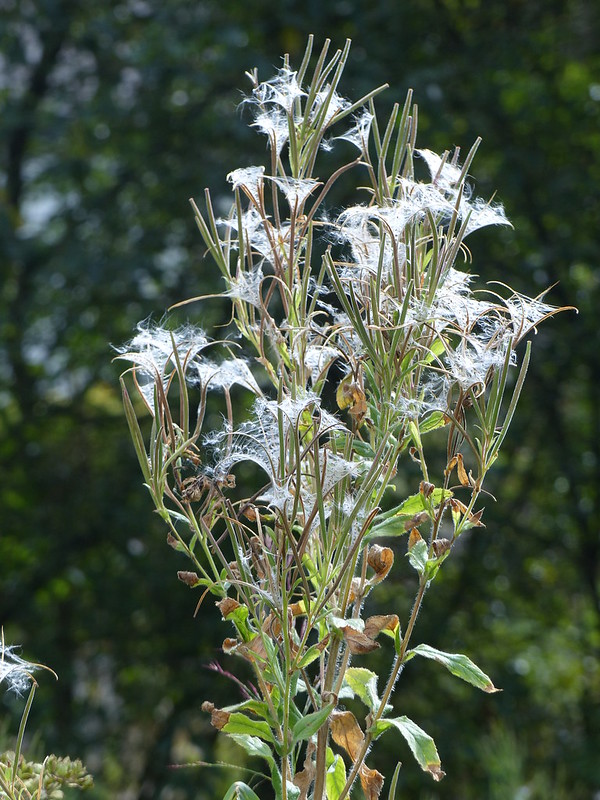

Ever since I read that Willowherb is the food-plant of the Elephant Hawkmoth caterpillar, I’ve kept an eye open, hoping to spot another. (Here’s the first.) It’s been many years, but my efforts eventually paid off…
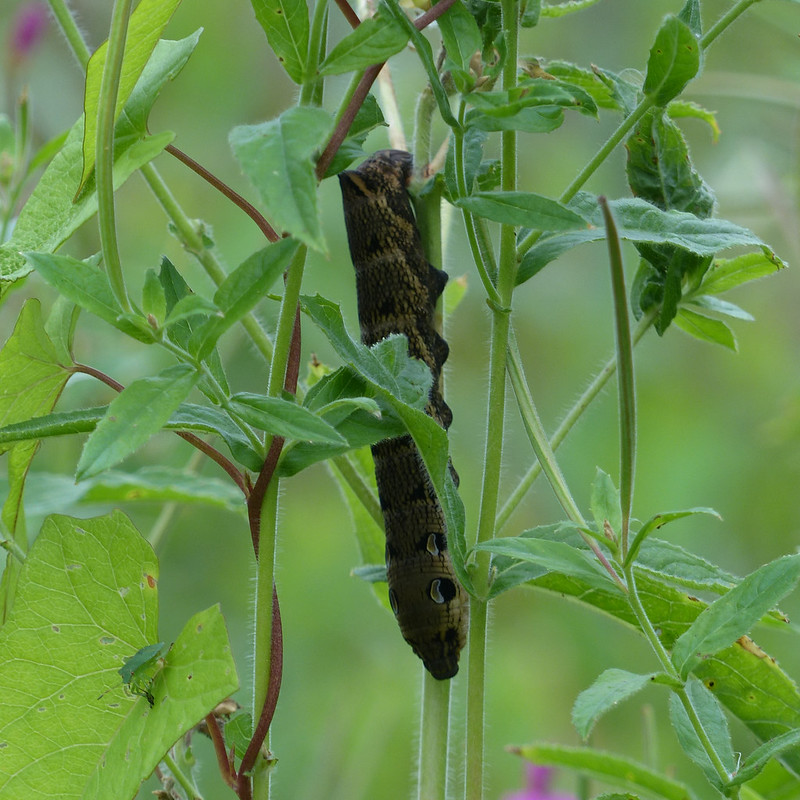
A very large and striking caterpillar. The adult moth is even more imposing. (There’s one at the top of this very old post).

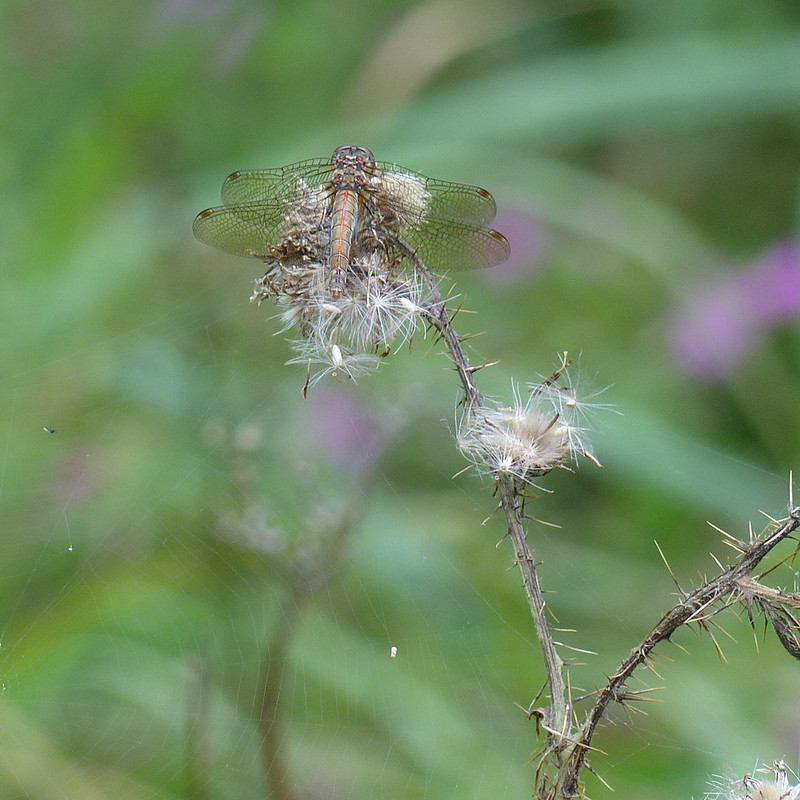

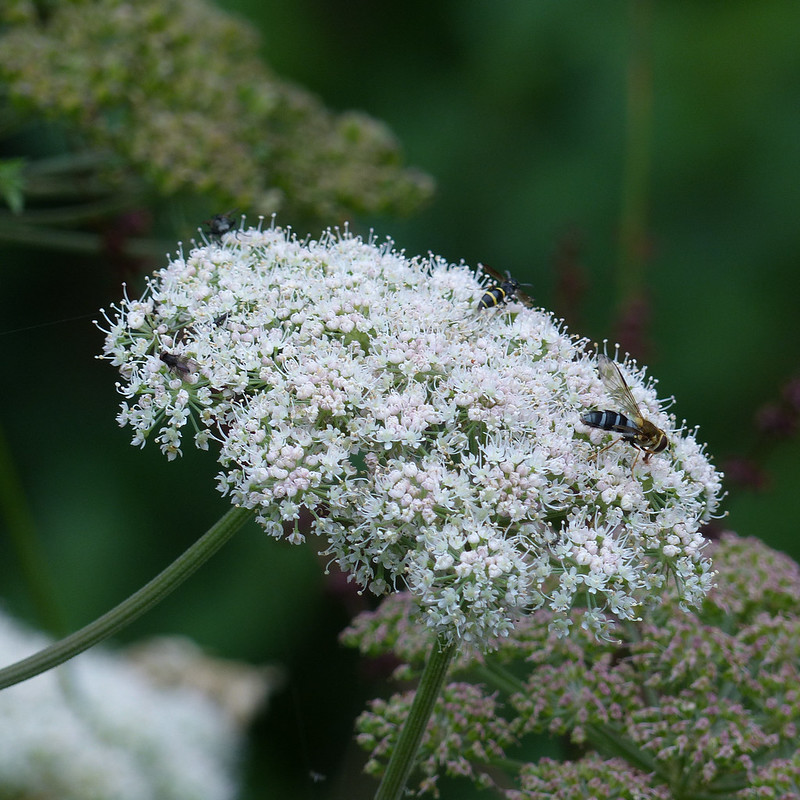
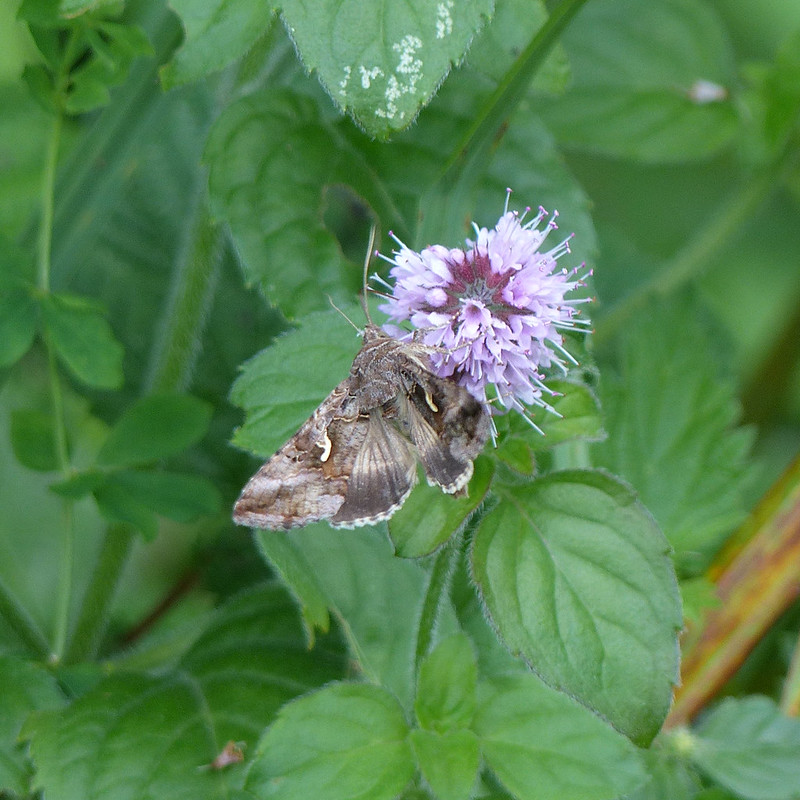

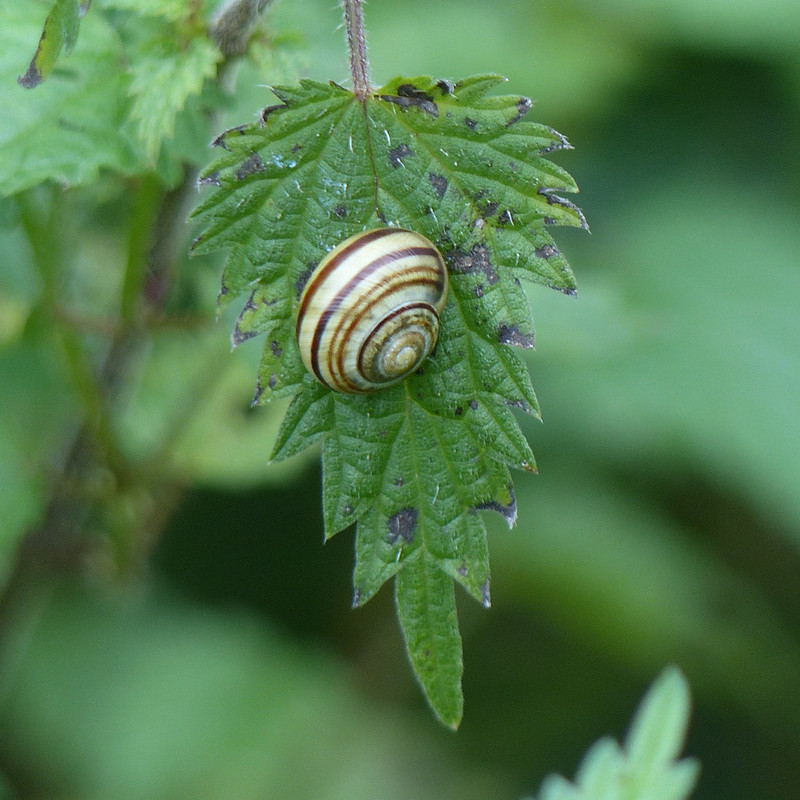
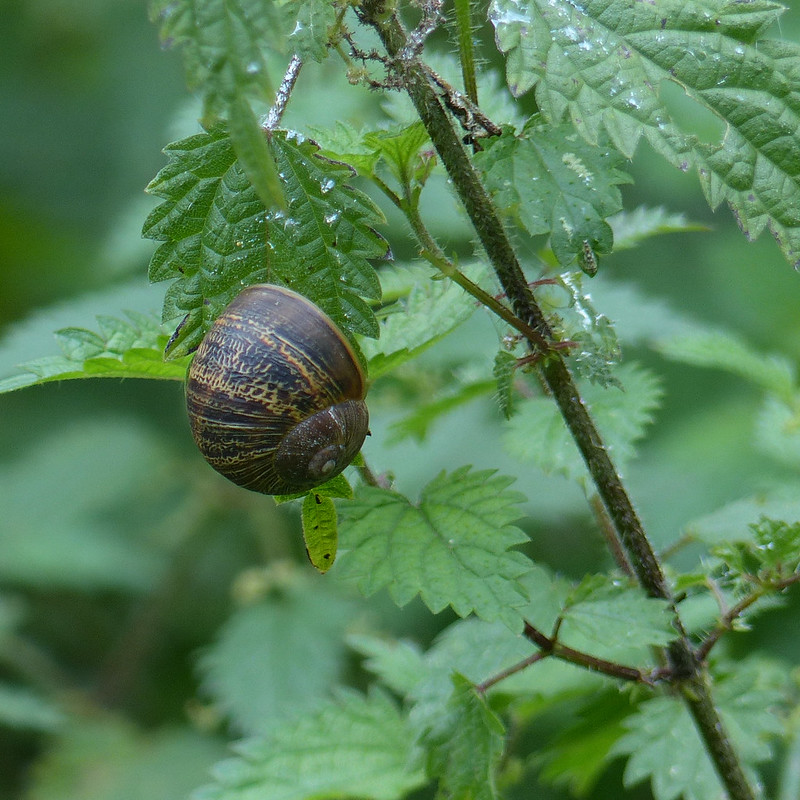
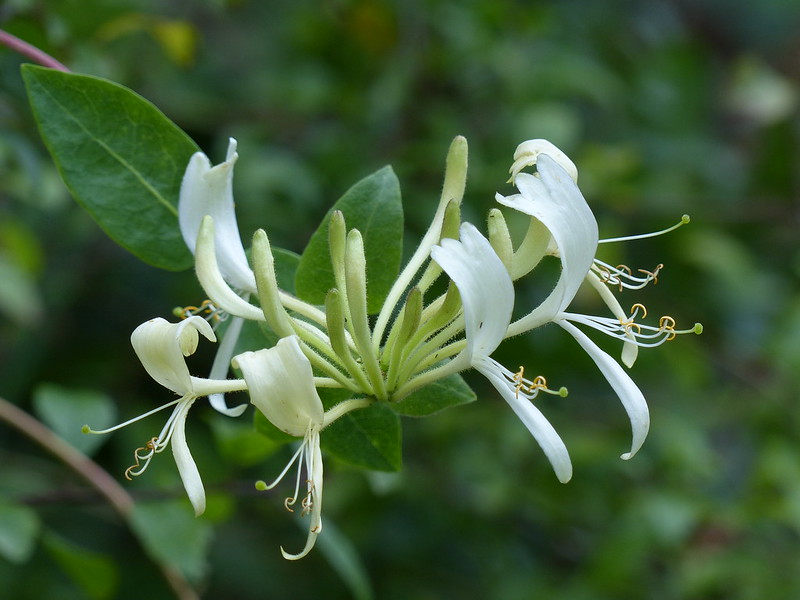

Adirondacks Day 4

The rest of the party were heading for a tree-top swinging, zip-line soaring adventure, not really my scene, so, having listened to a few recommendations, I opted for this shortish route. TBH and I had driven through the pass where I needed to park on our way back from Massachusetts the night before, so I was well aware of the many set of roadworks on the route, but parking was at a premium and, having failed to find a spot, I still managed to get into those roadworks and then had to drive through three sets of lights before I found a lay-by where I could pull-off and turn around and come back through all three sets again. When I did eventually manage to pull-off the road and park I was very close to the trailhead. Unfortunately, I didn’t know that and walked a long way back along the road, in the wrong direction, looking for the path. Still, I eventually got started, into the deep shade of the woods.

My friend the EWO, once told me, decades ago, that he didn’t like walking in woods because of the absence of views. He may well have revised his opinion by now. Anyway, I suppose the lack of views made me focus even more than I usually would on the plants and fungi growing under the canopy. I was struck, for instance, by how much this plant resembled our own Solomon’s-seal. Obviously, I’m not the first to have noticed.
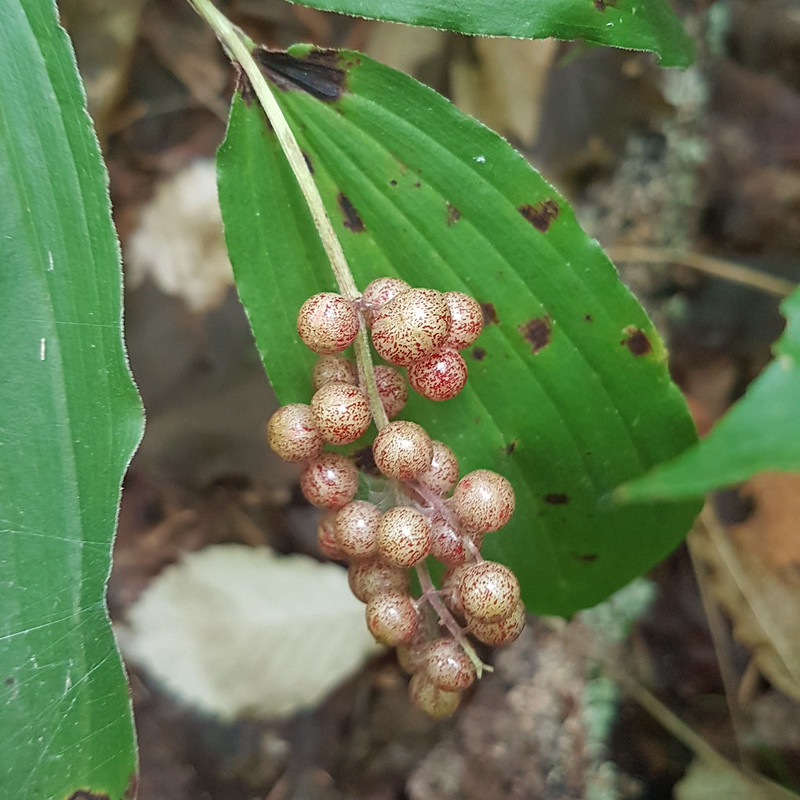
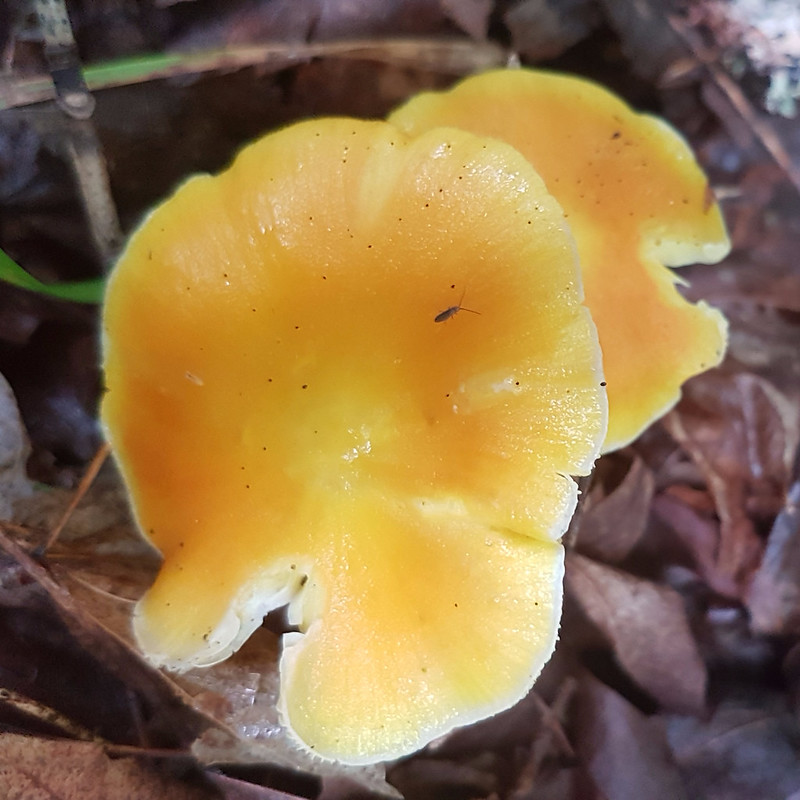
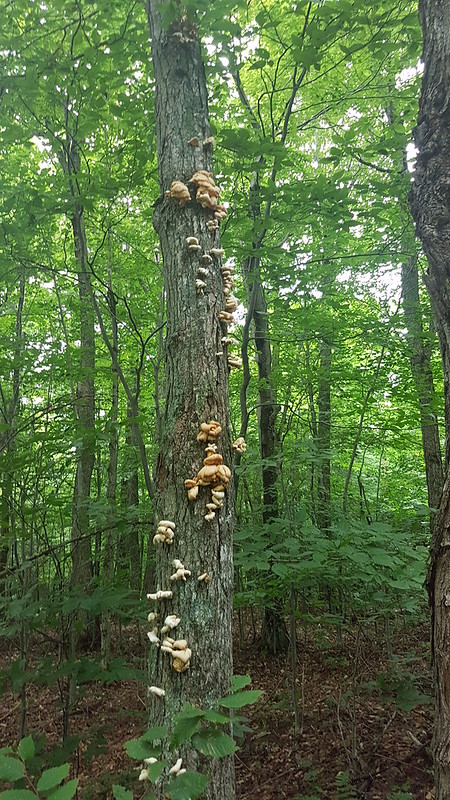
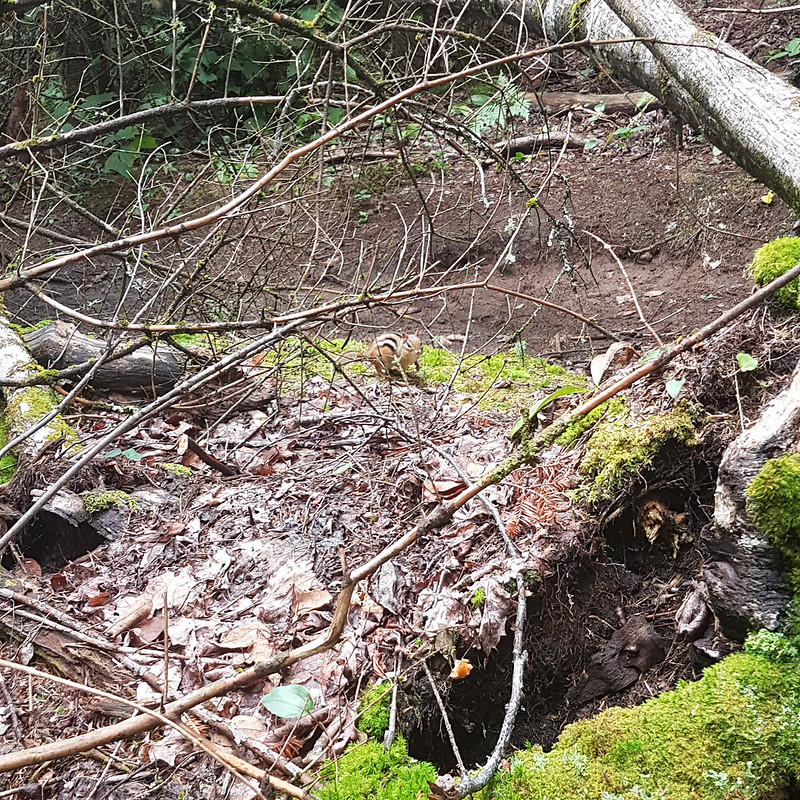
I think I saw about five Chipmunks during this walk. It was a bit of a fool’s errand attempting to photograph them with my phone, but that didn’t stop me trying.
Obviously vistas of any kind were a bit of a rarity, but at one point the path was close to a steep drop and the views opened up.

Perhaps because views were far and few between, when they did come I relished them all the more. I took a lot of photographs of Cascade Mountain that day. It’s apparently regarded as the easiest of The 46 – the mountains in the Adirondacks of over 4000′. Of which there are, you’ve guessed it, twenty-seven. Just joshing – there are forty-six of course. Ticking-off the 46 is just as much an Adirondack preoccupation as Munro-bagging is in Scotland.
Something about this ‘wasp’ made me suspect that what I was seeing was actually a moth, a wasp mimic.
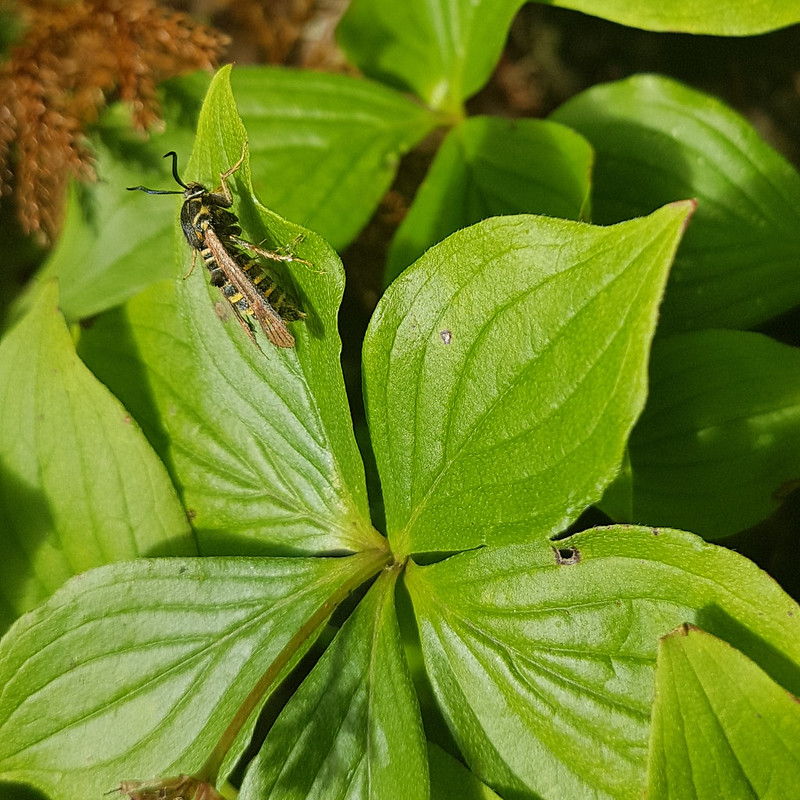
I now believe that it’s a Raspberry Crown Borer Moth, a clearwing moth whose larvae bore into the stems of brambles and raspberry plants, causing a lot of damage to fruit-crops apparently.
Parts of the climb were very steep, with one short section bordering on scrambling, on very loose ground where the best hand and footholds were exposed tree-roots. Eventually however, I reached the broad ridge and turned right – which took me downhill and onto an open rocky area with sudden expansive views.

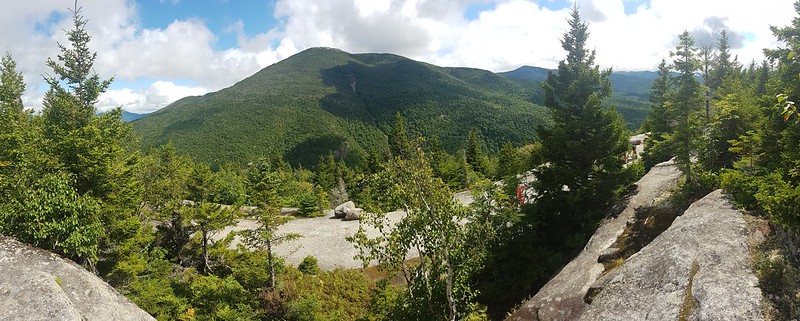
Continuing down the rocky ridge a little way brought me to Balanced Rocks…

I’m not sure if they look it here, but these were pretty big boulders. The views were superb and, initially at least, there was nobody else about. I briefly chased a Monarch butterfly again, and some large grasshoppers, and a pair of chipmunks, in each case without any photos to show for it, before settling down to eat some lunch and enjoy the views.

Somewhere over that way is the small town of Lake Placid where the 1932 and 1980 Winter Olympic Games were held.
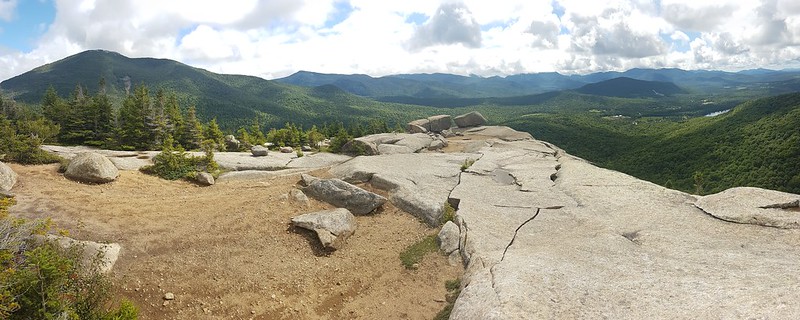
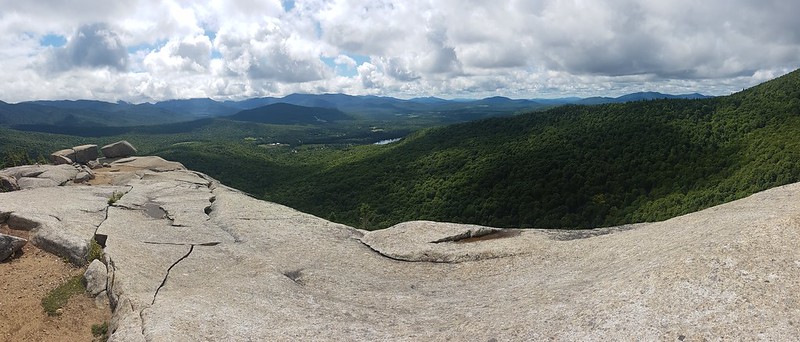


I followed a large dragonfly along this edge, trying to get a photo whilst, at the same time, trying not to lose sight of the drop and fall off.


Eventually I had company, an all male group (my guess, two brothers and their sons) whom I had passed on the steep approach to the ridge. Here they are on the boulders…
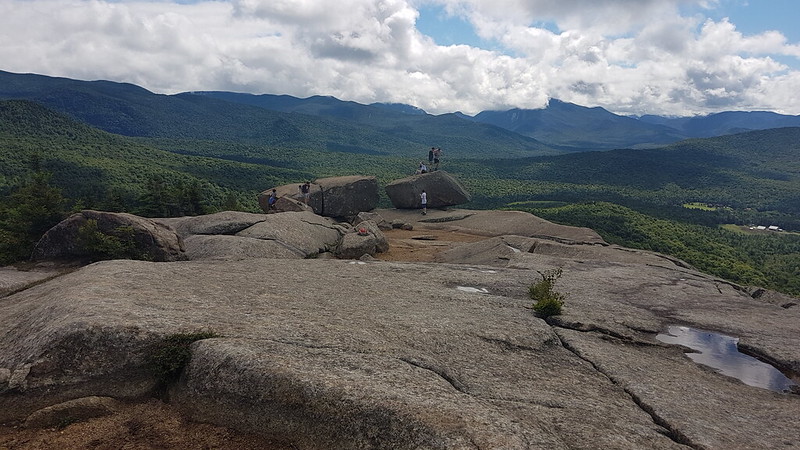
It was nice to talk briefly to them. They were blown away by the views, whooping and hollering in a very American way, and their enthusiasm was infectious. I took some group photos for them and then dragged myself away and turned back up the ridge.
I still hadn’t decided whether I would return directly to the car, or continue up the ridge to the top, but when I reached the path junction, I didn’t have to deliberate for long – I wanted to continue up the ridge to the top.

Immediately, the path was narrower and evidently less well-used.
The other very obvious difference was the presence of lots of clumps of…
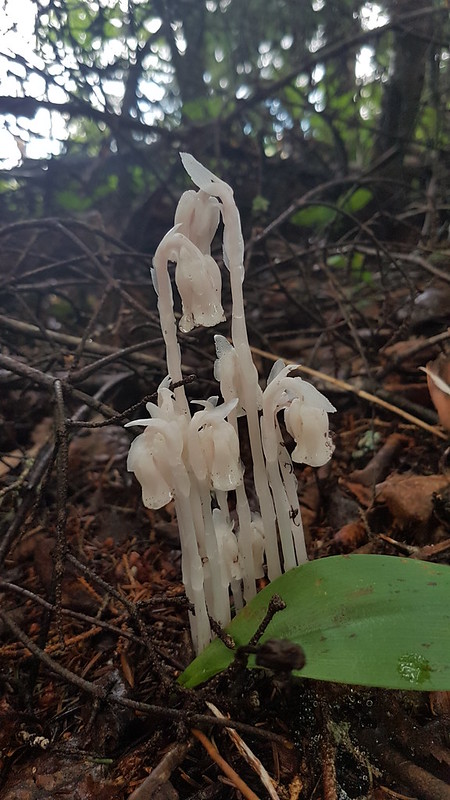
It was very common along the ridge. Like Toothwort, which pops up in the woods at home in the spring, this is a parasitic plant which has no chlorophyl, hence the completely white stems, flowers etc.
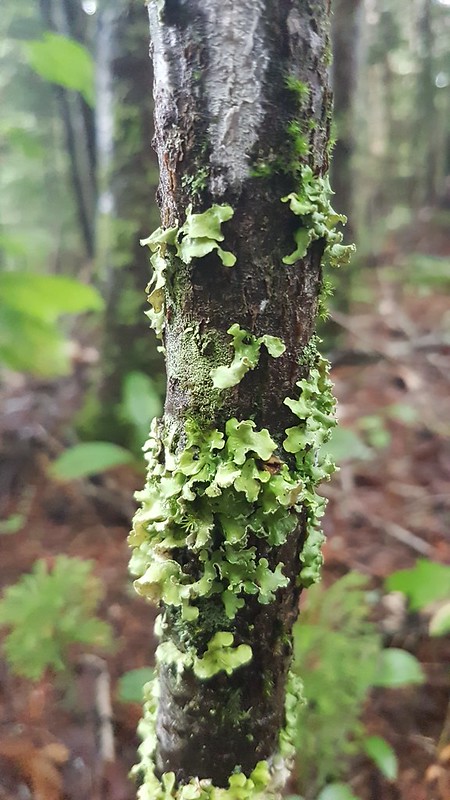
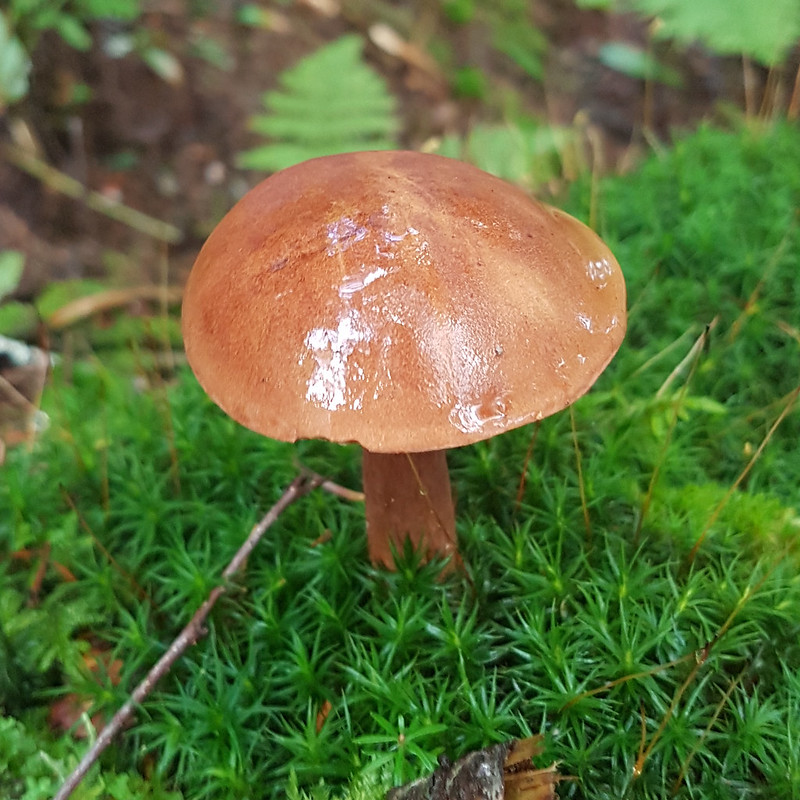
The summit of Pitchoff Mountain has no views at all, being crowded by trees. But a very faint path continues along the ridge to another, lower top, so I followed that to try my luck.
This top had a rocky edge, giving clear views in one direction only – you guessed it, toward Cascade Mountain again…
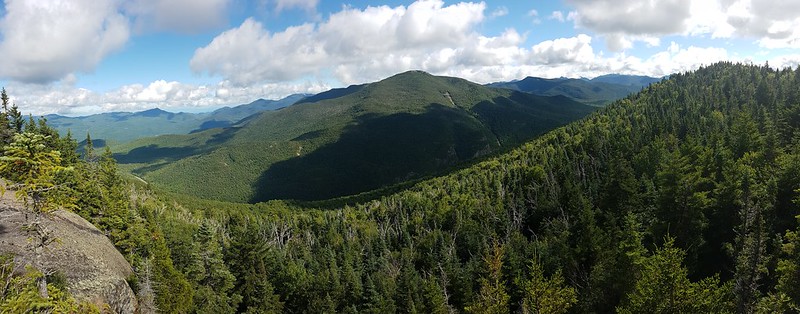
Now, it was just a case of retracing my steps back to the road. I was surprised by how tired I felt. When I reached the place on the descent where views opened out to Cascade, I seem to have found a better spot to take a photo. I think I was a bit less circumspect about the exposed drop.

It had been a really superb day, but it didn’t end there. I’d arranged to meet up with the others in the town of Saranac Lake which, of course, sits on the shore of….Flower Lake! (Which, to be fair, is connected by waterway to the complex of Lakes which include Upper, Middle and Lower Saranac Lakes – of which more to follow.)
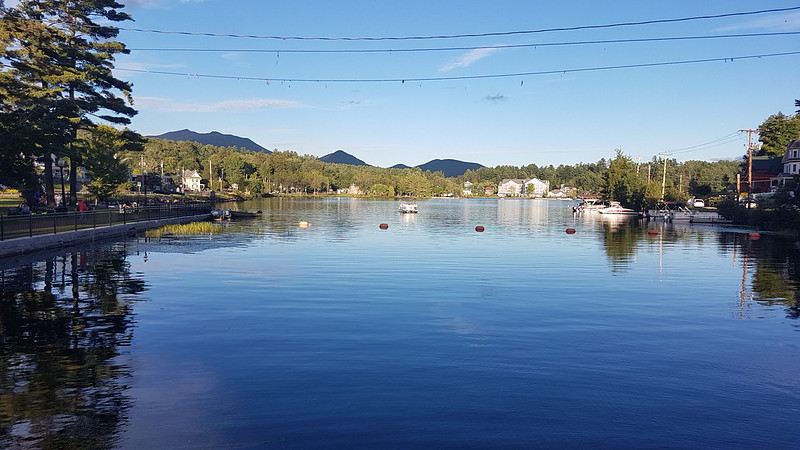
We were there to get pizza. Do a bit of fishing…

Have a wander around the town (well TBH and I did anyway).
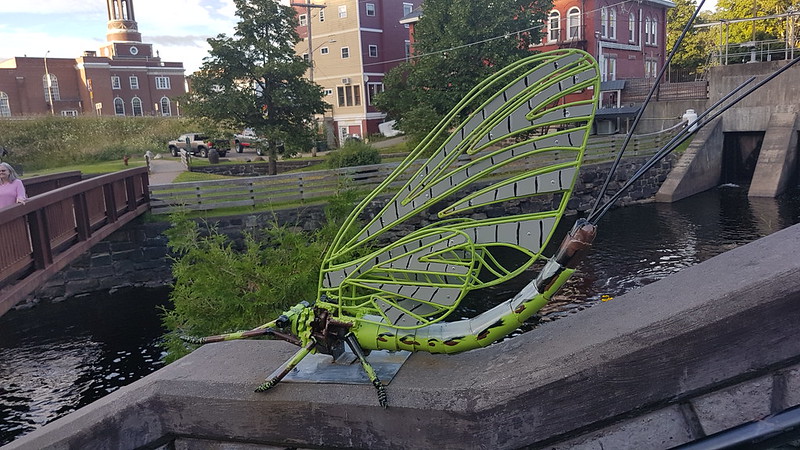
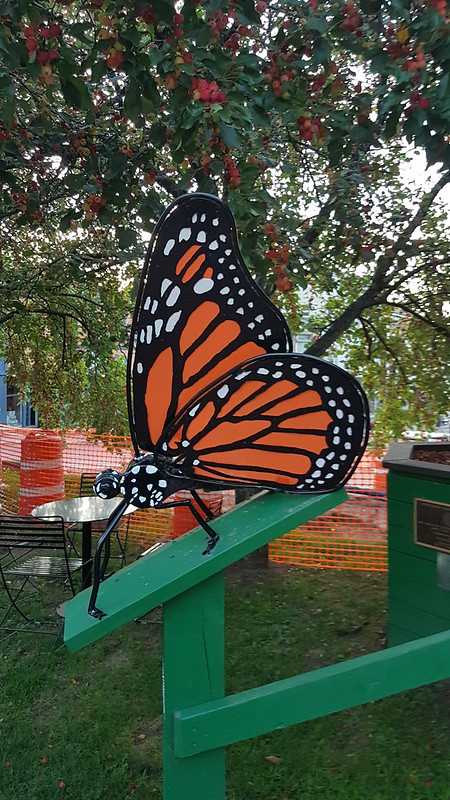
And enjoy a free concert. I think the band said they were Puerto Rican, so I guess the music was Puerto Rican too. Wherever it originated, it was very good.
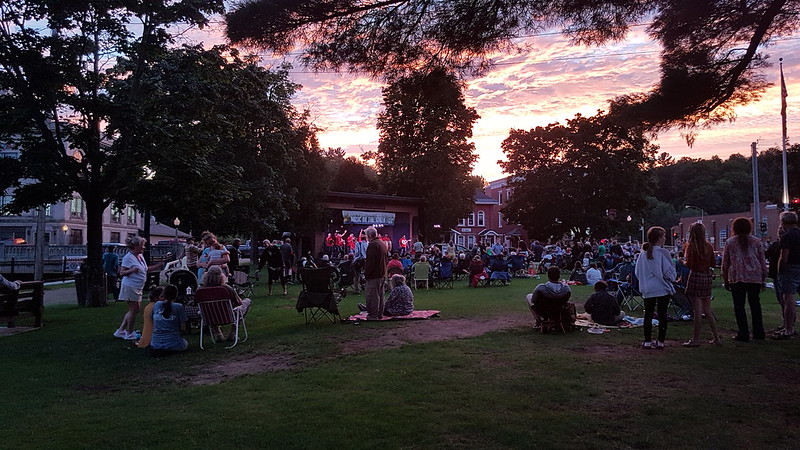
The concert was the last in a series of free summer concerts in the town. It was one facet of the very favourable impression of Lake Saranac I came away with.

The town even has its own bagging challenge, to climb six local mountains: Ampersand, Baker, Haystack, McKenzie, Scarface and St. Regis. For hardy souls there’s a winter version of the challenge too, which I presume would have to be done in snow-shoes. Apparently, the winters are hard here; the lakes and ponds all freeze over and the ski-doo becomes the practical mode of transport.
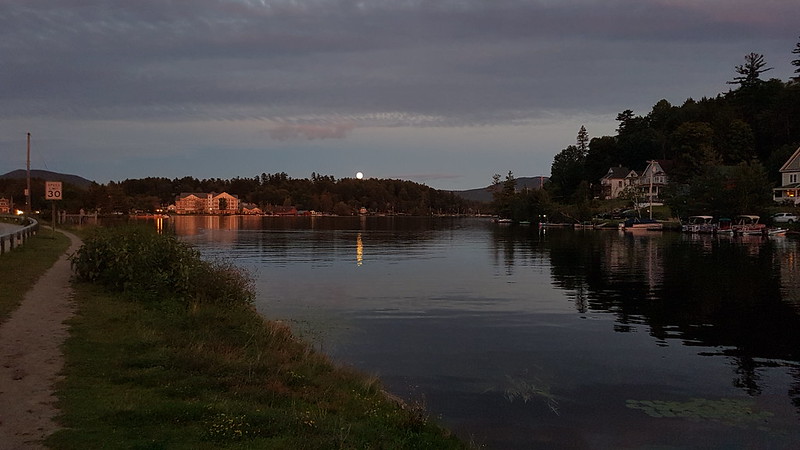
Anyway, the Lake Saranac Six sounds like a more manageable target than The 46 and I’d love to come back and climb them all. (Spoiler alert, we did climb one of them – more to follow!)
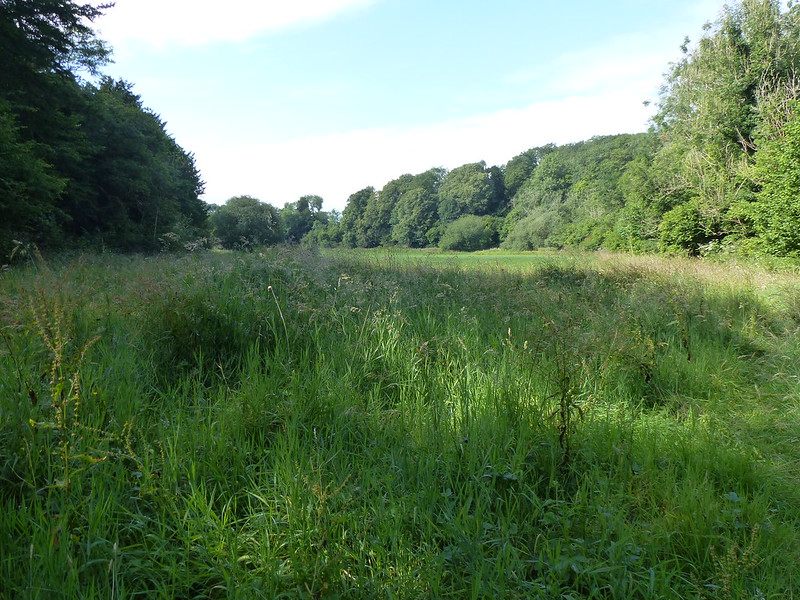
We were at home for a few days before heading off for our big summer trip. I guess we must have been busy, I didn’t get out much, but when the sun shone I did have a wander to Lambert’s Meadow, to see what I could see. Our trip, which I’ll hopefully get to soon, was to the USA. I didn’t take my camera, but I did take a ridiculous number of photos on my phone, so there’s a lengthy selection process ahead.
The photos from this short local wander can be a bit of a dress rehearsal then; I took three hundred, a nice round number, and about par for the course when I spend a bit of time at Lambert’s Meadow.

Of course, there’s a great deal of repetition; my first eleven shots that day were all of Migrant Hawkers; there were several on and around a thicket of brambles where I entered Burtonwell Wood from Silverdale Green. An easy decision in this case, just to crop the most likely looking pictures and then chose my favourite.
On the other hand, this Common Carder bee, on the same set of unripe blackberries, only posed for a single photo.

When I look at the photos which have come up to scratch, although I took quite a lot of photos of bumblebees, of various species, there’s a preponderance of Common Carder bees amongst the ones I’ve chosen. Admittedly, I am a bit biased in favour of Common Carders, for two reasons; firstly their lovely ginger colour, and then the fact that they are relatively easy to distinguish from other common species; but I think that there may be a bit more to it than that; I seem to have more luck getting sharpish images of Common Carders than of other bumblebees; I’m beginning to think that they may linger that little bit longer on flowers than other species.
The single shot I took of the disappearing rump of a Roe Deer in the woods was a bit disappointing, and so is not here, partly because I get much better opportunities to photograph deer in our garden. This tiny spider feasting on a fly, on the other hand, is included because I rarely manage to catch spiders with their prey, even though it was taken in the shade and isn’t especially sharp.
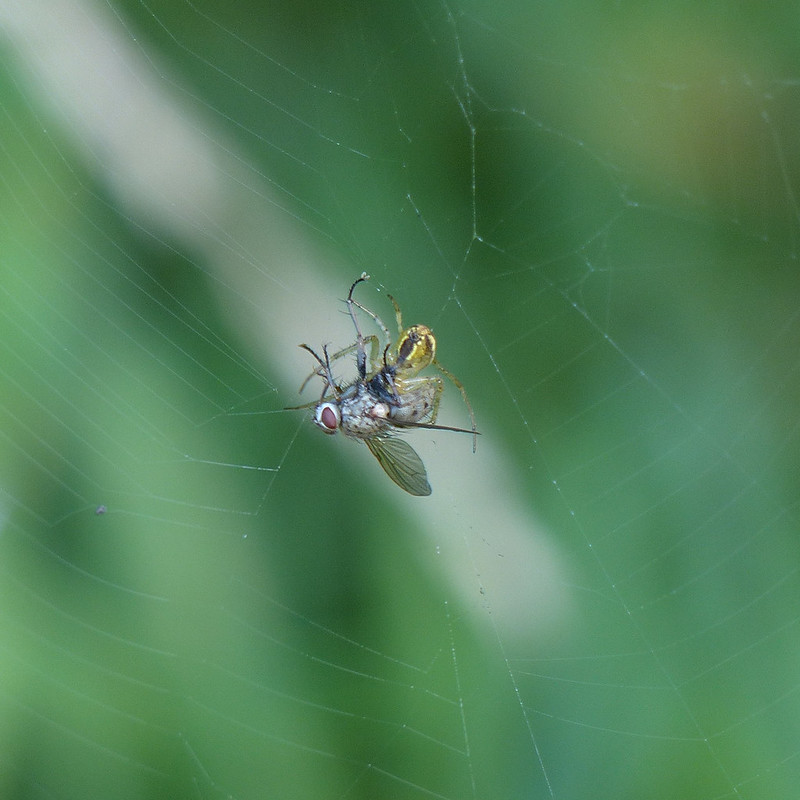
I’ve decided to keep the photos largely chronological, and not to group them thematically, and, for instance, put all of the hoverflies together, something I have done on occasion with previous similar posts.
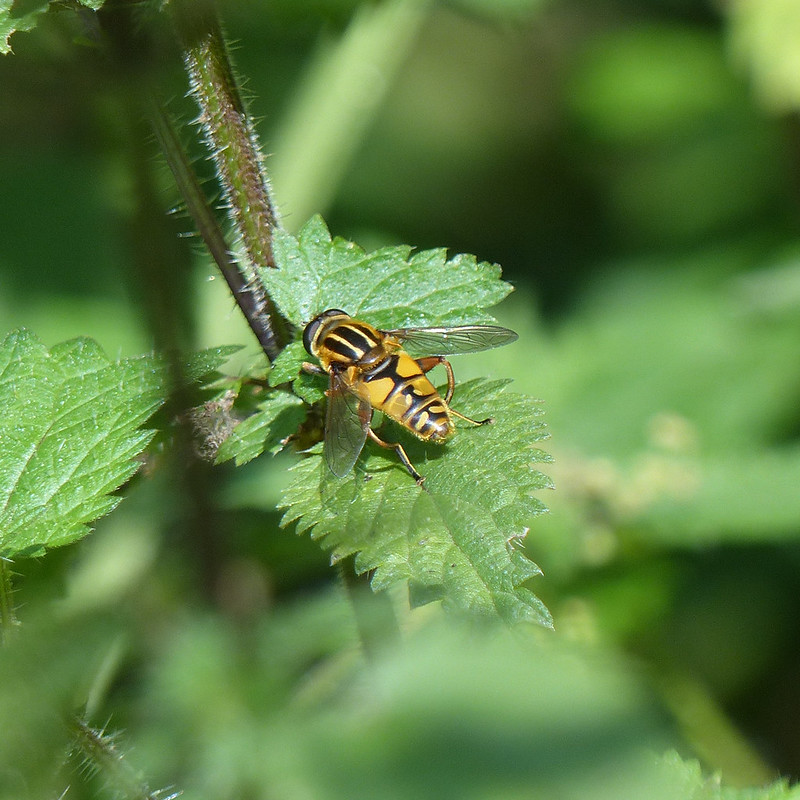
This particular hoverfly might be Helophilus pendulus. Sometimes called ‘the Footballer’ apparently, because of its bold markings. Rather lovely in my opinion. However, there are several very similar species, so I could be wrong. Helophilus means ‘marsh-lover’ which would fit well with this location.
I did put these two snails together, the better to compare and contrast their shells…
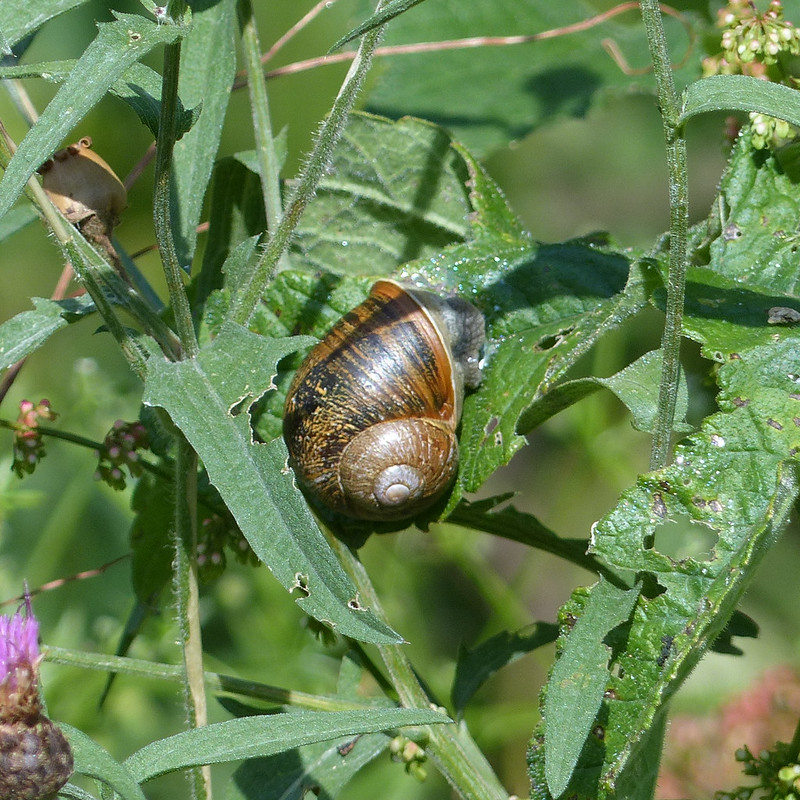
This first is definitely a Garden Snail, with its dark bands on its shell.

My best guess is that this is a copse snail; they are usually more mottled than this, although they do seem to be quite variable.
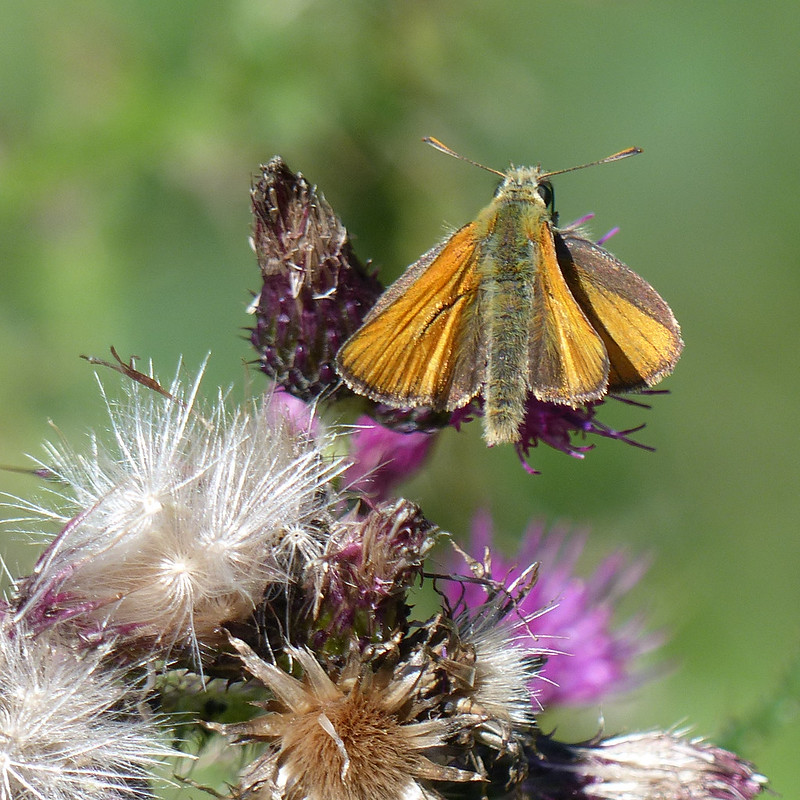
There were lots and lots of butterflies about, which was rather wonderful, although at first I thought none of them would alight long enough for me to get any decent photos. However, if you hang around long enough, your chance eventually comes.
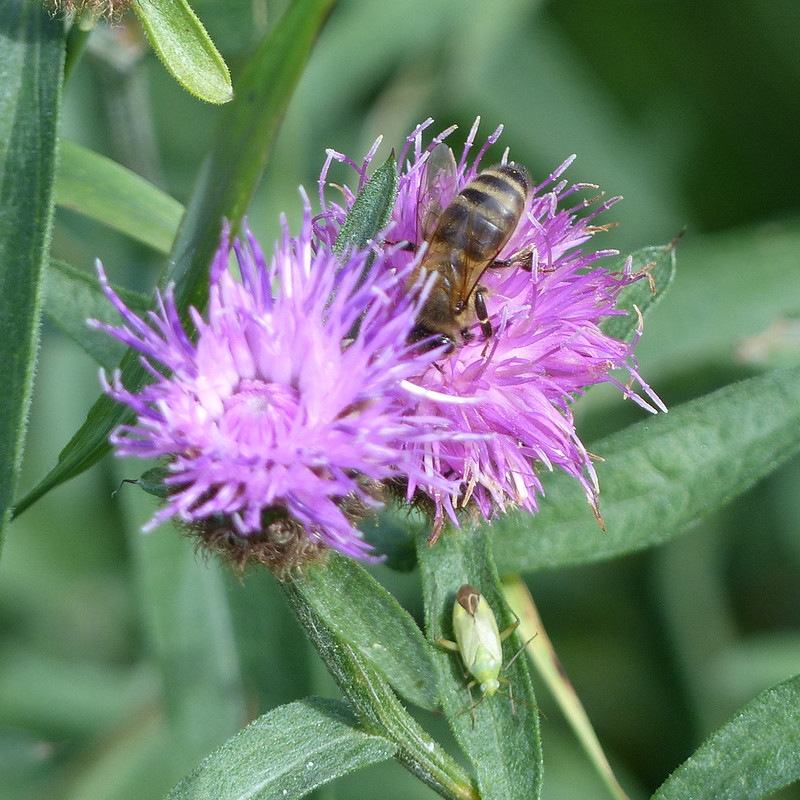
This photo gets in because of the photo-bombing bug. I think the bug might be a Potato Capsid, but my confidence is even lower than usual.
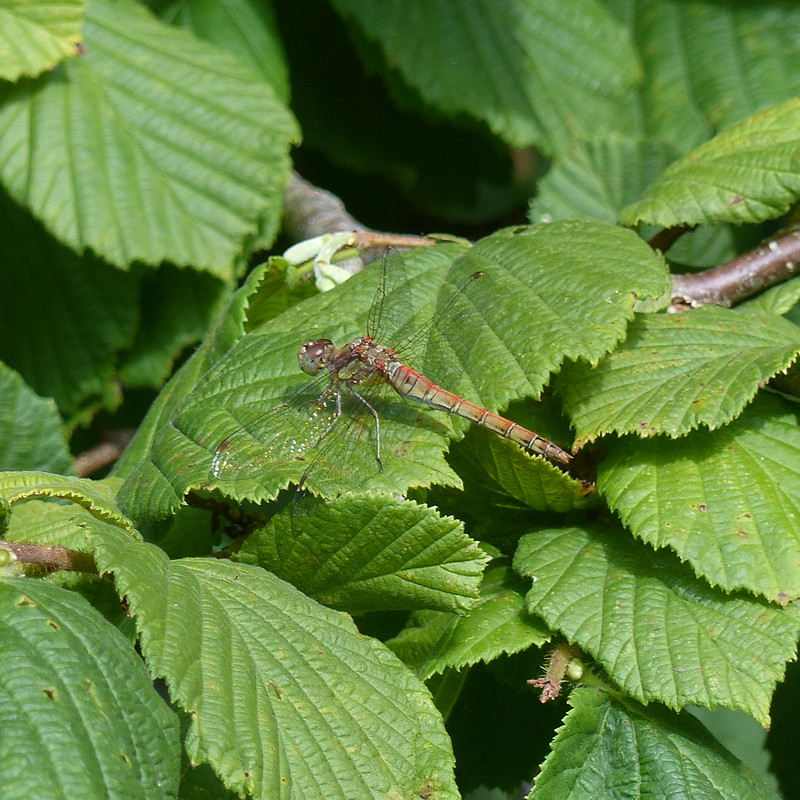
There were lots of dragonflies about too, but they were mostly airborne, and surprisingly difficult to spot when they landed.
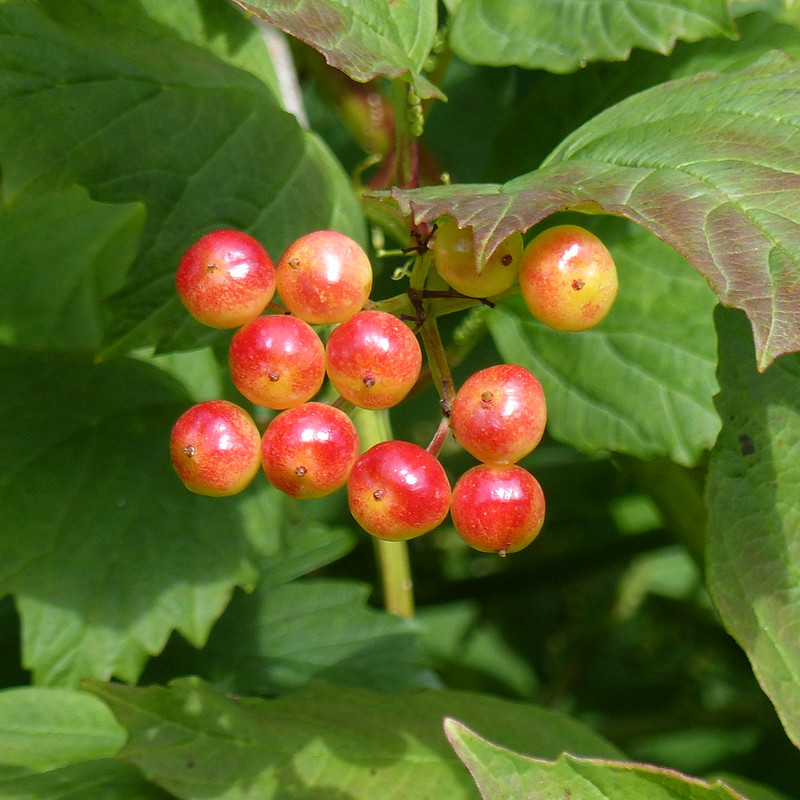

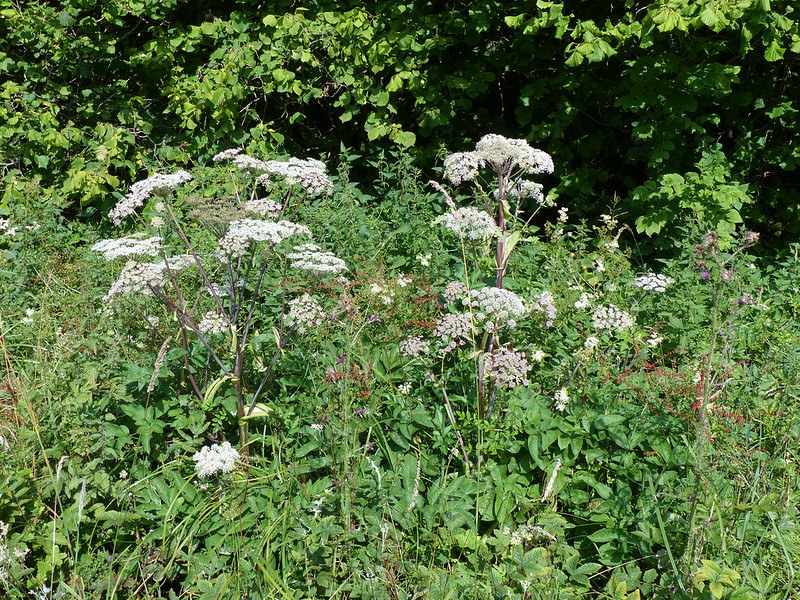

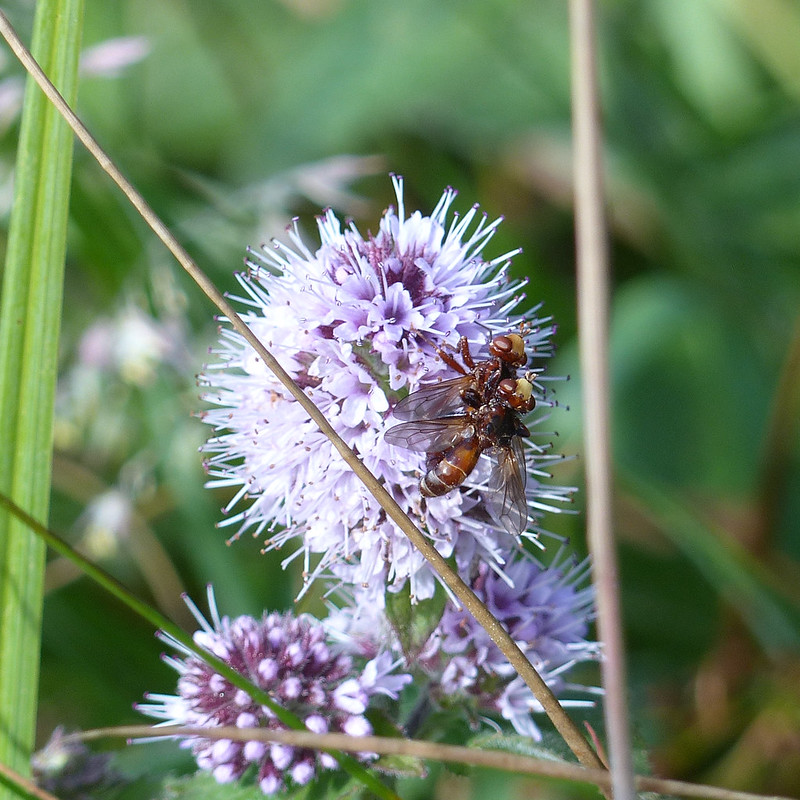
With a bit of lazy internet research, I’ve unearthed two different ‘common’ names for these odd looking flies: Ferrugineus Bee-grabber and Thick-headed Fly. The photo in my Field Guide shows a mating pair and this pair, although they moved around the mint flower a lot, didn’t seem likely to be put-off. In fact when I wandered back around the meadow I spotted a pair, probably the same pair, still mating in much the same spot. The adults feed on nectar, but the larvae are endoparasites, over-wintering and pupating inside Bumblebees.
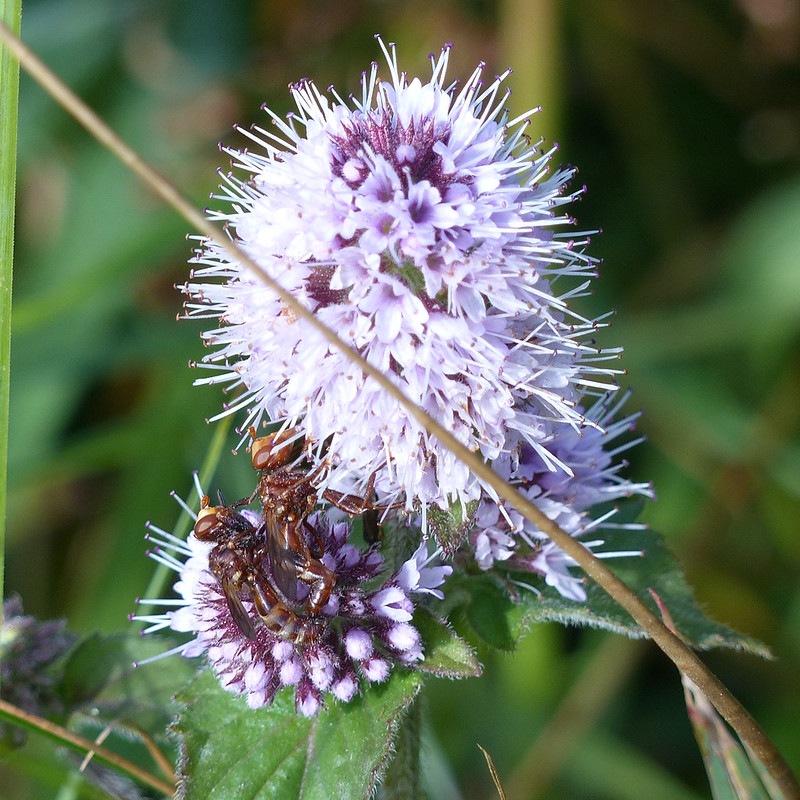
Ferruginous means either: ‘containing iron oxides or rust’, or ‘reddish brown, rust-coloured’; which seems appropriate. I’m guessing that ferrugineus is the latin spelling.
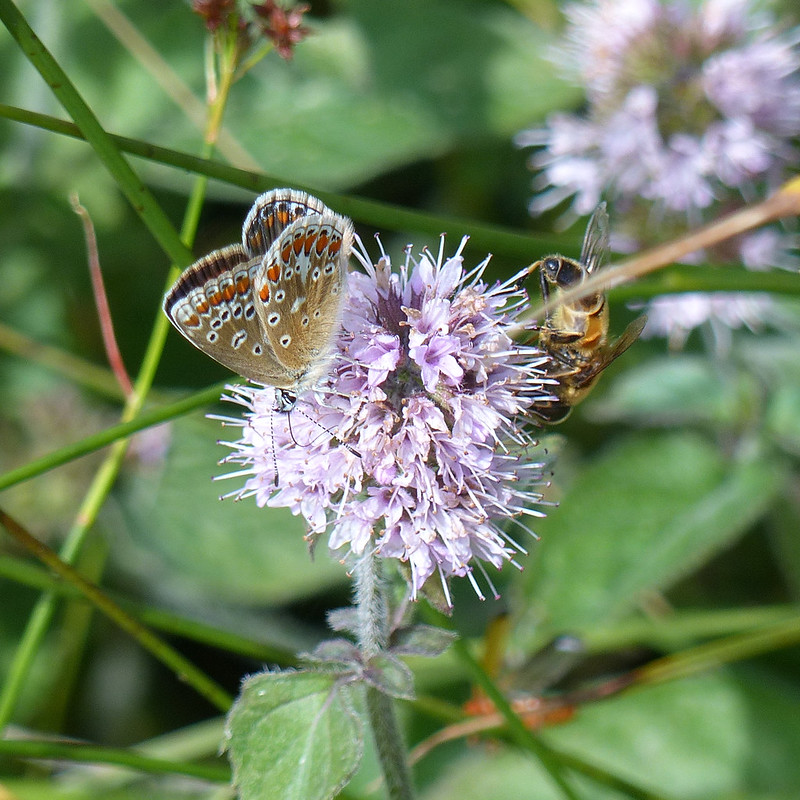
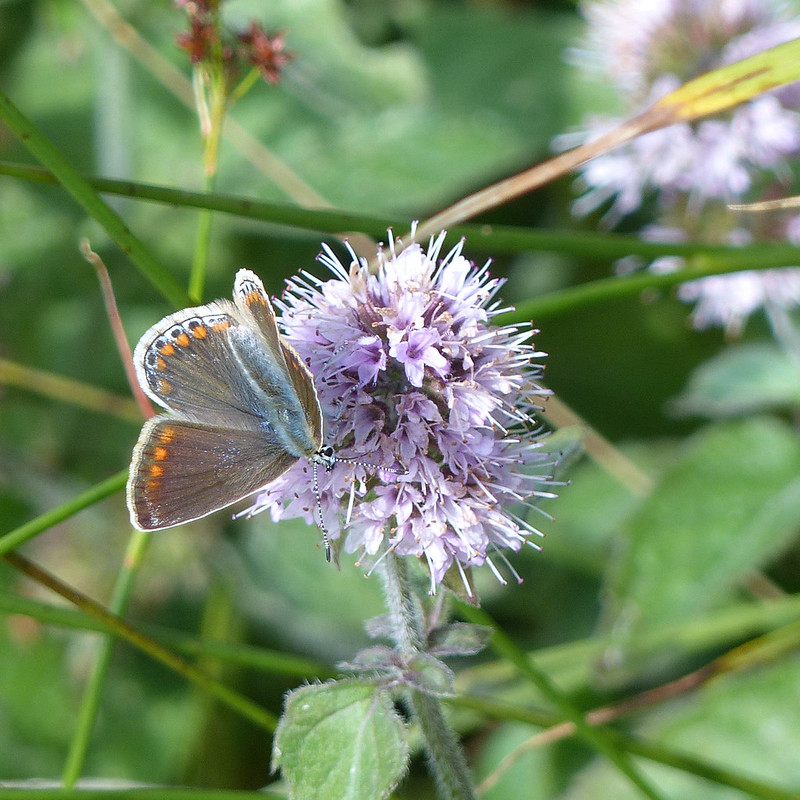
You’ll notice that a lot of the insects are on Mint flowers. Earlier in the year it would have been Marsh Thistles.
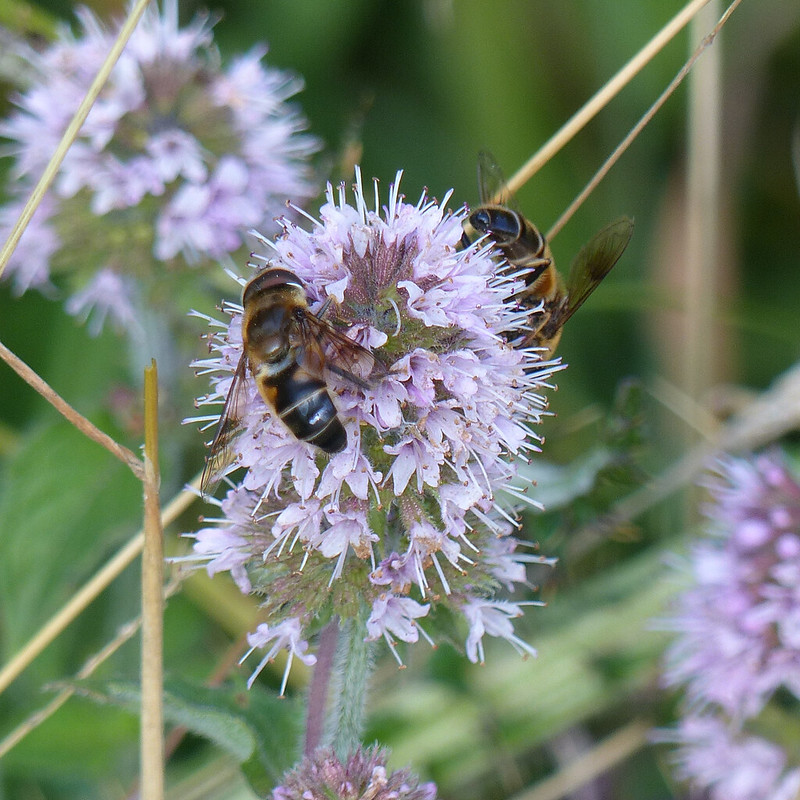
My best guess is that these are Drone-flies. They are excellent Honey bee mimics, but, as far as I know, don’t harm bees in any way, so good for them. More lazy research turned up this titbit:
“Recent research shows that the Drone-fly does not only mimic the Honeybee in look, but also in the way that it moves about, following the same flight patterns.”

I haven’t counted, but I’d be willing to bet that I took more photos of Meadow Browns than of anything else. There were a lot about. I resolved not to take any more photos of what is, after all, a very common and slightly dull species, at which point the local Meadow Brown community seemed to agree that they would disport themselves in front of my lens at every opportunity, in a ‘you know you want to’ sort of way, and my resolve kept crumbling.
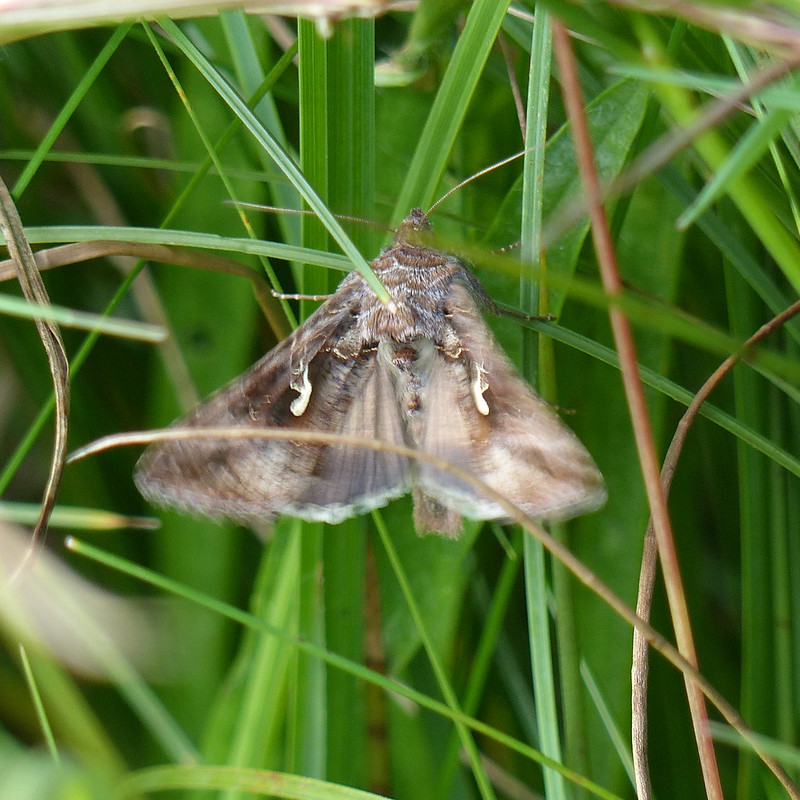
Silver Y moths, on the other hand, seem to stay low in the grass and continually flap their wings, which must be very energy inefficient. Although they breed in the UK, they also migrate here (presumably from mainland Europe).
“The Silver Y migrates to the UK in massive numbers each year – sometimes, an estimated 220 million can reach our shores in spring!”
The scientific name is Autographa gamma which I rather like. And gamma, γ, is at least as good an approximation as y to the marking on the moth.
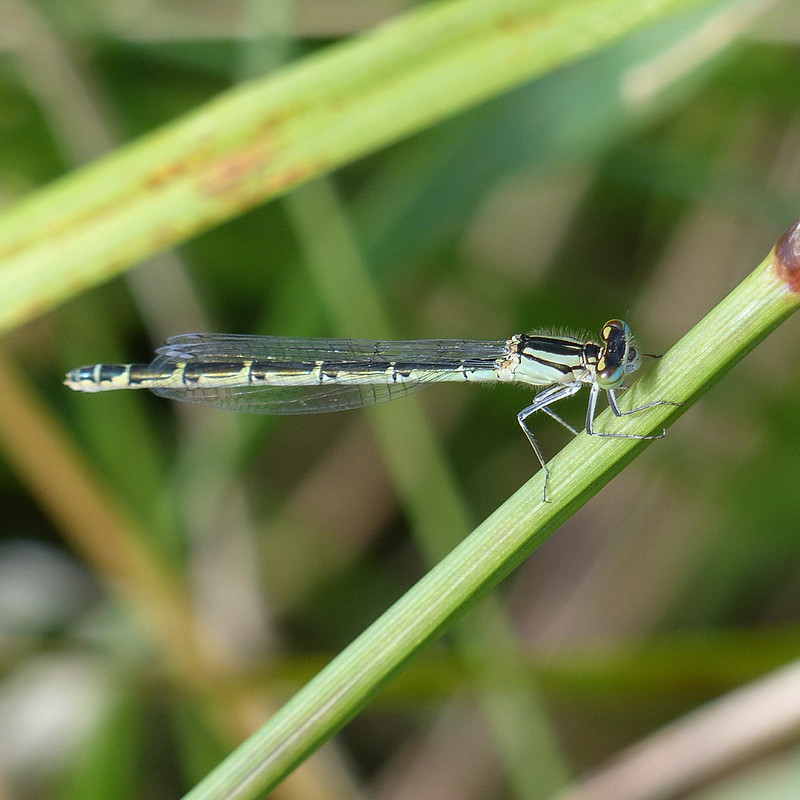

For a while I watched the dragonflies darting about overhead, trying to see where they went when they flew into the trees. Eventually, I did notice the perch of another Migrant Hawker, high overhead…



This damselfly has me a bit confused; it has red eyes, but those beer pump handle markings (my Dragonfly field guide says ‘rockets’ – I think messers Smallshire and Swash need to get out more) suggest the blue-form of the female Common Blue Damselfly, so I’m going for that. This makes me think that I have probably misidentified damselflies in the past. What am I talking about? Of course I’ve misidentified damselflies – I’ve probably misidentified just about everything! All I hope for is that my percentage accuracy is gradually improving – I’ll settle for that.
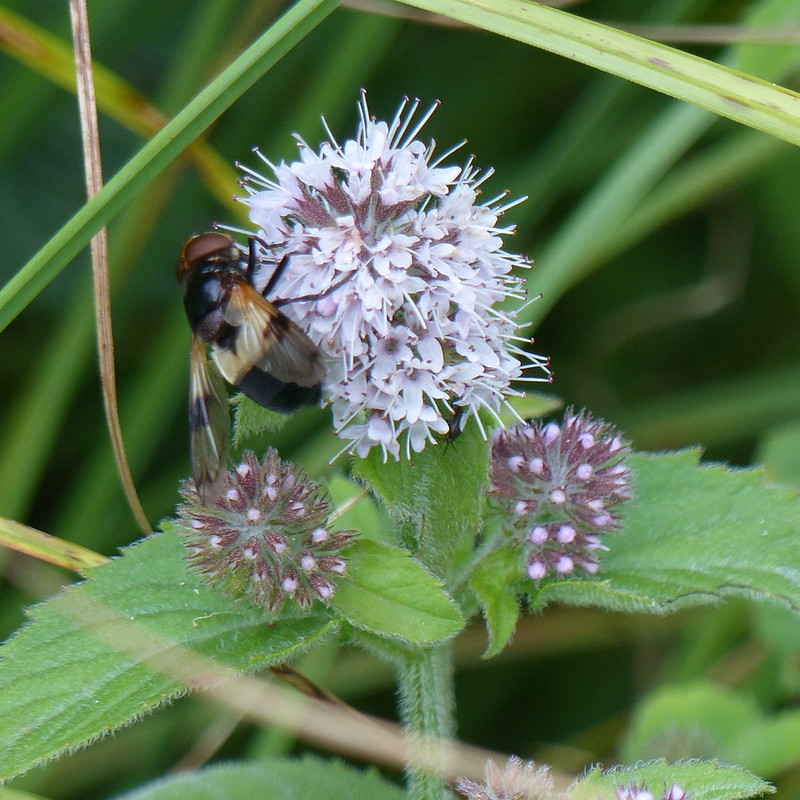

Like the Silver Y, the Comma is named for a mark on its wings, but it’s on the underside so you can’t see it here.
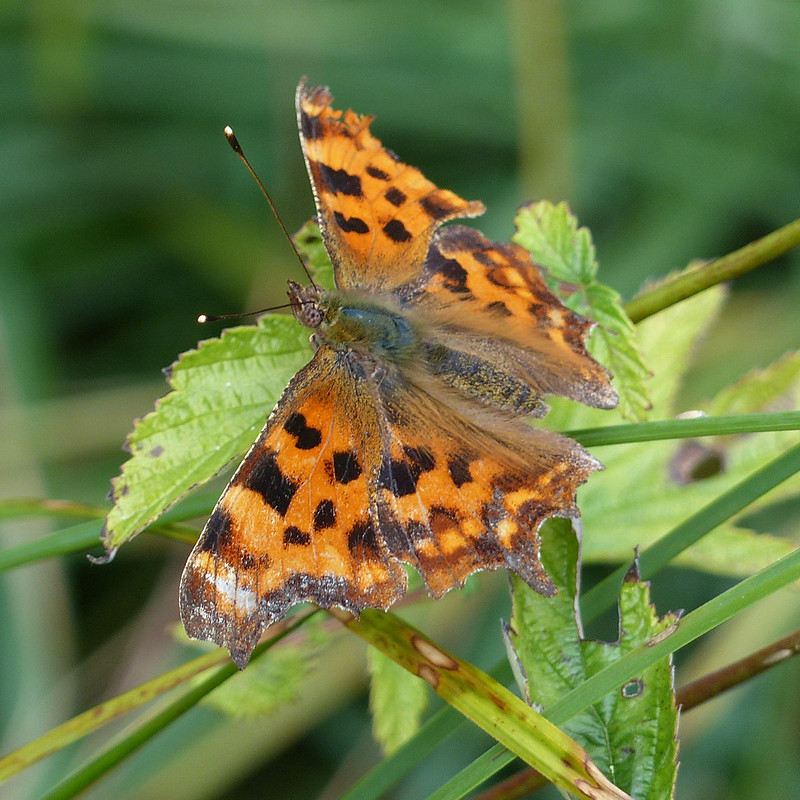
I took lots of photos of rather distant Commas and then this one landed pretty much at my feet, so close, in fact, that I needed to back up a little to get it in focus.
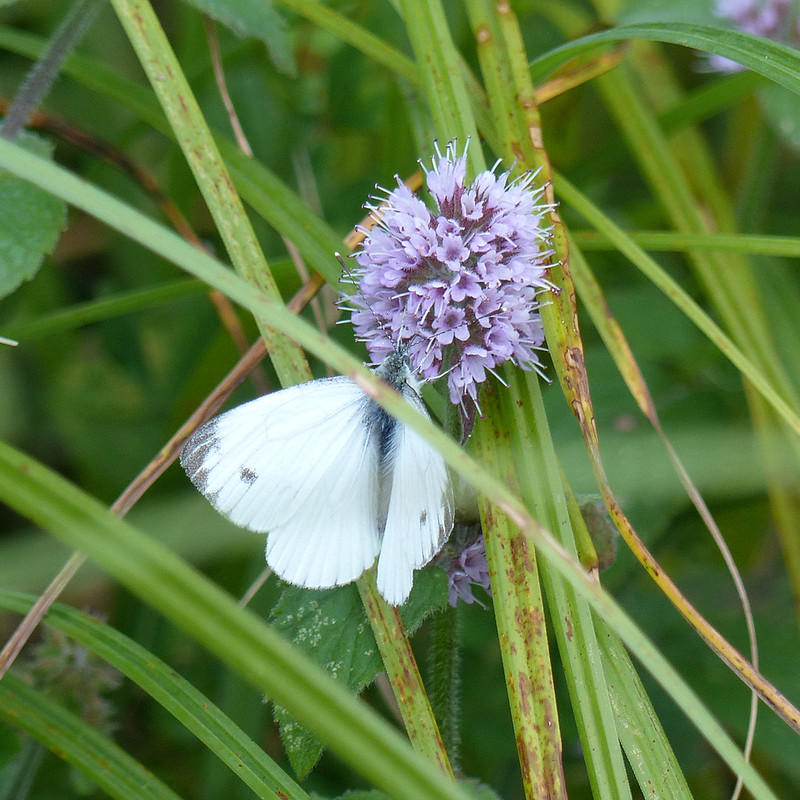
White butterflies don’t often rest long enough to be photographed. They are also very confusing – this could, to my non-expert-gaze, be a Small White, a female Orange-tip, or a Green-veined White. But the underwings reveal that it is a Green-veined White.

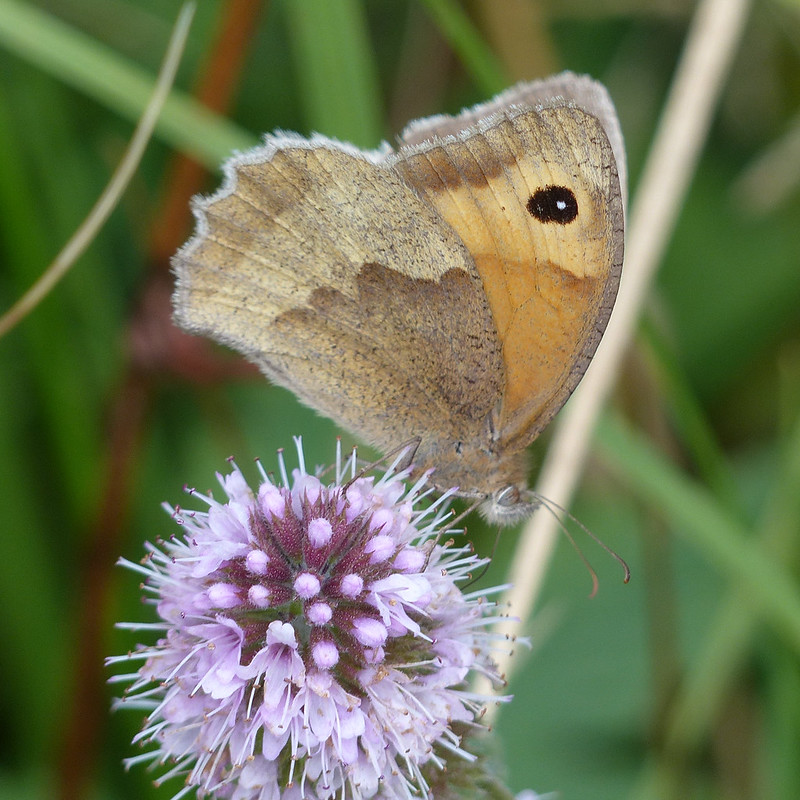
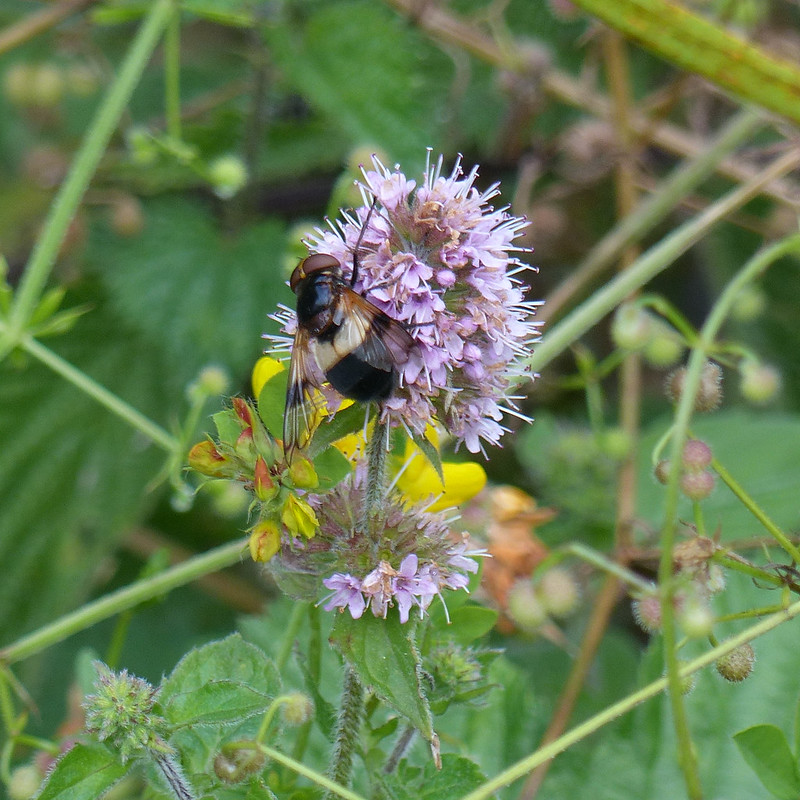
Brambles have a very long flowering season – maybe Pellucid Flies like to branch out when other favoured plants are available.

The sheer variety of Hoverflies is amazing, but also frustrating, because they are so hard to identify. This could be a Drone-fly, but it has dark patches on its wings. I’m edging towards Eristalis horticola but with my usual very low degree of confidence.




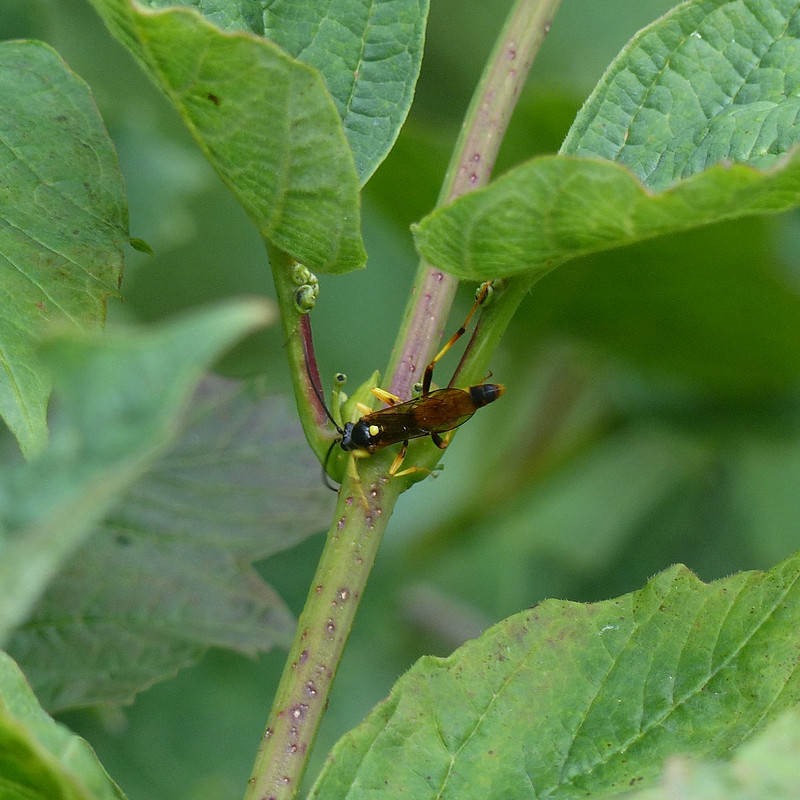
This creature led me a merry dance; it was constantly on the move, roving around the leaves and stems of a Guelder Rose bush, then flying off, disappearing from view, only to return seconds later. At first I thought it was a Sawfly, but it was very wasp-waisted so now I’m inclined to think it was an Ichneumon wasp.
Tentatively, it could be a male Ichneumon extensorius which has the bright yellow scutellum, black unbanded antennae and black and yellow legs and body. However, my online source says “hardly any British records exist for this species”, which is a bit off-putting.

Whatever it is, it kept me well-entertained for a few minutes.

Eugh! A slug! But even this slug, which was on an Angelica stem, has a rather striking striped rim to its foot.
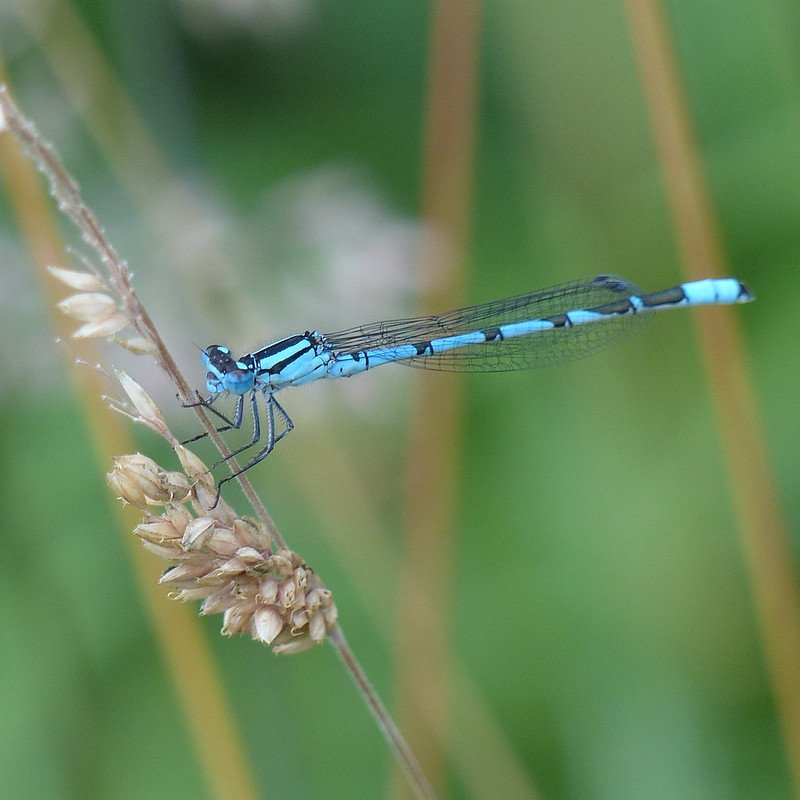

When I spotted this creature, on a Figwort leaf, at first I thought I was seeing another of the yellow and black creatures I had seen before. It has a yellow scutellum, and substantially yellow legs. But – the antennae are orange, it lacks the narrow waist, and its abdomen is heavily striped. It was much more obliging than the previous creature, both in terms of posing for photos and in terms of being readily identified. It turns out this is a Figwort Sawfly.
“The larvae feed on Figwort plants and are usually seen in August and September. The adults are carnivores mainly, hunting small flies and other insects.”
Hmmmm – usually seen in August and September – I think I need to go and have a look at some Figworts.
Incidentally, I was hoping I would see some Broad-bodied Chaser Dragonflies, and usually look out for them in an area of tall plants – Great Willow-herb and Figwort – by the path which crosses the meadow. I didn’t see any, but in looking I noticed that the generally tall Figwort plants were much shorter and less numerous than usual. I suspect they were suffering due to our unusually hot and dry summer.
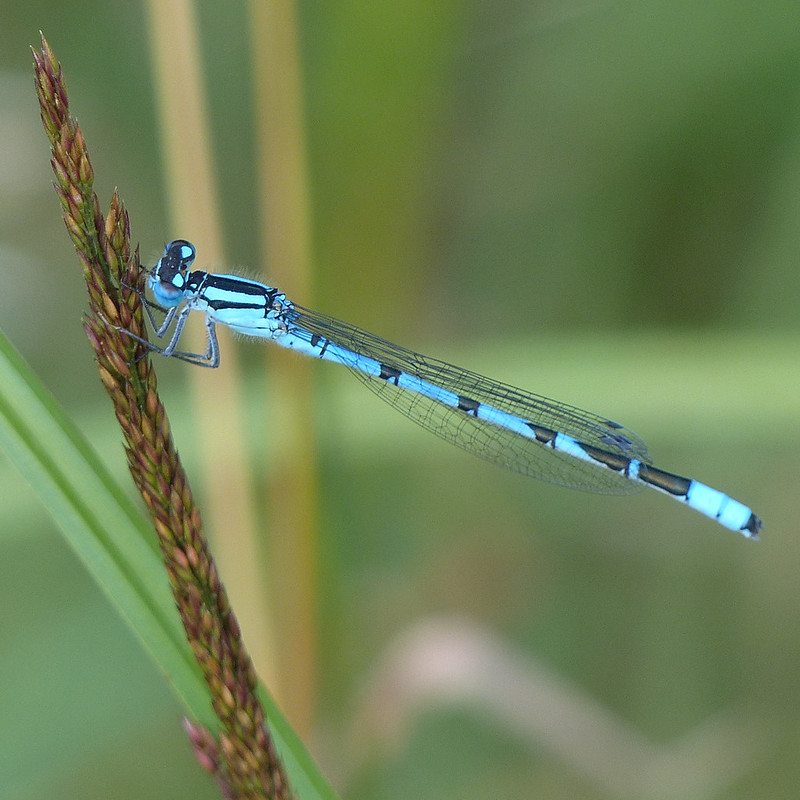
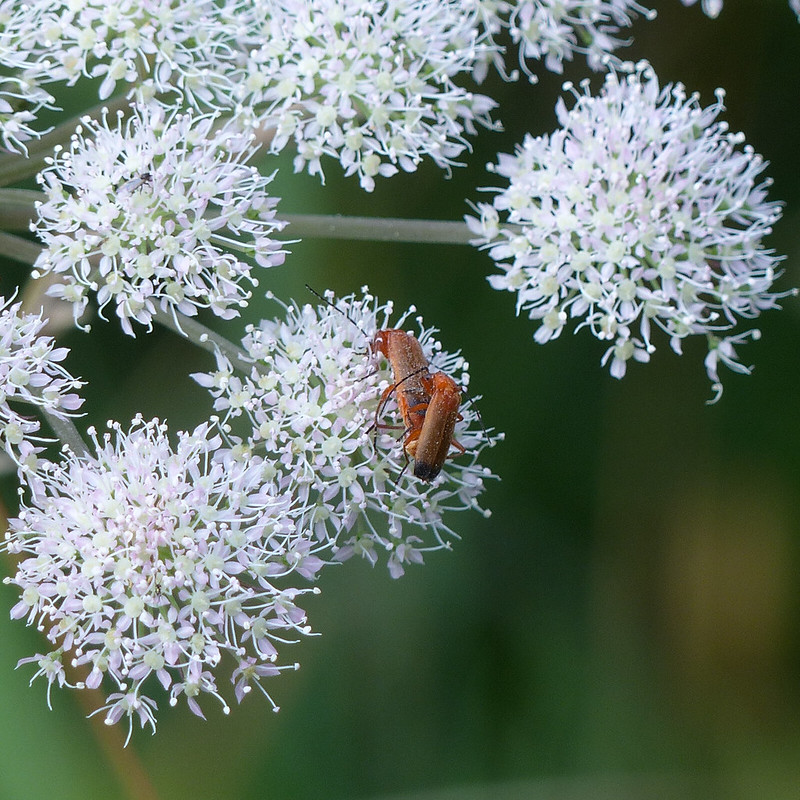
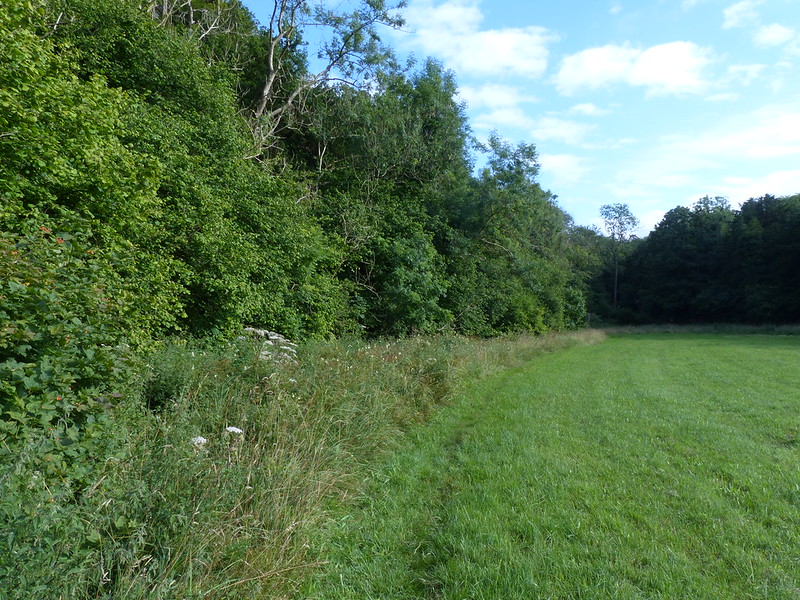



Blimey – I made it to the end! Well done if you did too. If my holiday posts take this long to put together, I will never catch up!
Hagg Wood – The Row – Challan Hall – Hawes Water – Challan Hall Allotments – Silverdale Moss – Back Wood – Leighton Beck – Coldwell Meadows – Coldwell Parrock – Gait Barrows – West Coppice – Hawes Water – Challan Hall – Waterslack – Eaves Wood – Inman’s Road

Covid laid me up for a little over two weeks. Not a pleasant experience, obviously, but it could have been worse. The first week of that fortnight was half-term, we’d planned to meet up with my Brother, who was over from Switzerland with his kids, and my Mum and Dad. We’d also booked a night away to celebrate our twentieth wedding anniversary. All that went out the window. On the plus side, I did listen to a lot of radio dramas.
I also felt like I’d missed out on a half-term’s worth of walking. So, in mid-November, on the Saturday after my first week back at work, when the skies were virtually cloud free, I was itching to get out for a walk.

The autumn colours were splendid, and there was fungi in abundance, particularly in Eaves Wood. I very much enjoyed the views and the light and the sunshine and taking lots of photos.


A drystone wall between the woods around Hawes Water and the meadows by Challan Hall was festooned with Harlequin ladybirds. A non-native species, which arrived in the UK as recently as 2004, they are enormously varied in colour and patterns. The air around the wall was full of them too. As I paused to get some photos with my phone, they began to land on me too. Apparently, they hibernate together in large groups. I assume that this wall, with its many cracks and crevices, is an ideal spot for that.
(Interesting article here)

Whilst I was enjoying the weather and the sights, the walking was another matter. After about a mile, I was already feeling quite fatigued. Anyone with any sense would have turned back, but I kept walking away from home, getting increasingly tired. In the end, I walked a little over six miles, but the last couple were pretty purgatorial – I felt so tired I was tempted to lie down by the path and have a nap.

After this walk, I took it easier for a couple of weekends and have been okay since, except it took a while for my senses of smell and taste to come back, and now that they have some foods which I formerly enjoyed now taste revolting; peanut butter springs to mind, which used to be a favourite. Almonds too. Curiously, the things which taste bad all have the same foul flavour.

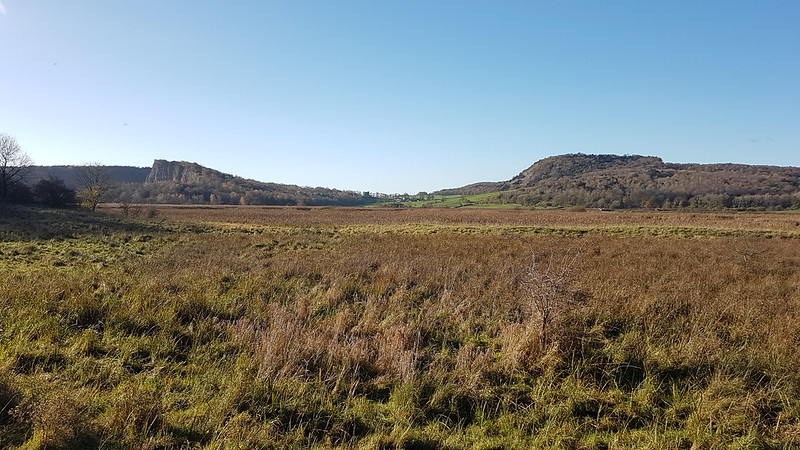
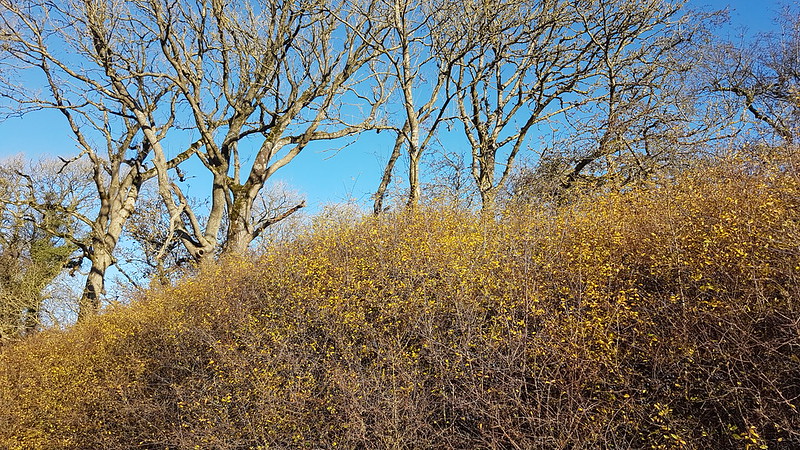
Anyway, back to the walk – I was taken by the contrast of the yellow leaves of the Blackthorn thicket and the blue sky behind, but also by the abundance of Sloes on the Blackthorn…
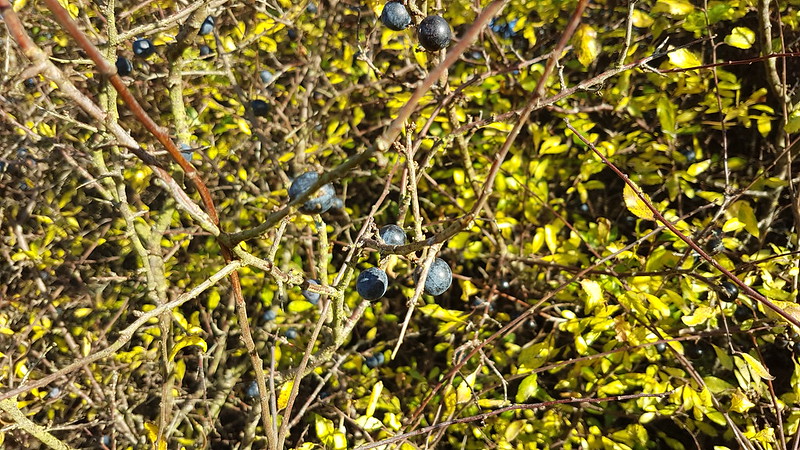

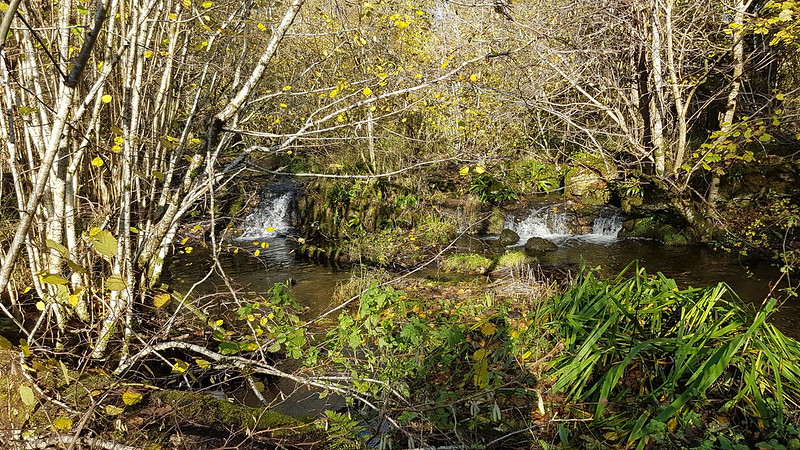
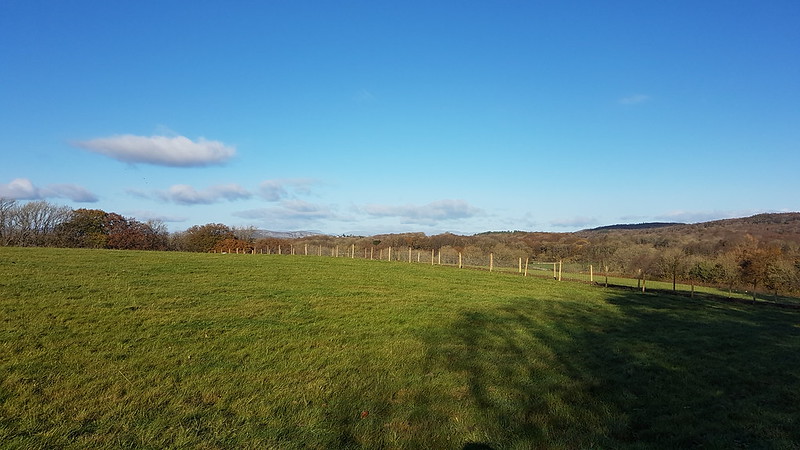
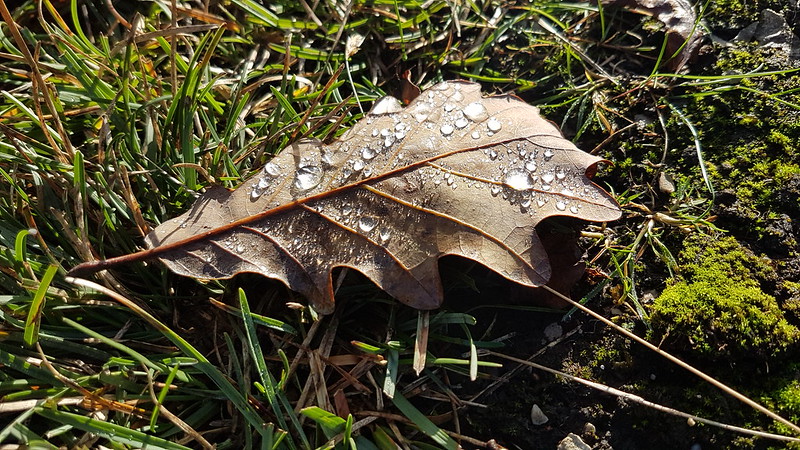
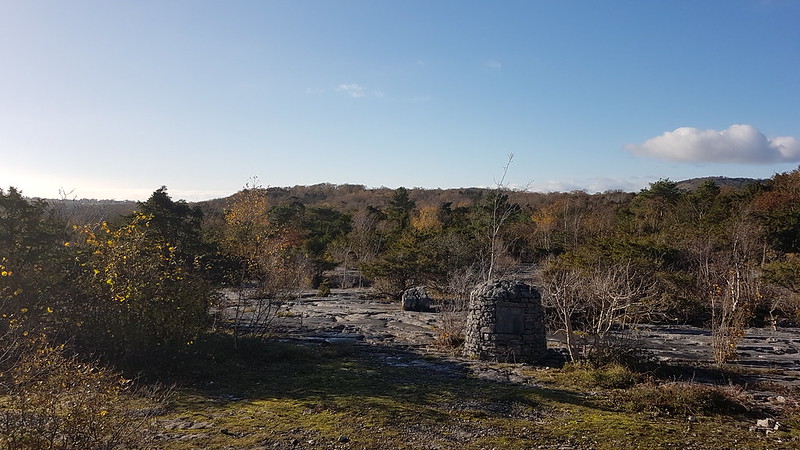
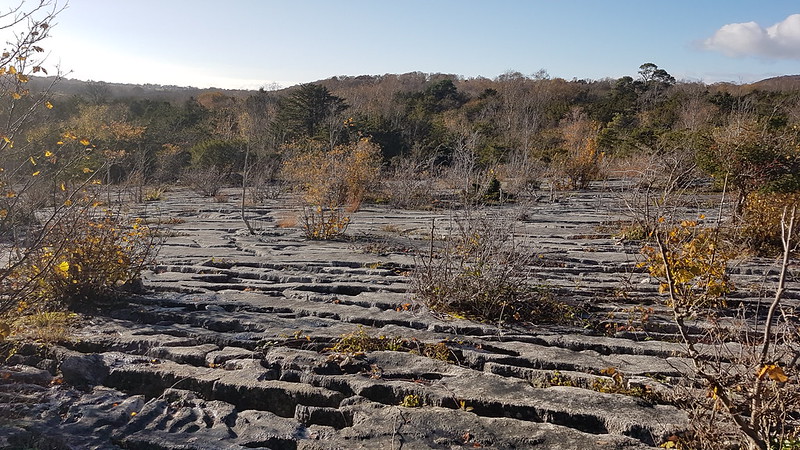

This bench, near Hawes Water was very welcome and I sat on it for quite a while, although it was fairly wet.
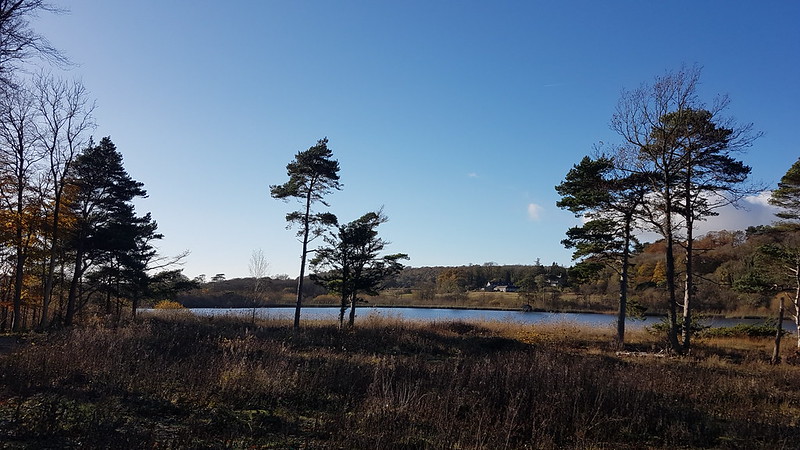
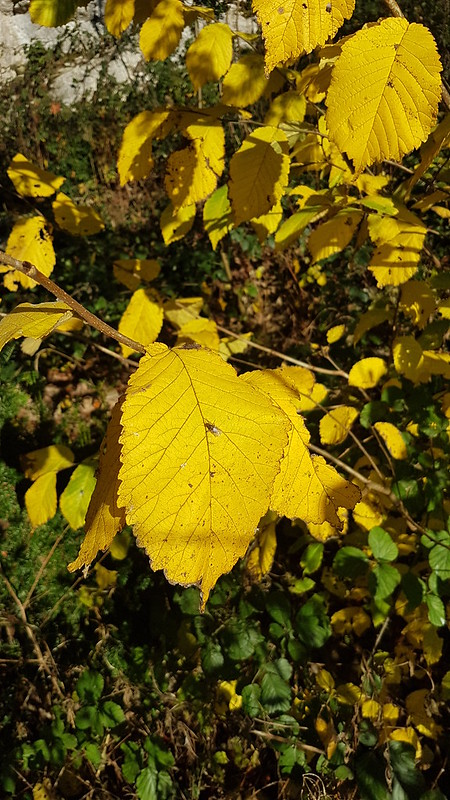
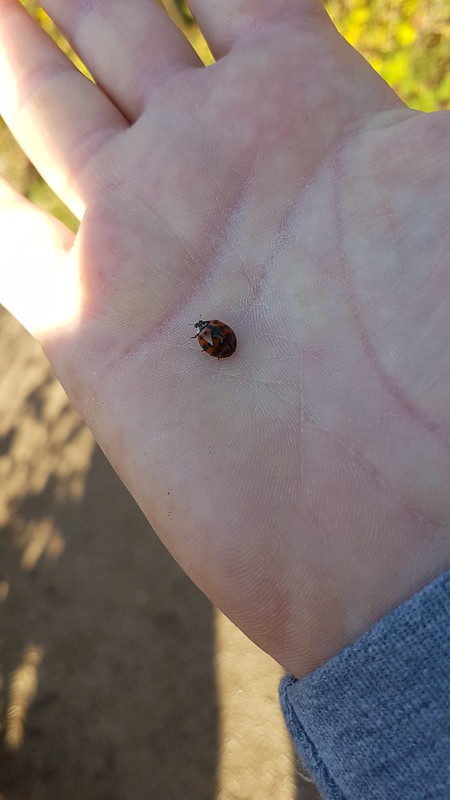
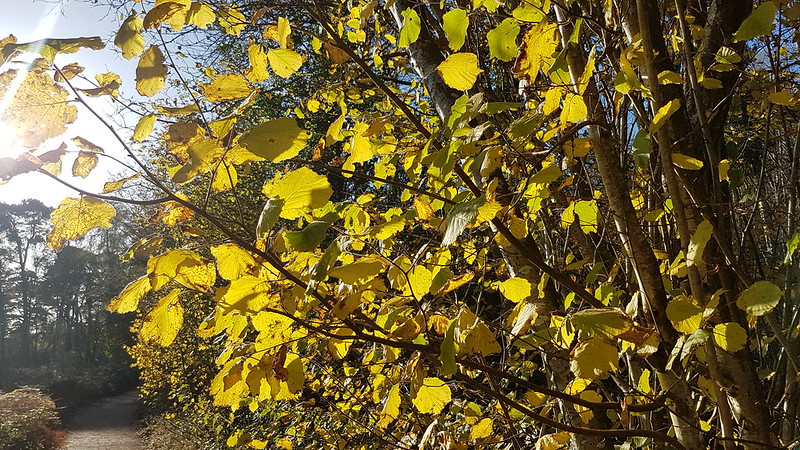


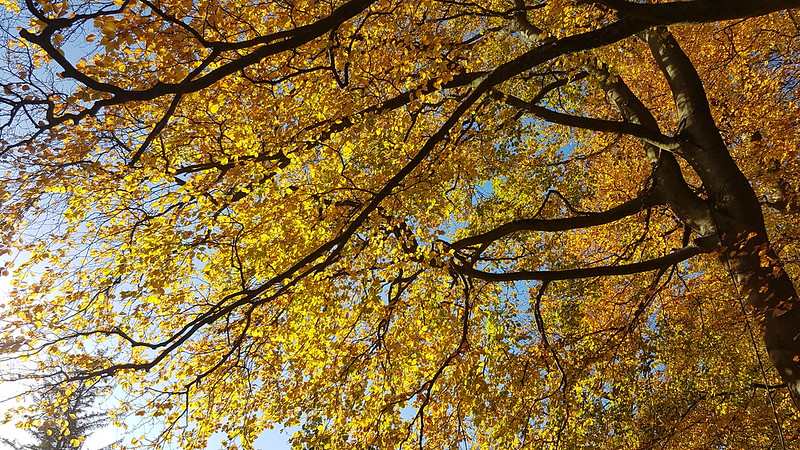
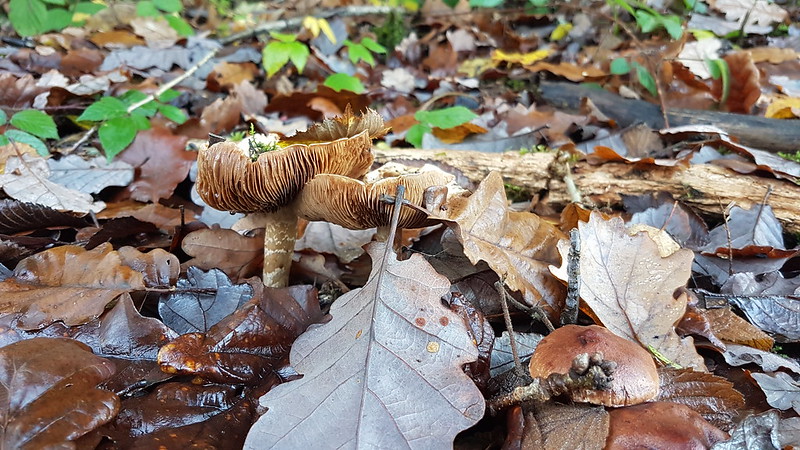
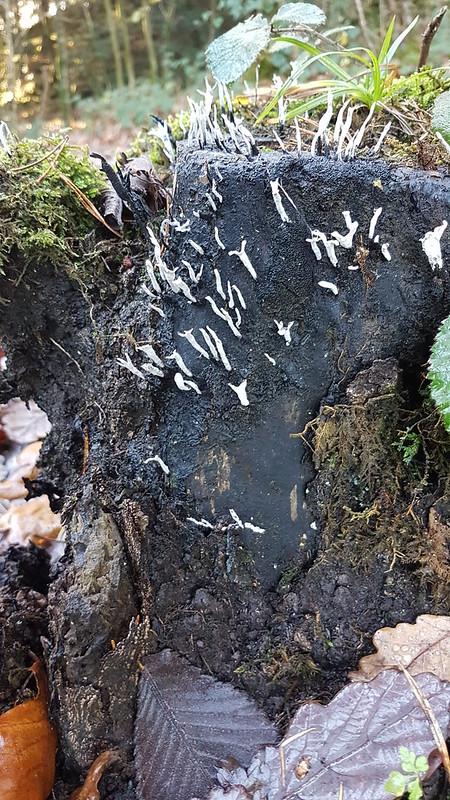
There was an absolute riot of fungi in Eaves Wood, fascinating to see, but extremely difficult to identify.
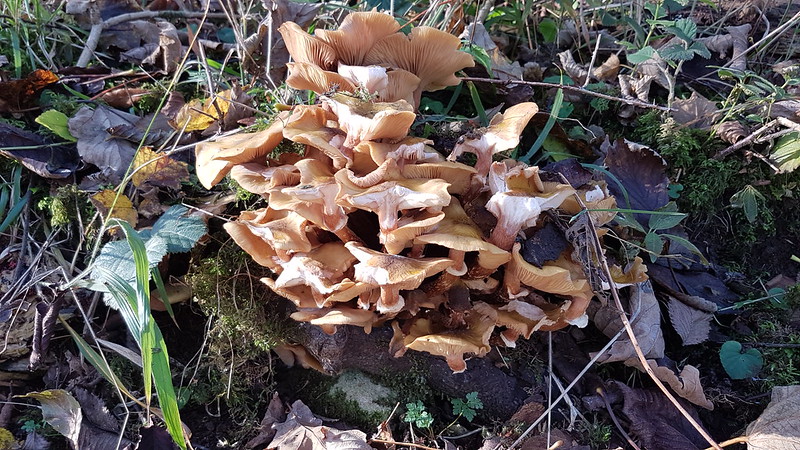
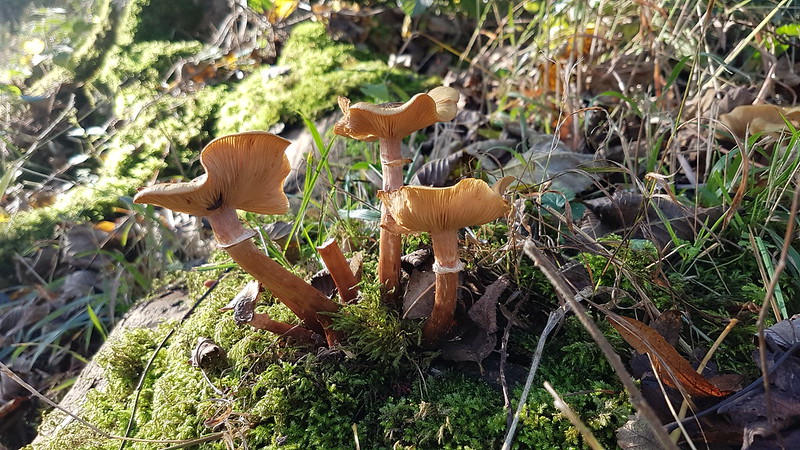

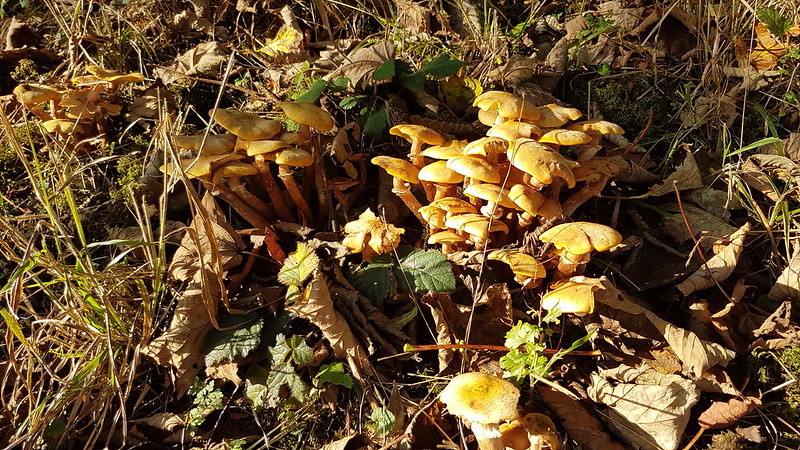

Unusually, I think I’ve enjoyed this walk more in retrospect than I did at the time. Can’t wait for some more bright and sunny days.
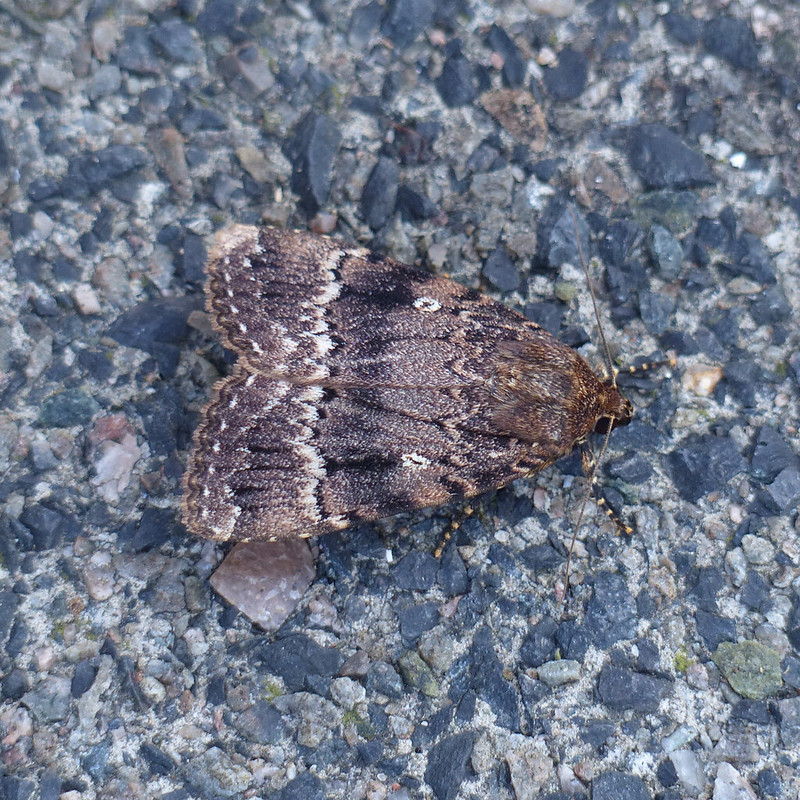
The day after my Hawes Water wander. Another attempt to replicate the fun I had in the meadows of the Dordogne. It started, in rather gloomy conditions, in our garden.
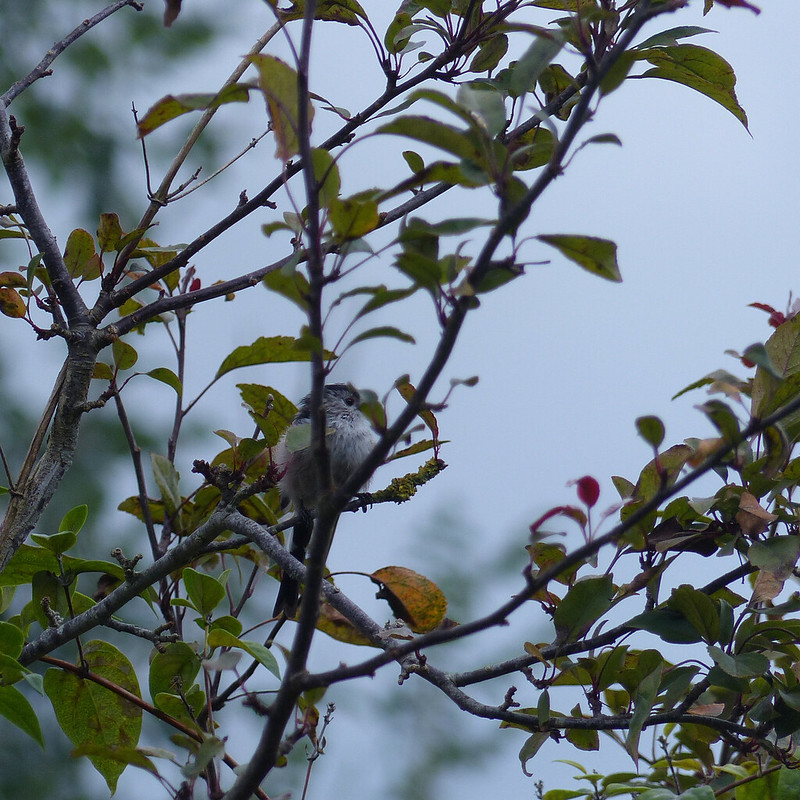
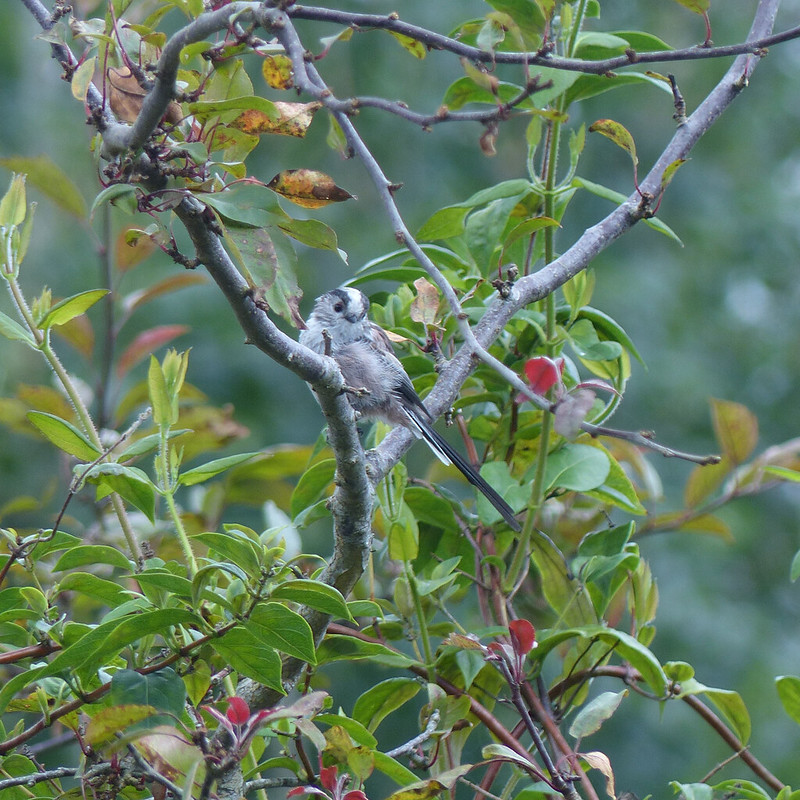

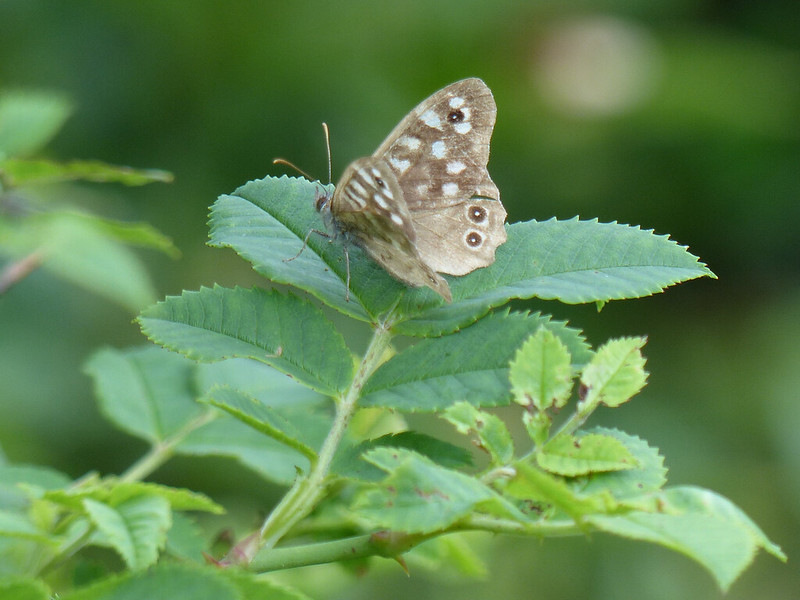

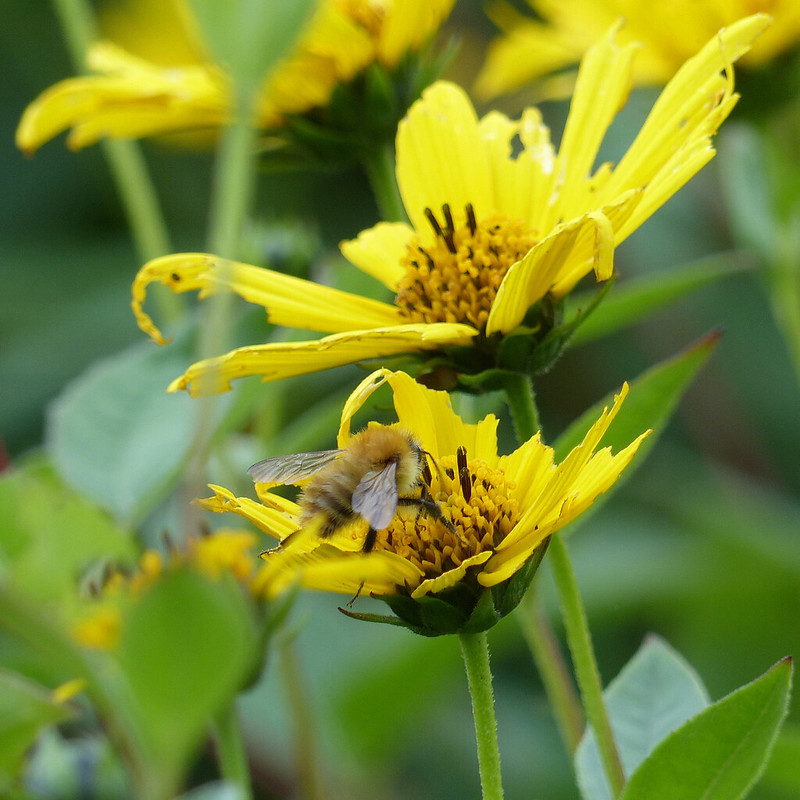
When the weather brightened up, I set-off for a short wander, taking in Lambert’s Meadow, my go to spot when I’m hoping to see dragonflies in particular, and a wide selection of insect life in general, and a trip to the Dordogne is not on the cards.
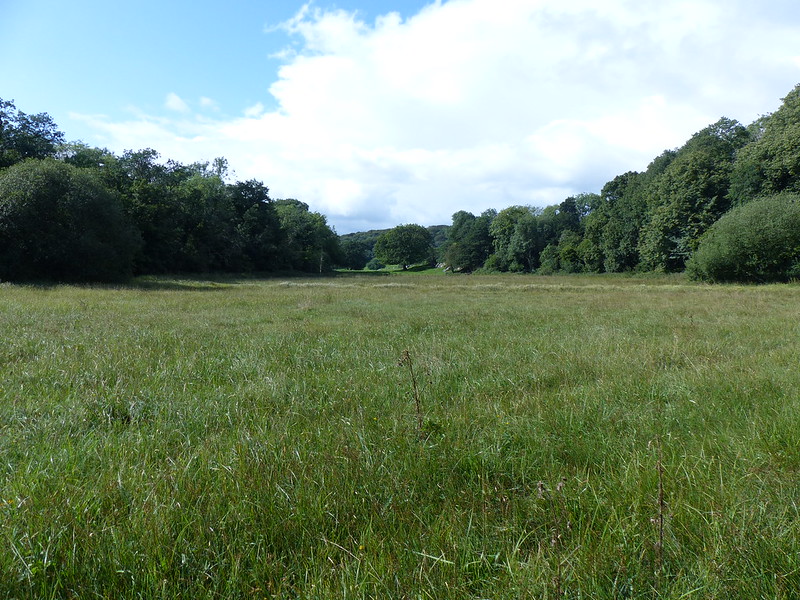
In my post about the meadows around the campsite we stayed on in France, I began with a photo in which I’d caught five different species all in the one shot, which I was delighted by, because it seemed to represent to me the sheer abundance and variety of the wildlife to be seen there.
I’ll confess, I was bit shocked that Lambert’s Meadow could match that tally…
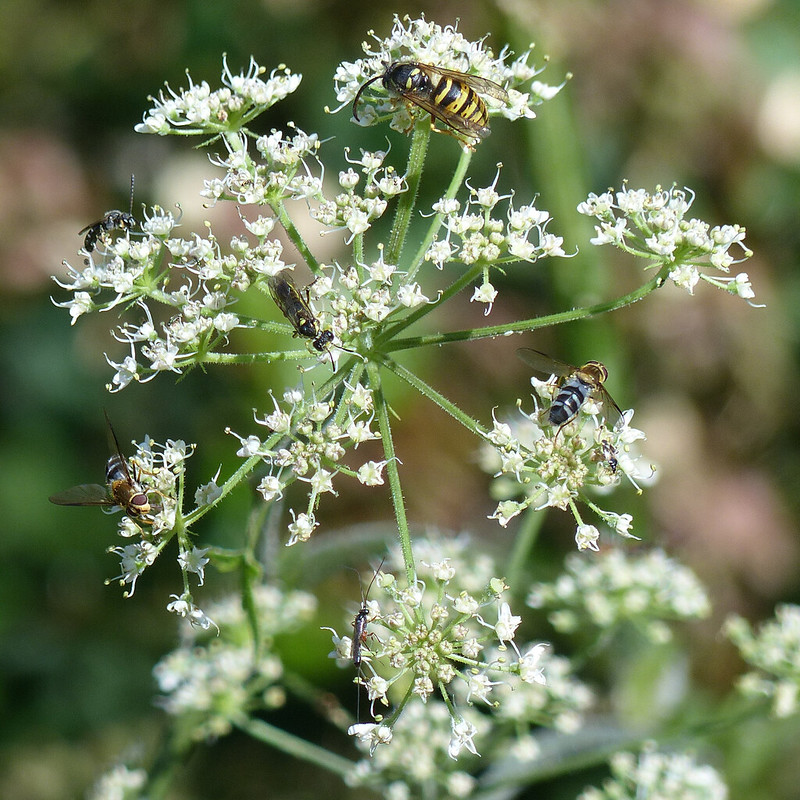
So…what have we got here? I think that the two black and white hoverflies may be Leucozona glaucia. I think the bug closest to the middle could be the sawfly, Rhogogaster Picta. I wondered whether the tiny insect at the bottom might be a sawfly too, but the long antennae and what looks like an even longer ovipositor have persuaded me that it is probably some kind of Ichneumon wasp. But that’s as far as I’ve got (there are apparently approximately 2500 UK species). I think the social wasp at the top is probably Vespula Vulgaris – the Common Wasp. And about the insect on the top left I have no opinions at all – there isn’t much to go on.
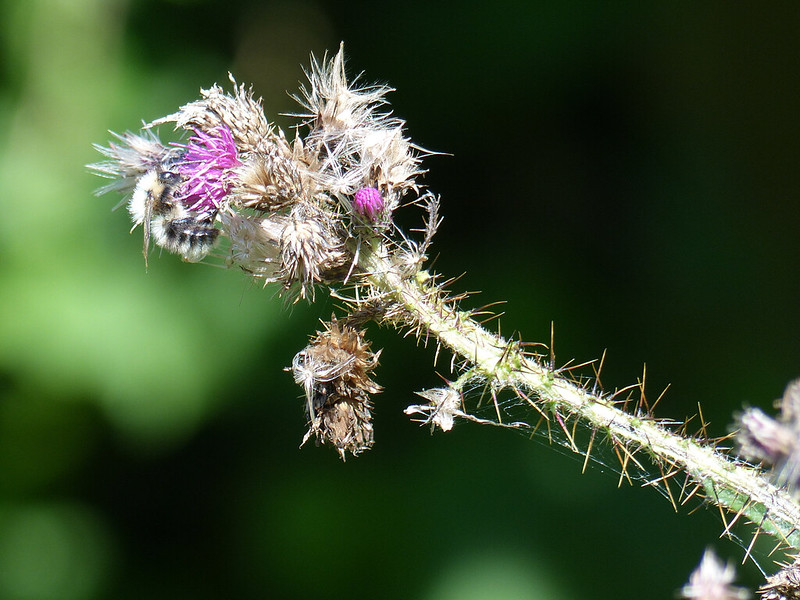
I always assume that very pale bees like this are very faded Common Carder bees, but I’m not at all sure that’s correct.

I think this might be a Large Rose Sawfly, although surprisingly it seems like there might be several UK species of insects which have a striking orange abdomen like this. I’m also intrigued by what the funky seedheads are. I suspect that if I’ve written this post back in August, I probably would have had a pretty fair idea because of where they were growing in the meadow.
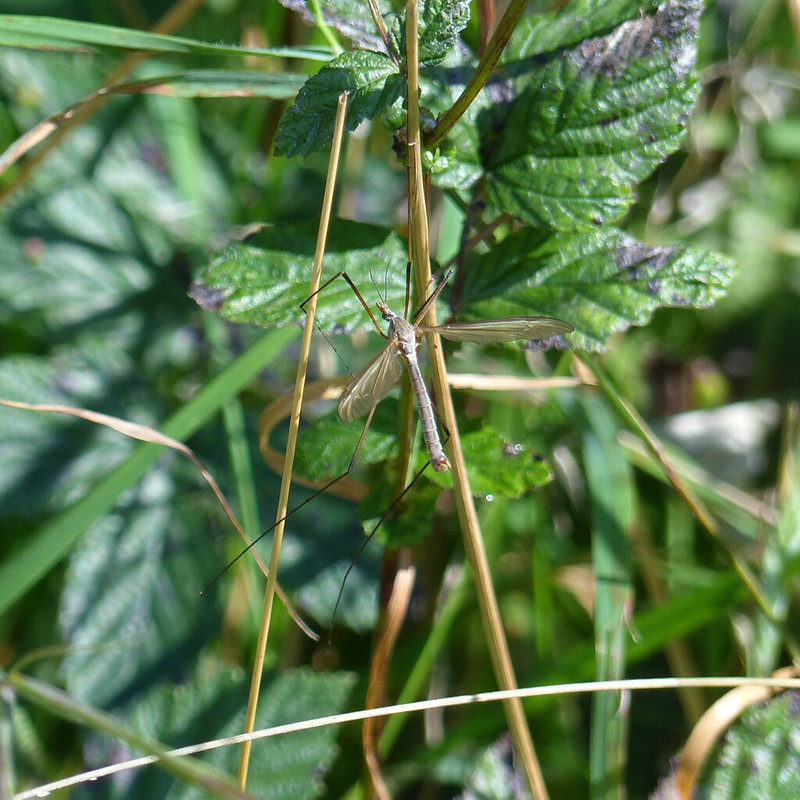
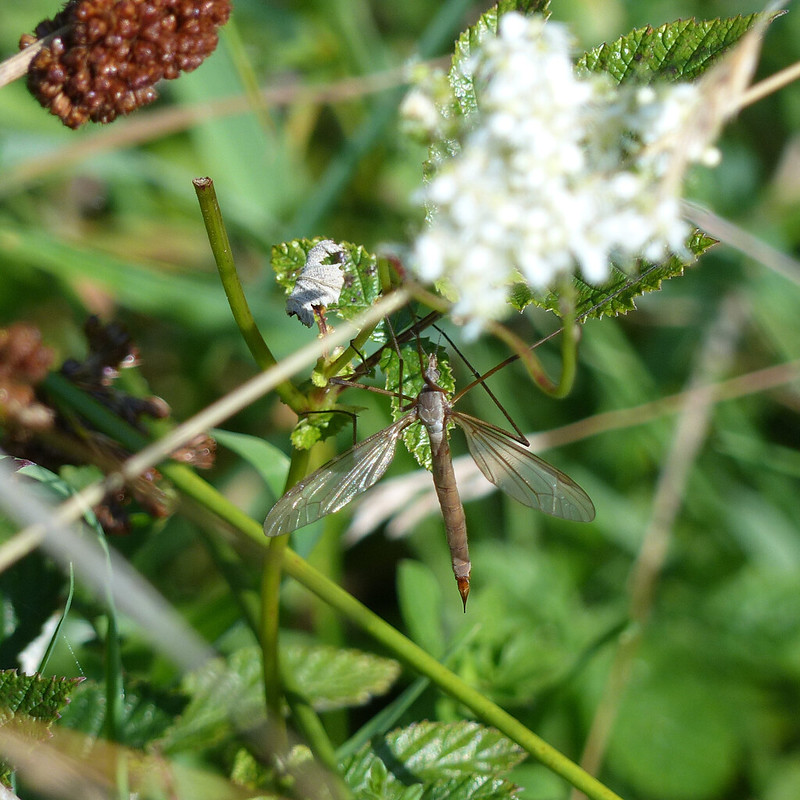
There’s around 300 species of cranefly in the UK. Me putting names to these is essentially a huge bluff – I have even less idea than usual. I’m reasonably confident that they are at least craneflies and that the first is a male and the second female, but after that I’m pretty much guessing, based on a little bit of internet research.
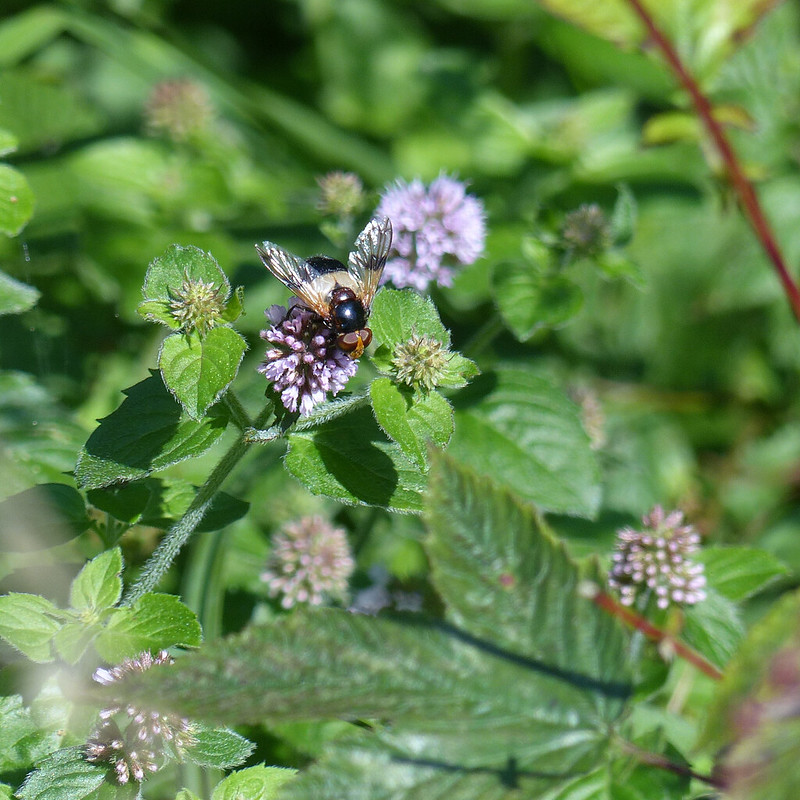
This is a hoverfly which I often see and which is sufficiently distinctive that I can actually be confident about my identification. Especially since I found this very helpful guide. The common name is apparently Pellucid Fly, which is odd; pellucid means translucent or clear, as in a pellucid stream, or easy to understand, as in pellucid prose. I’m not sure in which sense this fly is pellucid. The females lay their eggs in the nests of social wasps like the Vespula Vulgaris above. The larvae grow up in the nest, from what I can gather, essentially scavenging – so a bit like wasps round a picnic table. Even wasps get harassed!
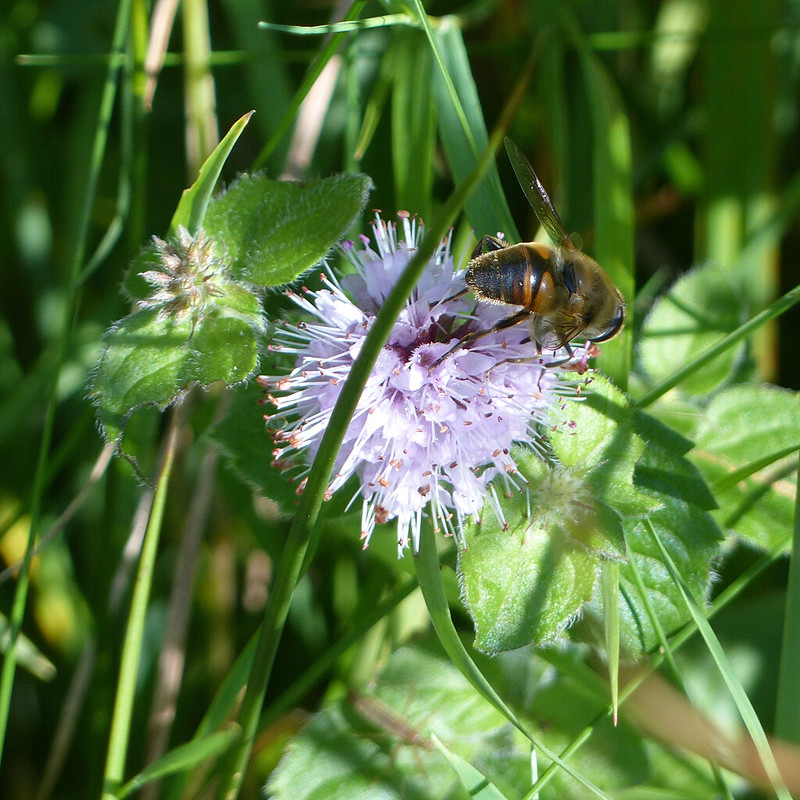
I am going to have to bite the bullet and shell out for a proper field guide to hoverflies I think. They are so fascinating. Well, to me at least! These two, at first glance both black and yellow, but then so differently shaped and patterned, but I don’t have a clue what species either might belong to.

This, on the other hand, also black and yellow……

…is clearly not a hoverfly. Don’t ask me how I know. Well, go on then: it’s extremely bristly, and it has a chequered abdomen. At least it’s quite distinctive. My ‘Complete British Insects’ describes it as ‘handsome’ which even I can’t quite see. It’s a parasitoid, which is to say that its larvae will grow up inside a caterpillar.
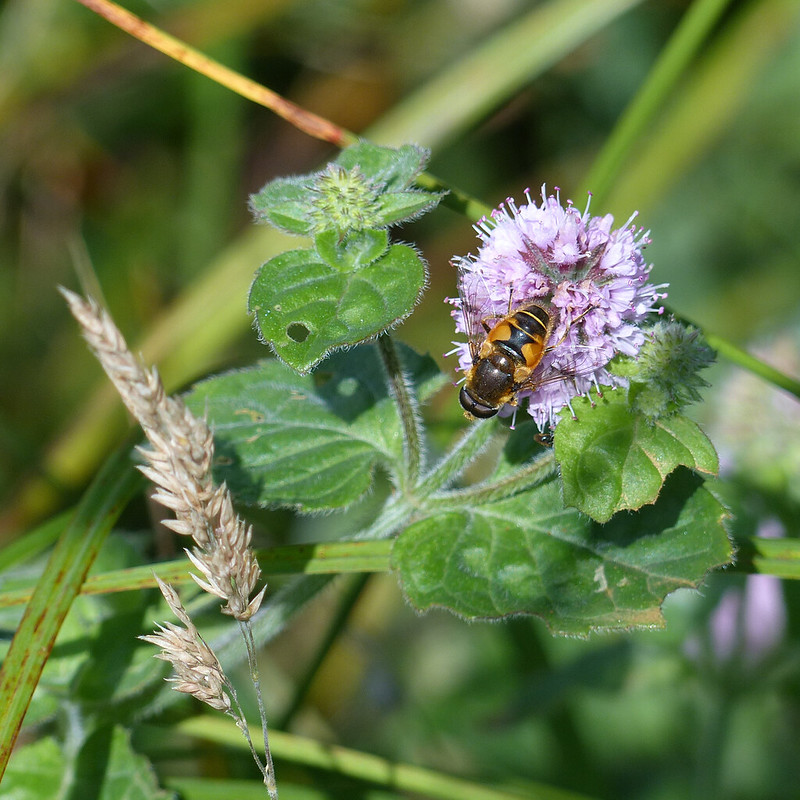
Apparently Eristalis arbustorum “can have quite variable markings on its body and some can be almost totally black”. (Source) Which makes my heart sink a bit – what hope do I have if members of an individual species can vary so much? At least this genuinely is handsome.
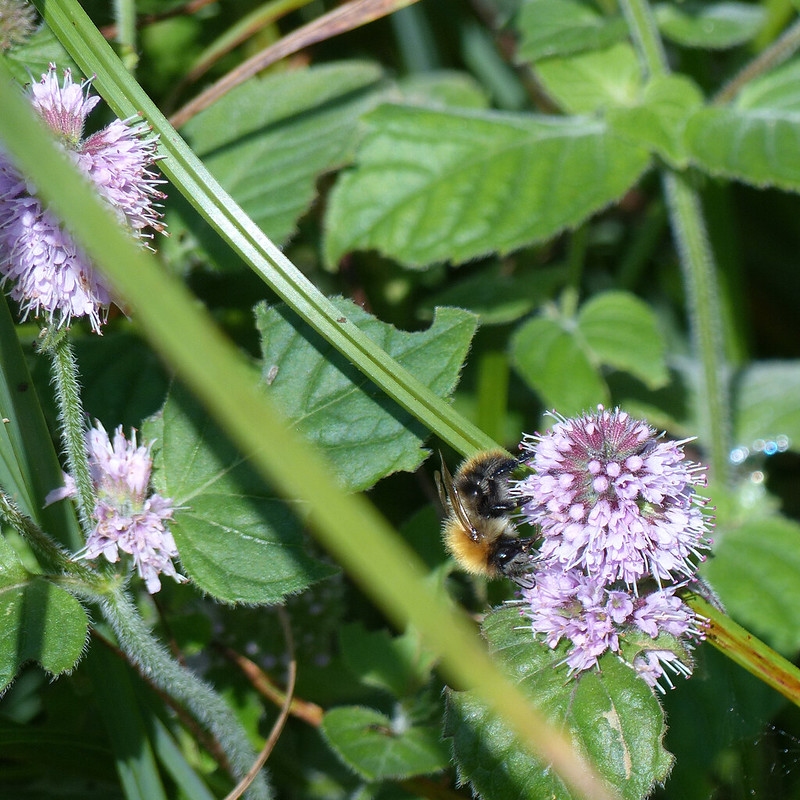
A couple more unidentified bees to throw in.
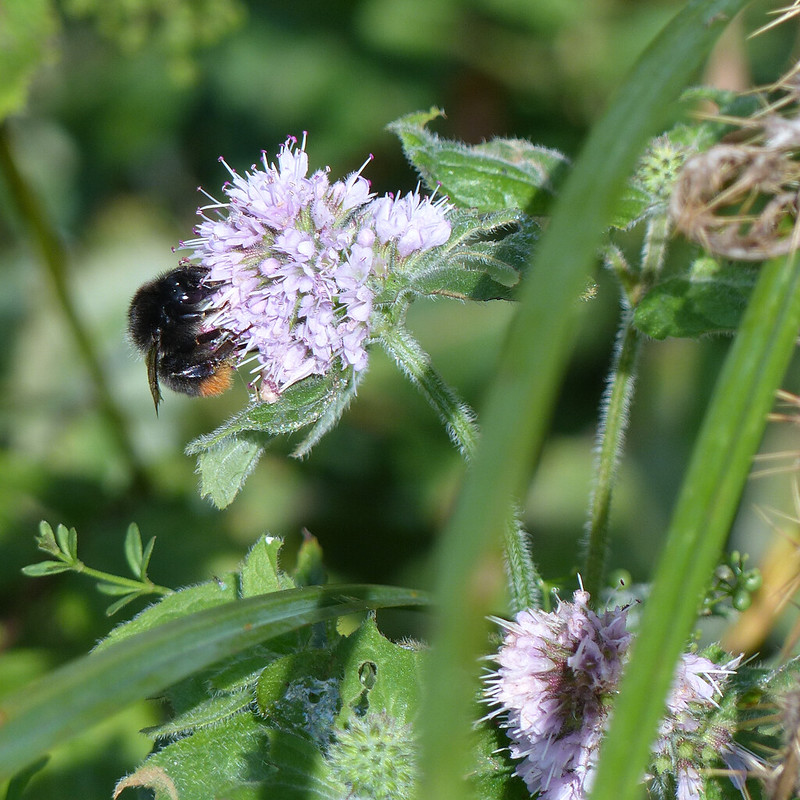
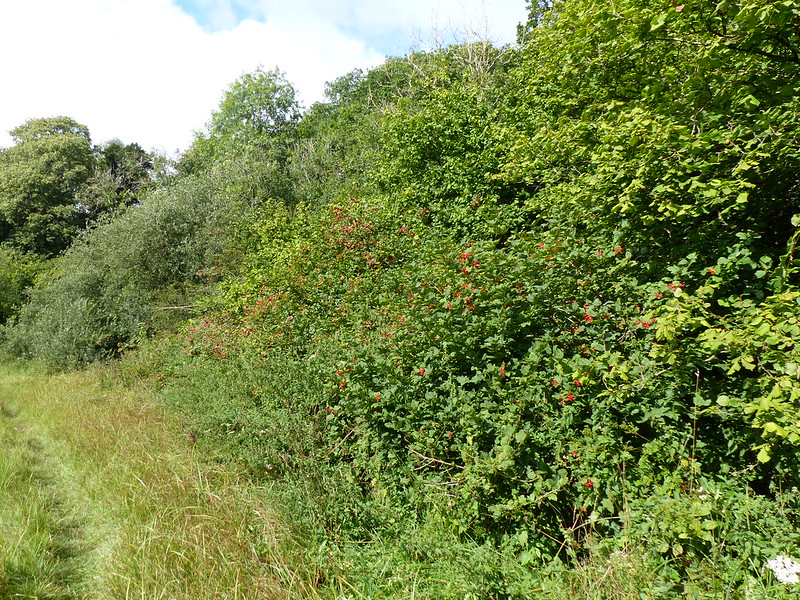
Up to this point I’d been slowly pacing around the meadow, snapping away. I hadn’t walked far at all. As I approached the large area of Guelder Rose in the hedge, my pulse quickened a little, whilst my pace slowed even more. This is an area in which I frequently spot dragonflies. And the area just beyond, of tall figworts and willowherbs, is possibly even more reliable.
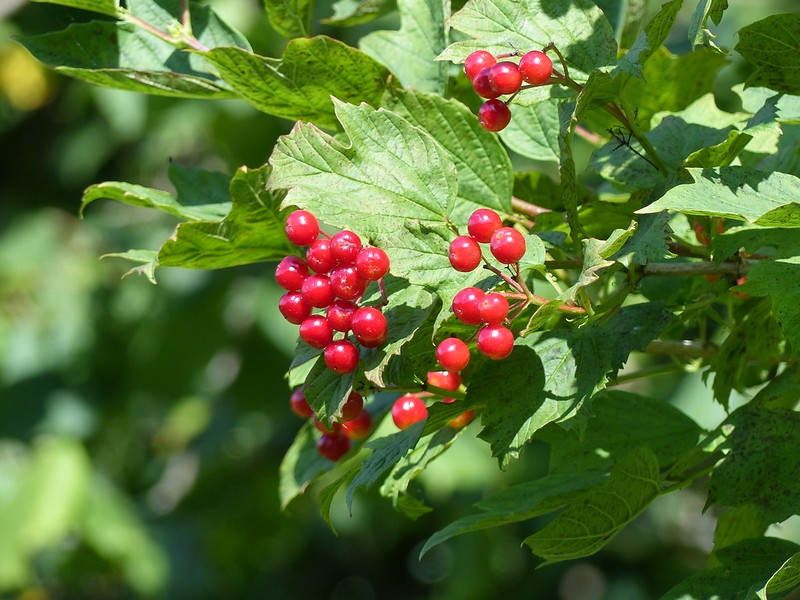
There were a few dragonflies patrolling the margin of the field. And a some Common Darters resting on leaves quite high in hedge, making them difficult to photograph from below. But then…result!
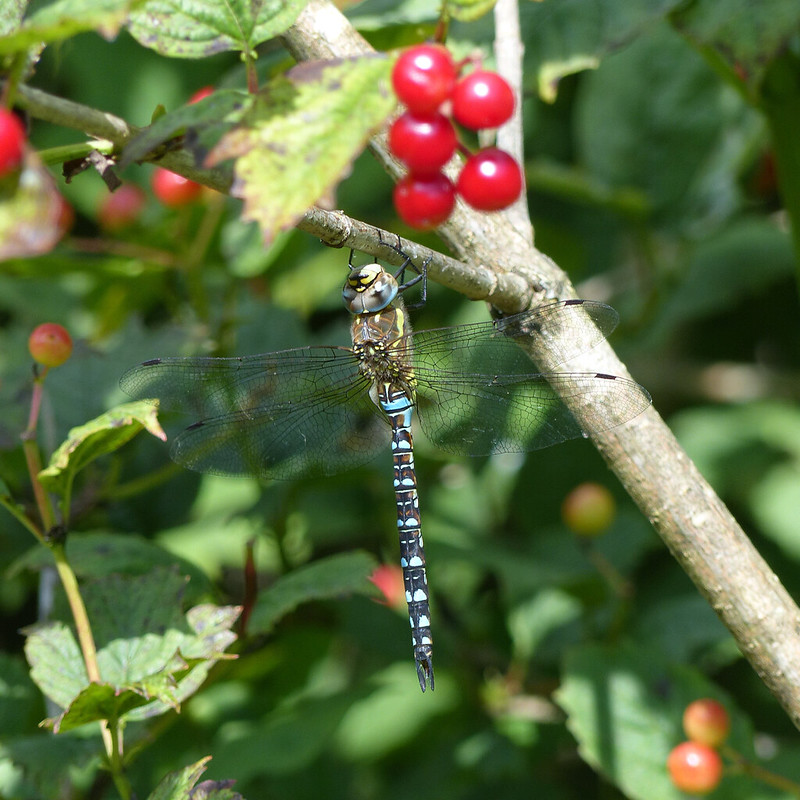
Sometimes hawkers visit our garden, but it’s rare that I spot them when they aren’t in motion, hunting.
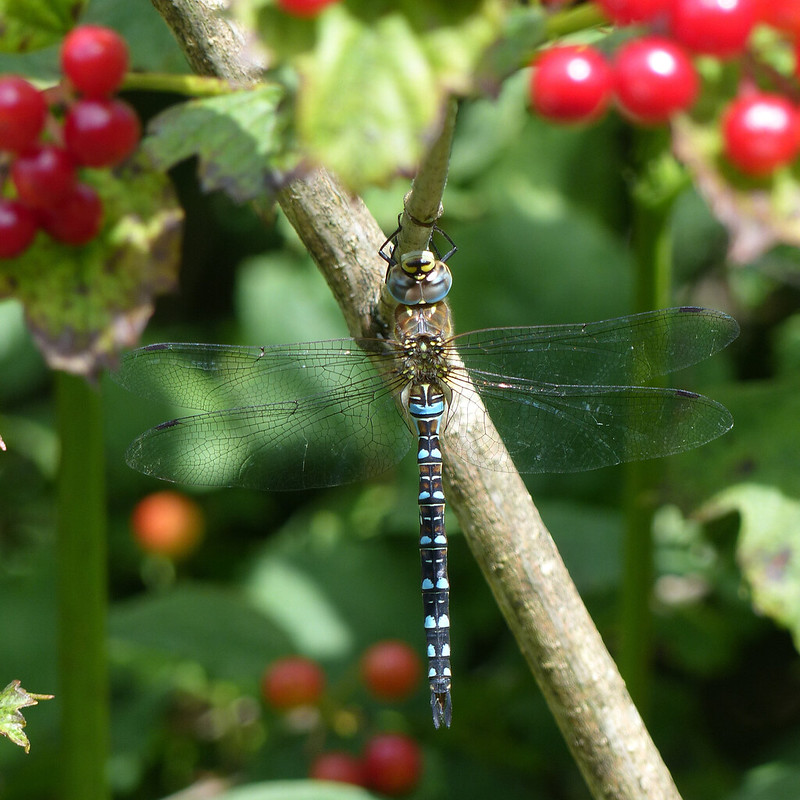
An absolutely stunning creature.
A little further along…
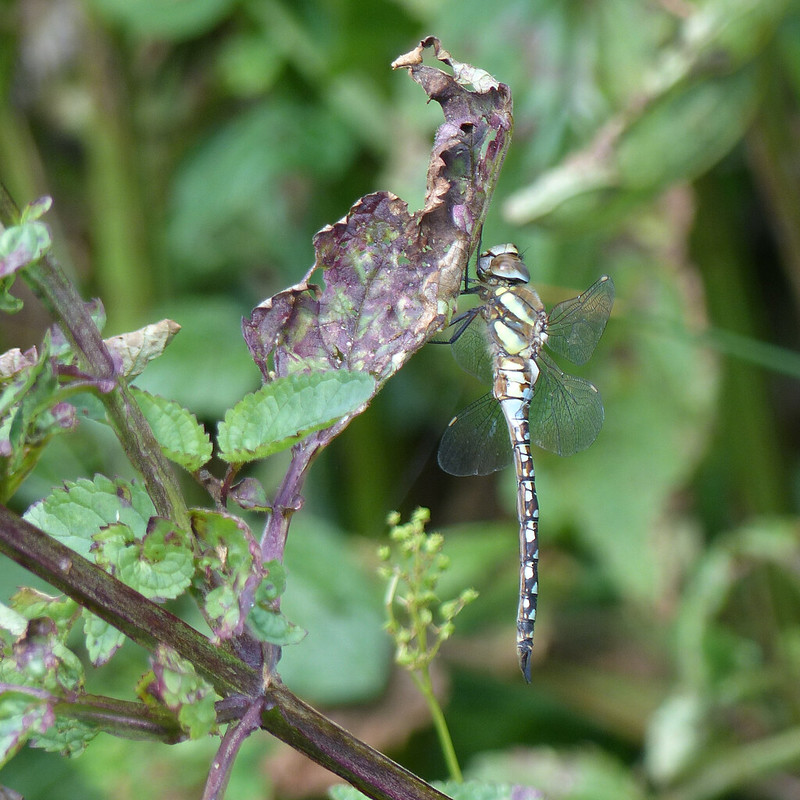


Our friend P has hives in Hagg Wood, not too far away. Minty honey anyone?

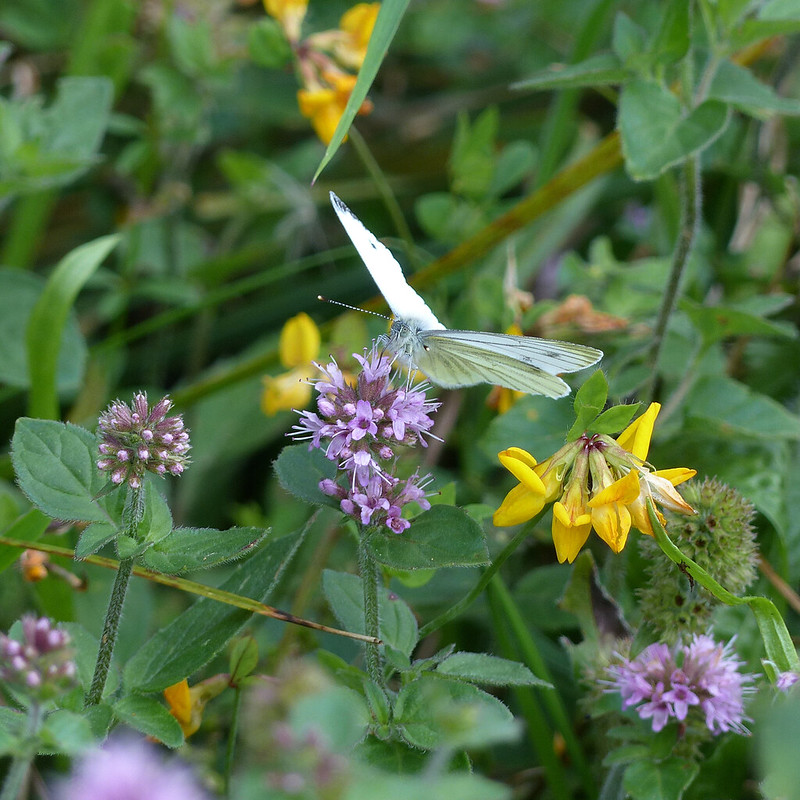
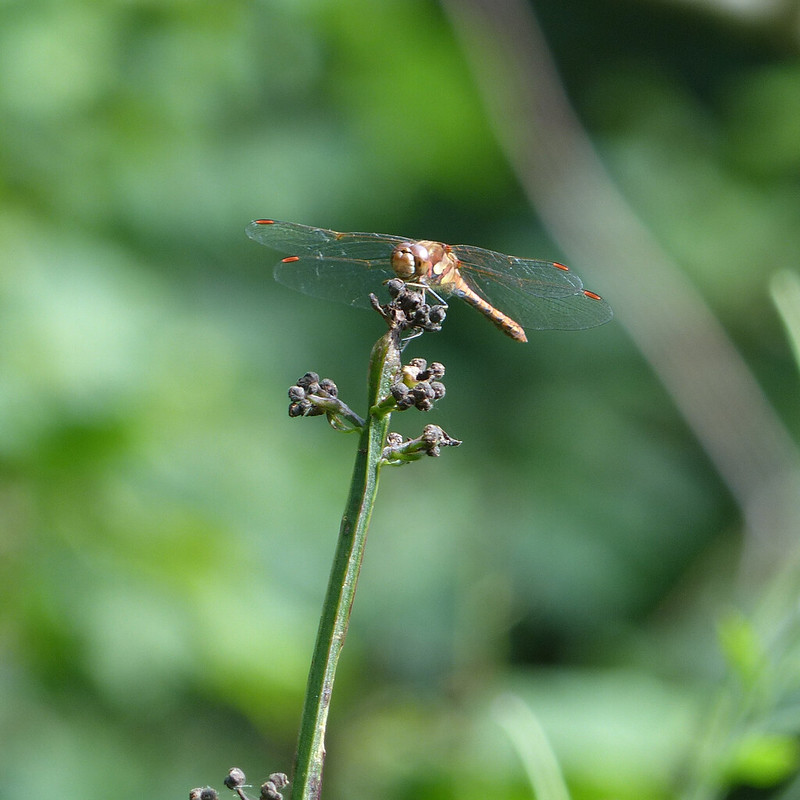
Views from the walk home…
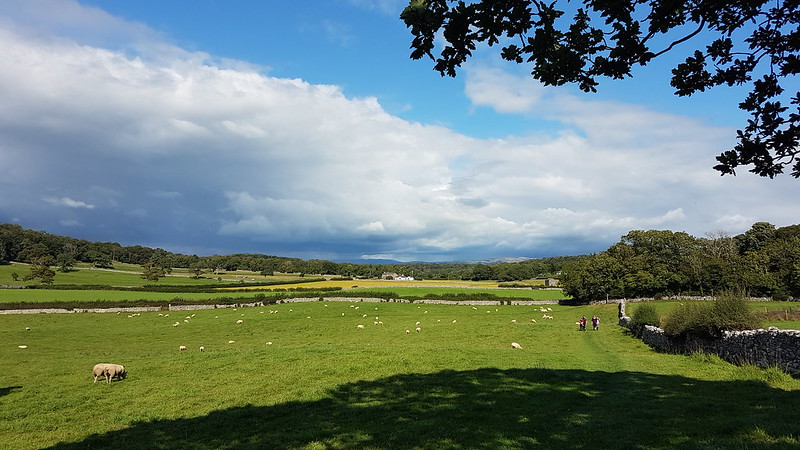
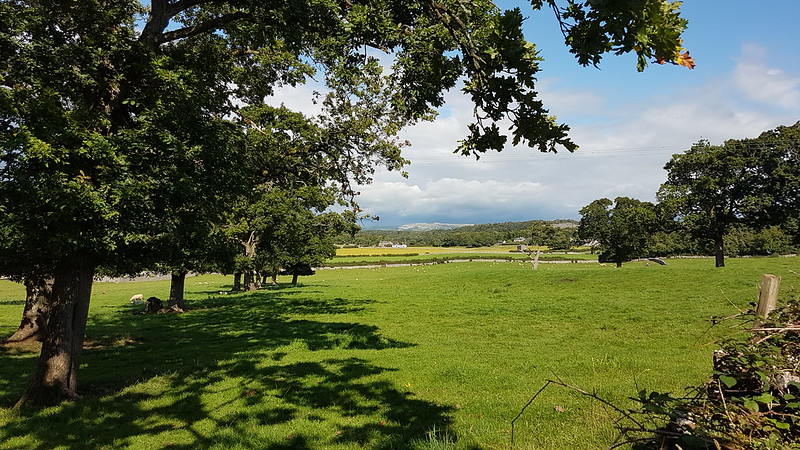
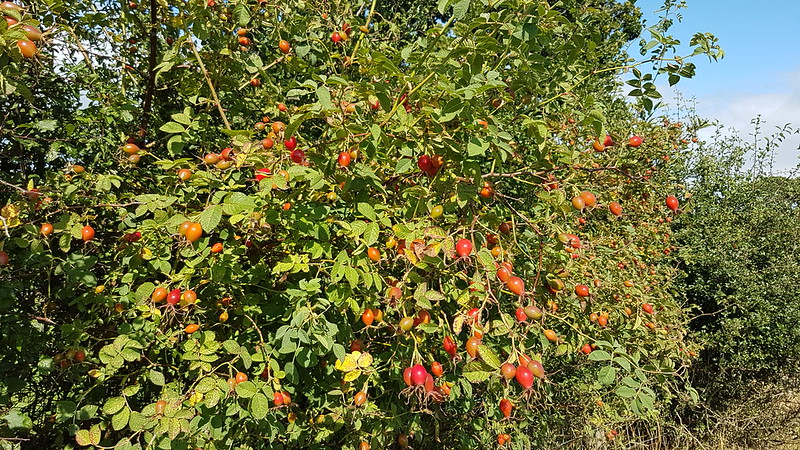
Well, I’ve enjoyed choosing this selection of photos from the hundreds I took that day. I hope you did too. I don’t know why I didn’t spend more time mooching around al Lambert’s Meadow last summer. I’m looking forward to some brighter weather already.